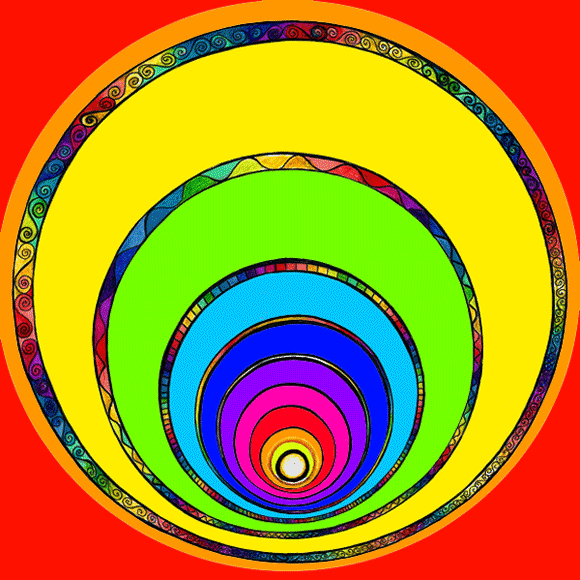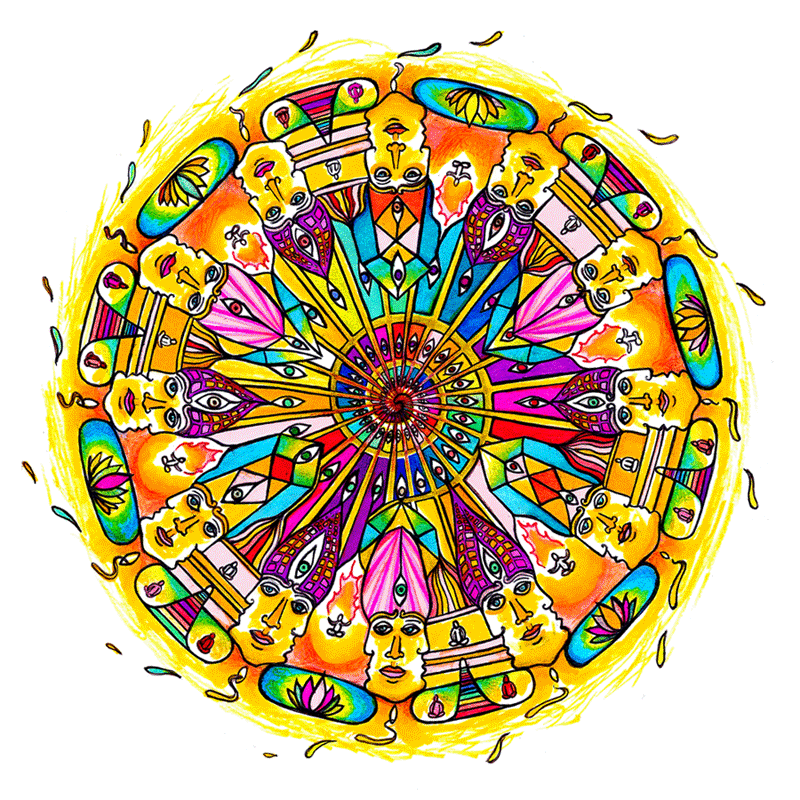Wheelchair accessible. 4’x8′
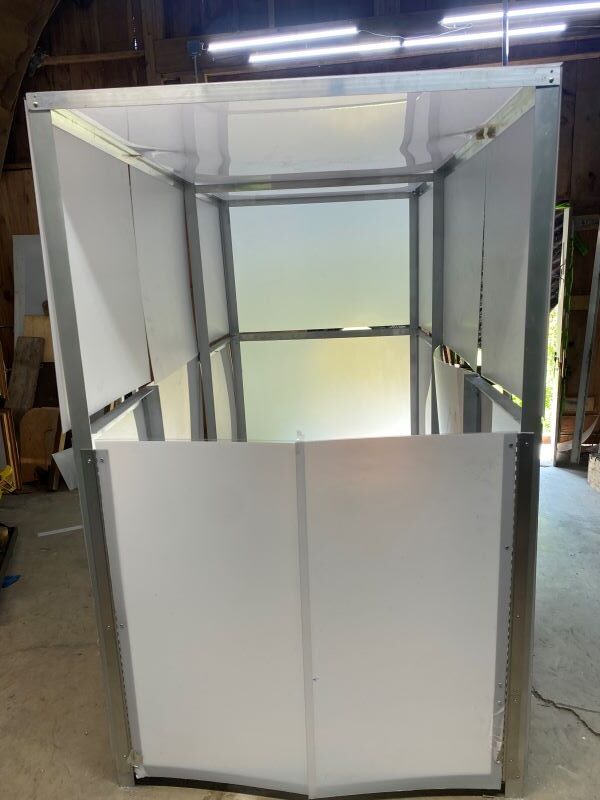















The CAT is a prototype developed by A Movement Founder, Steve Stollman, showcasing innovative ways to reconfigure and reimagine pedicabs to maximize their potential. Designed to inspire, The CAT offers a glimpse into how local creators can adapt pedicabs to meet specific community needs. The project encourages a rethinking of human-powered vehicles, highlighting their adaptability, low environmental impact, and potential for positive social impact.
The CAT project exemplifies the kinds of innovative solutions A Movement hopes to see from members around the world, each addressing unique transportation and sustainability challenges in their communities. It is an example of what’s possible through collaboration, creativity, and sustainable design.
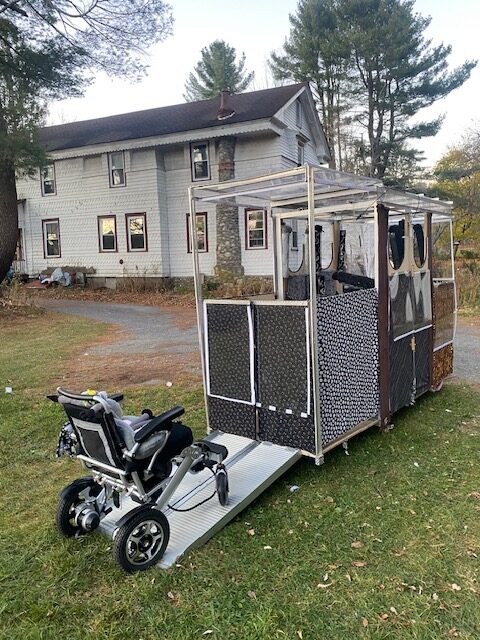
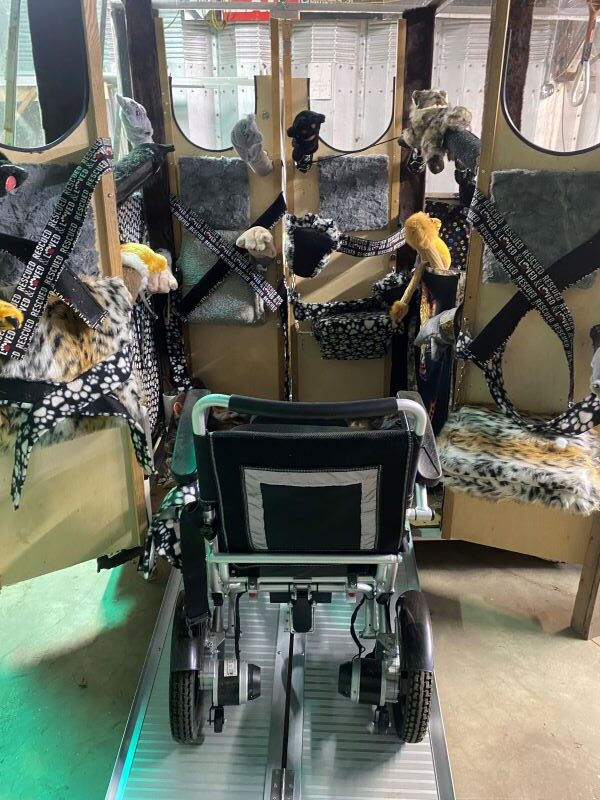
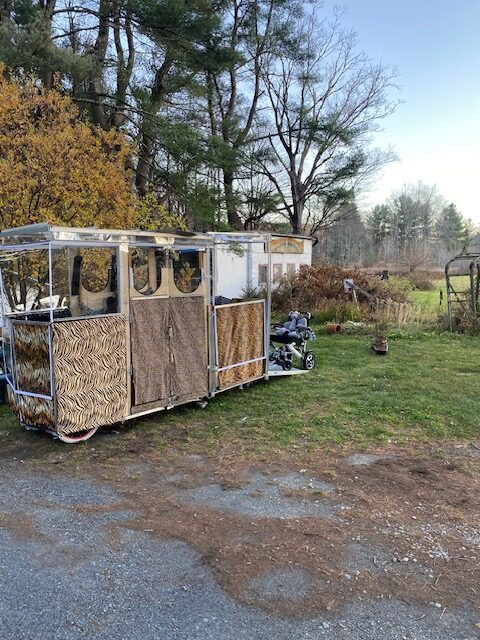
was constructed in order to demonstrate some of the ways in which “Pedicabs” can be re-configured, maybe even re-conceptualized, in order to make full use their potential. They are now operating in many other urban spaces, in countries across the world. In some, they are already being converted to electric operation en masse, by law, in order to help improve the breathable air. Attention to their siblings, cargo and delivery cycles, is expanding exponentially, with next hour/same day/next day service the rule now. It is time to think about this subject seriously, rather than dismissing it as a bit of strange overpriced, nostalgia.
The CAT is:
Only 40” wide, (it might like to be 48” to better accommodate side-loading wheelchairs), The city permits pedicabs to be 55” wide
Seven feet long, with an additional 40” for the foldable extension, which can provide for a second wheelchair or cargo use
Seven feet tall, in order to enable a 6’+ tall person to stand inside comfortably and provide some space for ancillary equipment
Depending on weather, is surrounded by clear polycarbonate windows, that can be folded away when not in use.
In order to maximize capacity, conserve space and provide for different postures, standing/leaning is possible and safe with restraints
It is steered with a tiller, and pedals provide some power, as well as controlling the speed, which maxes out at 15 MPH.
The roof is covered with solar panels, that can produce up to a third of the energy needed to move the vehicle during the day
The underside of the vehicle contains spaces for a number of re-chargeable batteries which can be charged in place or changed out
There will be a variety of services offered, Wi-Fi, device charging, telephone connecting, some now, some later
Operators of vehicles need to be very familiar with their territory and can profit substantially by providing job, space, and other help
Ideally there can be regular routes for vehicles, with ties to all local merchants and cultural and educational resources
Can serve on-call customer rides, wheelchairs, neighborhood and many other tours, cargo and freight, group rides
Wheelchairs can load from either side, the sidewalk, or from the back with a movable ramp to serve all openings
There needs to be room for up to 8 passengers in such a conveyance because sometimes there is that much need to fulfill
It’s called the CAT, because felines are some of the most interesting, engaging, loving, ferocious, and ubiquitous fellow mammals
Also beautiful, puzzling, graceful, proud, individual, soft, as hard to understand as they are to dismiss, not unlike us, planet-mates
Leaping and pouncing, curling up and stretching out, demanding and self-possessed, mysterious and predictable, like us.
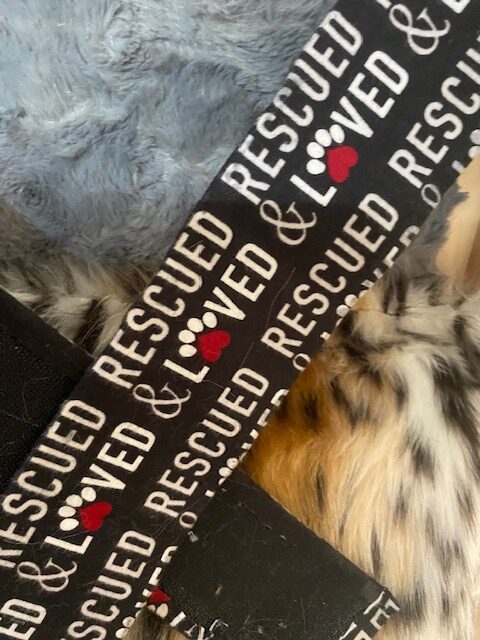
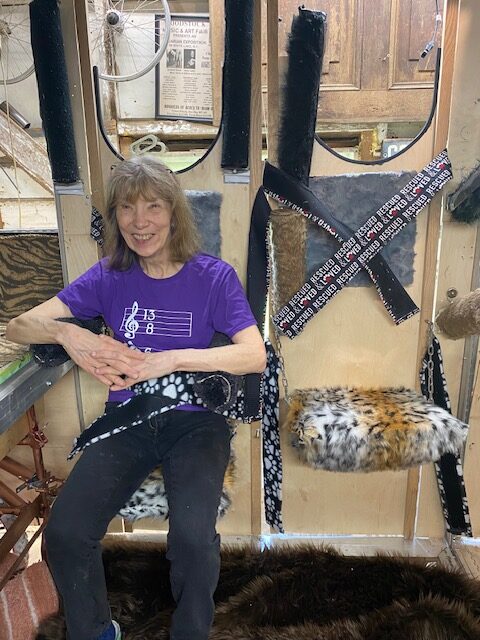
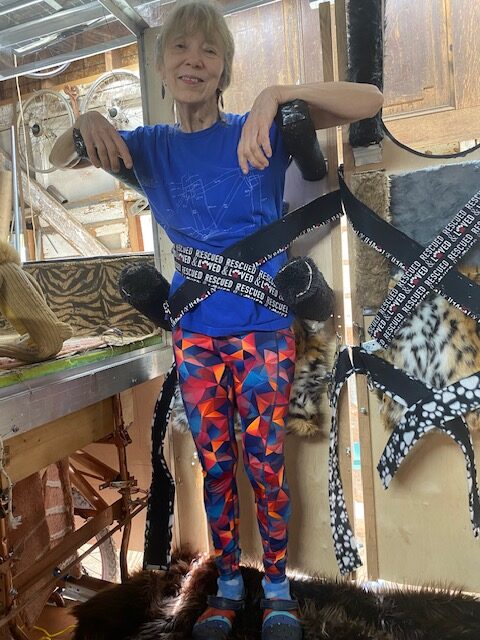
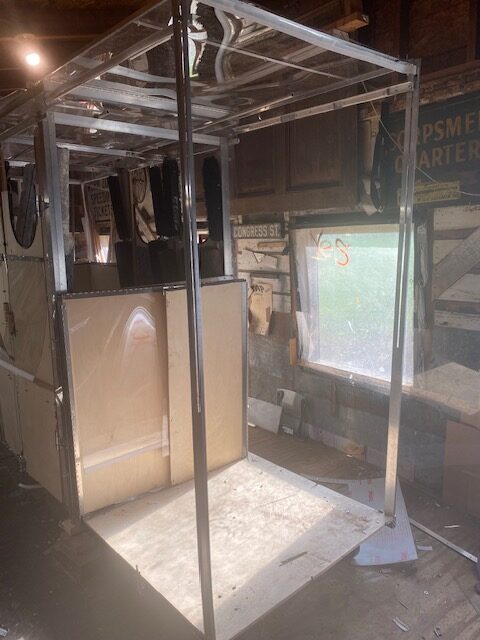
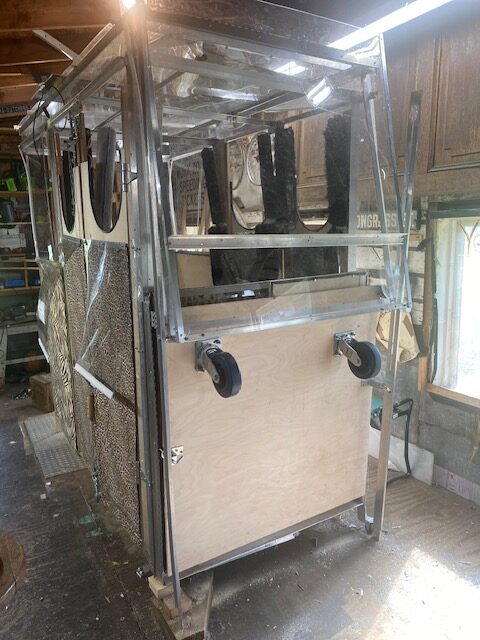
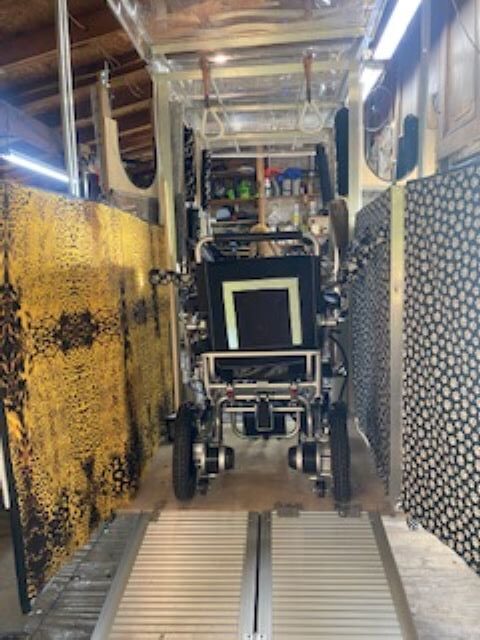
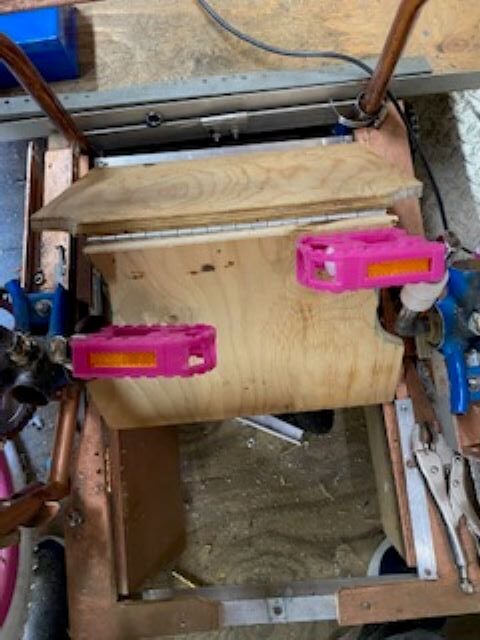
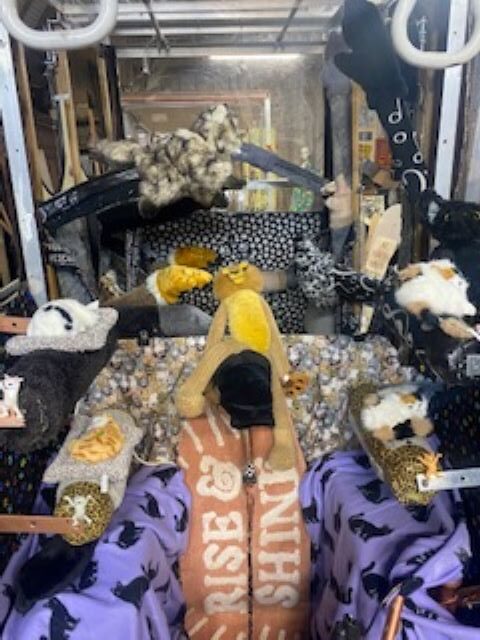
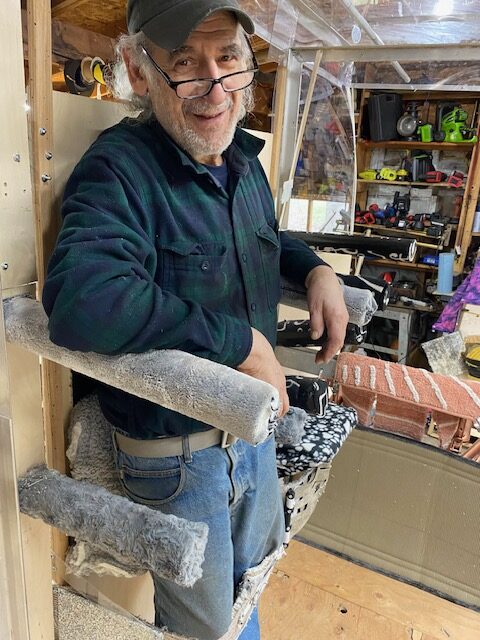
capable of carrying 4 passengers or a wheelchair. It can be open to the air, like a bike, or protected against bad weather by clear polycarbonate panels. Users can sit or stand/lean on comfortable cushions while resting their arms on padded rests. All of this easily folds away onto the wall, leaving the full ADA-required 32” x 48” to accommodate a wheelchair when called for.
It is expected that this vehicle would serve many purposes. It can be a conventional pedicab and provide transport to locals, visitors, tourists, and others. It can provide an alternative method of moving people in wheelchairs. It could also move goods and act as a cargo vehicle, allowing baby carriages and walkers to travel within the city more easily. There is an accessible ramp anchored within the back door, which facilitates entry for those at the rear, and front passengers can easily slip in and out through the swinging doors on the front enclosure.
This is built on a 3/4” Baltic birch plywood base, with a solid wood and aluminum framework. Walls are 3/8” hardwood plywood. There is abrasion-resistant polycarbonate glazing and solid brass hardware throughout. There are two 12”, 48-volt, 1000-watt hub motors and a 20” unicycle to power the vehicle. The roof carries 400 watts of solar panels. Suspension is provided through padded fixtures, fat tires, shock absorbers, and springs.
A variety of services can be made available to all users; device-charging, wifi hotspots, places to rest food, drinks, and packages, sources of warm or cool air, music, or news reports. This is meant to be as comfortable as any vehicle but with a closer connection to the outside world, with numerous openings. The pilot is also provided with commodious surroundings, and the plastic canopy is hinged at the top and can be lifted to allow a freer air passage when desired. Operators and users fully share the environment.

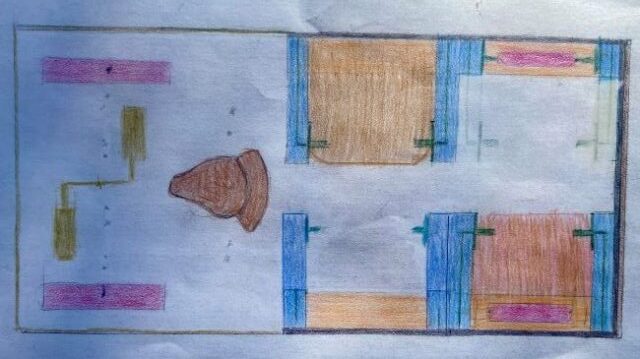
Similar to the Cat and Sociable, it also has seats and armrests that fold against the wall when not in use. A wheelchair or four passengers may travel in this tiny vehicle, and the operator is in a transparent shell.
There is a 3’ ramp that expands to 6’, with maximum light, comfort, and safety.
Hardwood plywood, aluminum, stainless steel and brass, abrasion-resistant polycarbonate, and solar panels. 500W 48V electric hub motors, lithium-ion batteries, 20” bicycle wheels, and electronic controls.
NYC-legal pedicab (and potential cargo-carrying) vehicle. Ten feet long, four feet wide, and six feet tall. It can be partially or completely open to the weather or totally enclosed. Its low platform permits it to be both an ADA-legal wheelchair and a hand truck accessible, by a ramp, which can serve either sidewalk or the street. There are two potential pedalers and room for four or more additional passengers. The shell is made of clear, weather-protecting, polycarbonate. There are 500 watts of solar panels on the roof. The comfort and safety of passengers are paramount. It can transform into a stationary source of local news at intervals.
I was one of the two founders, over 25 years ago, of this industry in NYC. Unfortunately, rather than an important, new form of transportation, pedicabs have come to exist, virtually entirely, as an expensive way to experience Central Park. The potential of this activity to provide the public with a needed new means of getting around the city, with huge environmental benefits and positive effects on healthfulness, was lost when the taxi industry successfully lobbied to limit their impact on their industry. Many regulations need to be brought up to date. For instance, If they were to be permitted to be just a few feet longer than the current 10’, they could accommodate as many as two handfuls of people and ply regular routes, at a modest pace, as a supplement to the current options. They could be made unique, by artists and craftspeople from right in the City and its environs, even supplemented by creative efforts from around the country and the world. (Please take a look at the World’s Fair page that is adjacent to this one, as one possible way to further this idea.)
The very substantial, independent, and valuable employment created here can be in the form of individual entrepreneurs, establishing their presences, within geographically-defined communities, through their regular routes. This could be seen as a version of the traditional sidewalk newsstand, a conspicuous local statement about being a worker in, and therefore as a citizen of, a defined community. By becoming, perhaps the most knowledgeable person, about all of the business events and activities along their route, through the simultaneous posting of the very real and also virtual advertising, of real estate, employment, eating and entertainment and services, from legal to physical therapy, serious income, and status too, can be earned. Eventually, transport could be free (with tips allowed of course) if other income opportunities prove sufficient.
I call this design the Half because the rest of the story is still out there. It may be perfect in some ways to me, but it is not meant to supplant everything there and become the new standard. I hope it serves to do the opposite, a means to demonstrate the possibility of a wide range of the most different and exciting additions to the streetscape, while at the same time expanding fully accessible transportation options and helping to develop a quieter, cleaner, and more beautiful city.
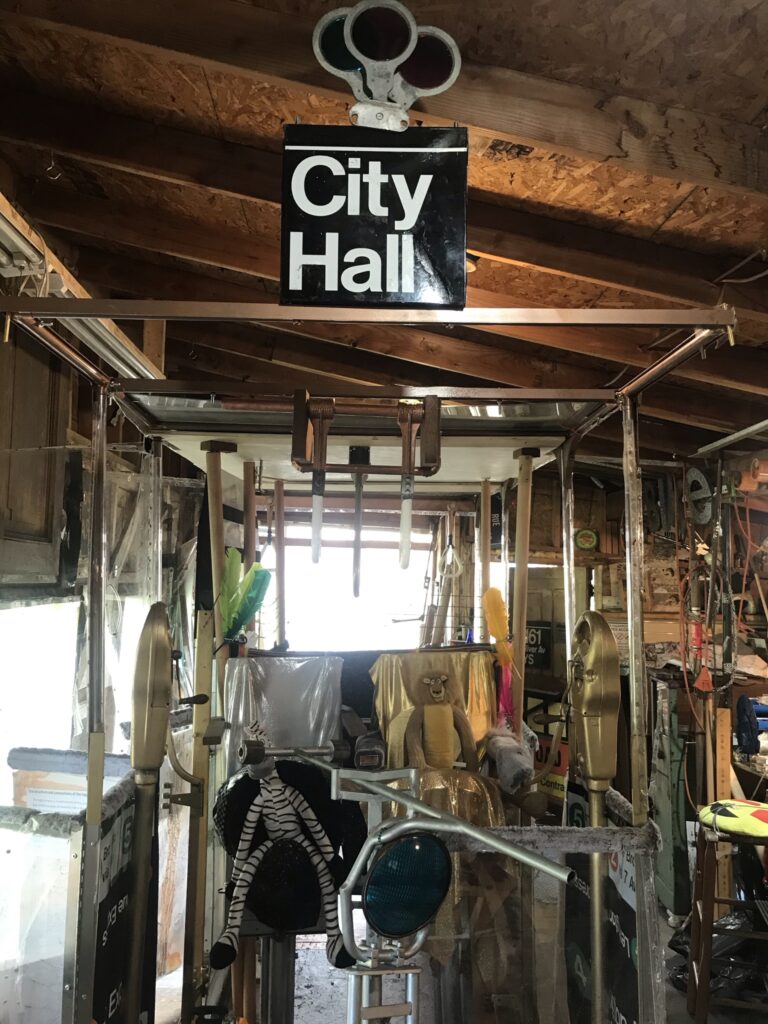
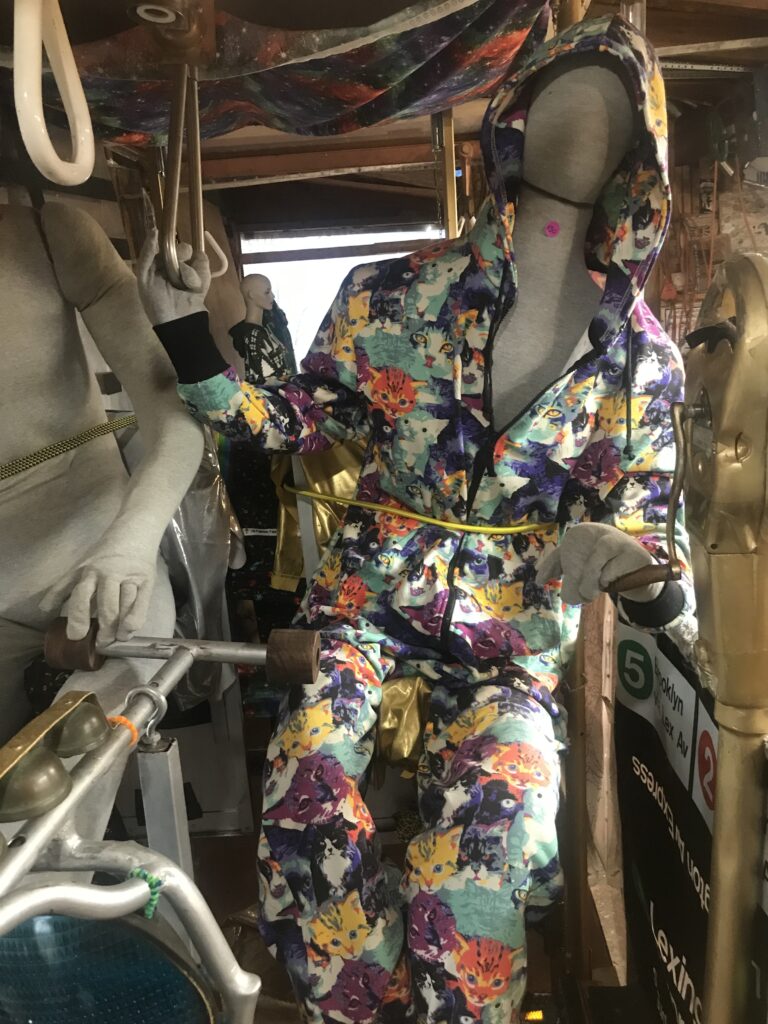
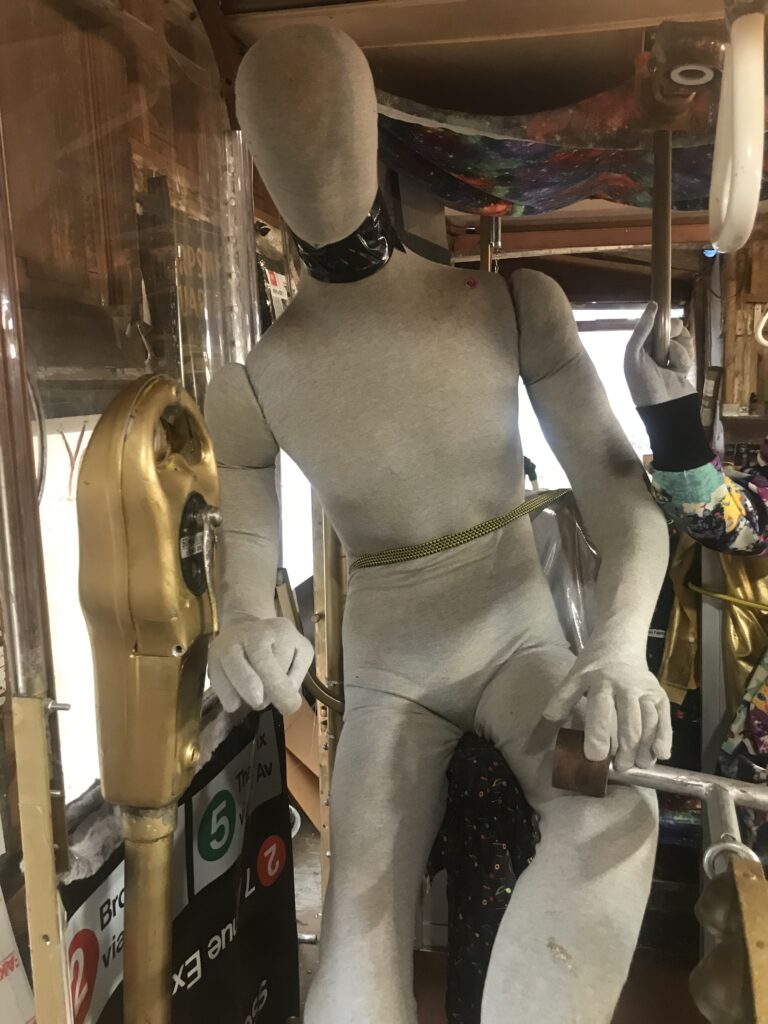
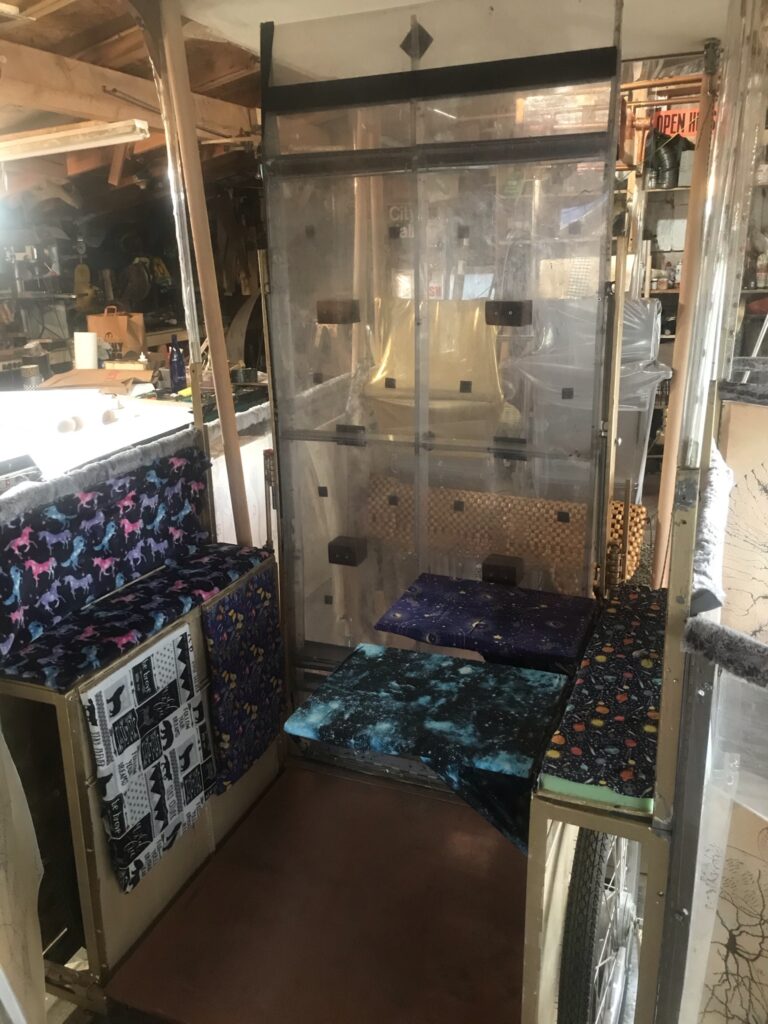
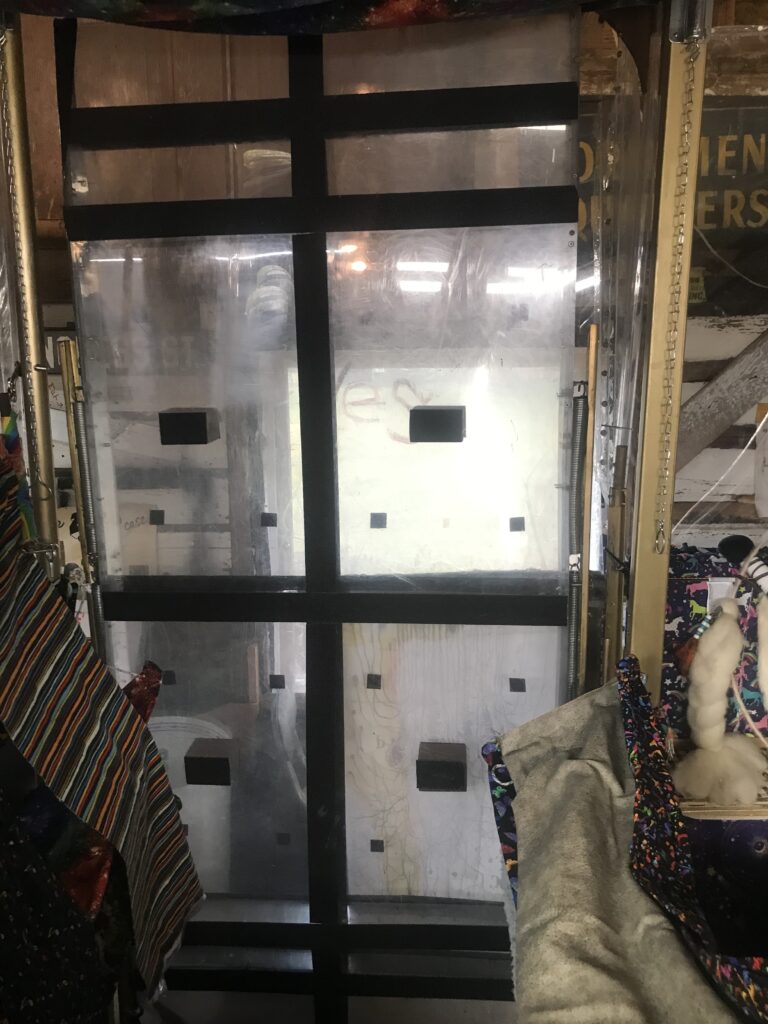
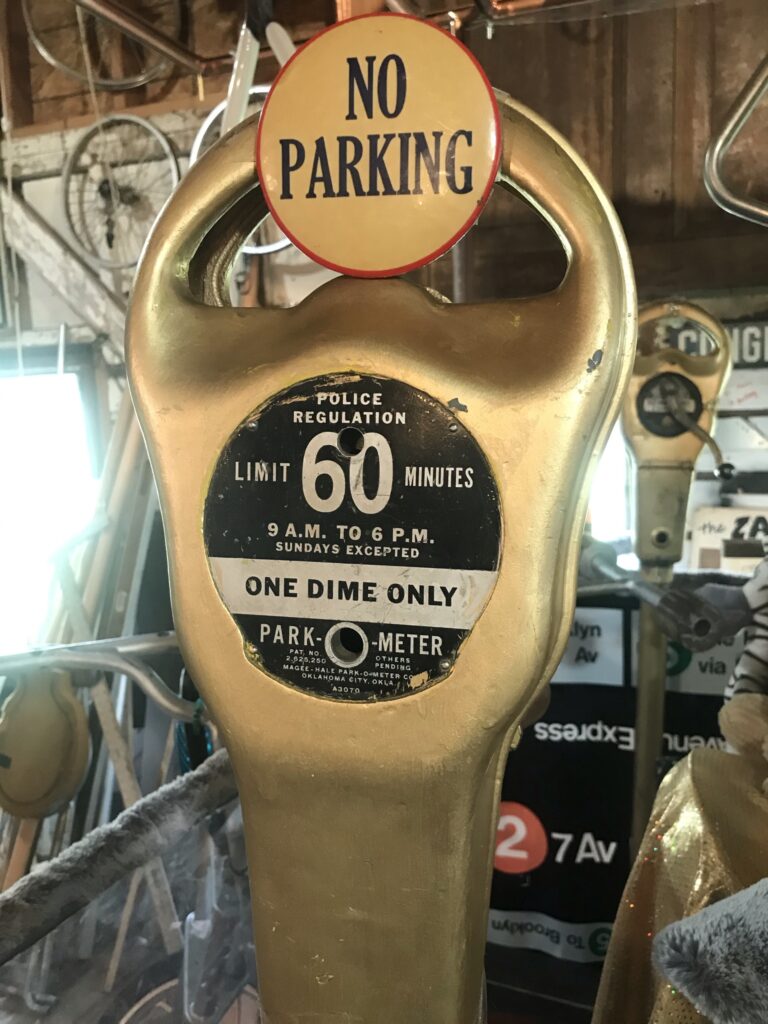
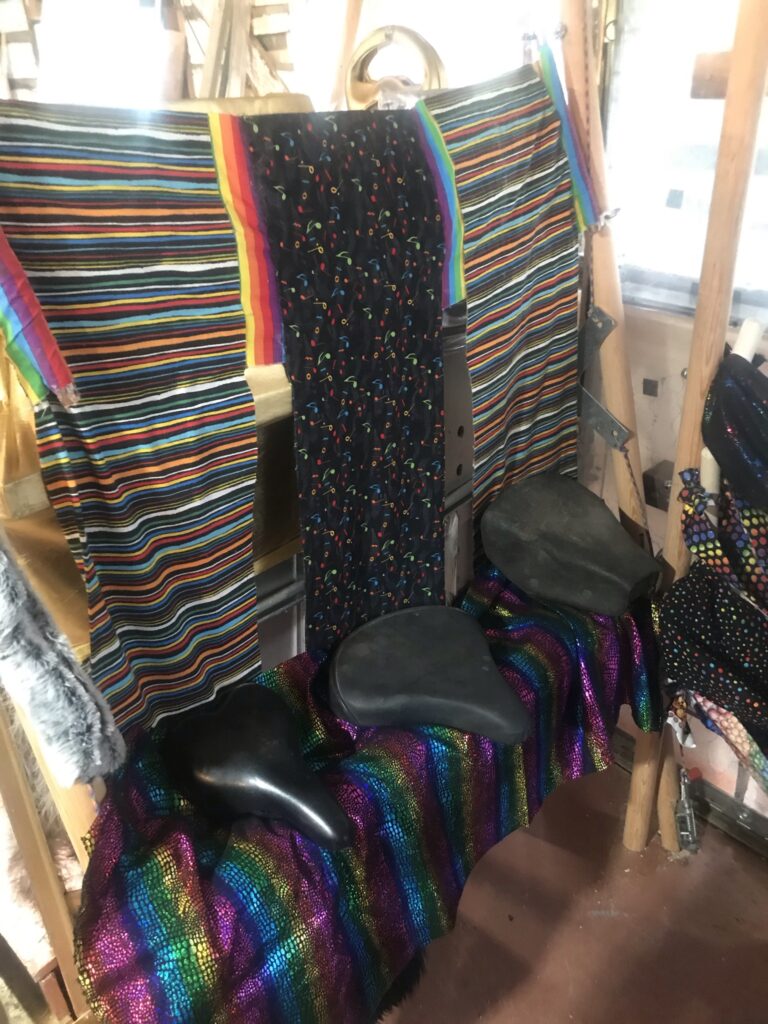
It can be wide open to the air or fully enclosed in a folding polycarbonate shell. It may carry one, two, or three people. One drive wheel is an anchored-in-place, pedal-able unicycle, the two others are hub-motor equipped, electric-powered wheels. The vehicle can travel, facing either the three or the six-foot side, either tandem-style or the more sociable side-by-side. The seats, and wheels, all pivot and move, easily, to enable this to happen. Use in dense urban spaces is what is expected here, and at a maximum speed of 15-20 mph to ensure safe operation.
The wheels are all linked together so that when facing the six-foot side, with the pedaler steering, all the wheels turn together. When facing the 3’ side, the pedaler steers and the back wheels go straight, as in all trikes. Batteries are stored under the vehicle, which can be charged in place or slide out like a drawer and be rapidly replaced. A solar panel acts as a roof as well as a source of power. When an opening above is preferred it can be temporarily stored, with the rest of the body, alongside the wall. The hinges are aluminum, covered by colorful fabric. Closings are Velcro and magnets. Seats are well cushioned and sprung, mounted on tubes that are anchored to the floor. They can be adjusted for height and face any direction, as well as be tilted, to allow for the most comfortable, supported, standing/leaning posture, or made level. Drive wheels are under polycarbonate covers, both for passenger safety and comfort and to maximize weatherization when enclosed. These structures are part of the wheels’ “forks”, turn with them and help stabilize them.
Current regulations in New York State demand that electric bikes and trikes be no wider than 36”, thus this design. Careful study suggests a limit of 48” wide, or even up to 72”, with a corresponding stretching of the length to 10’ or so, will eventually be regarded, in crowded cities, as optimal for many purposes. For example, this would permit wheelchairs to be transported properly on such a vehicle, or several passengers or a healthy load of cargo to be accommodated safely and comfortably. The OH is meant to test the absolute minimum of space and materials that must be required to begin to accomplish these tasks. There are considerable benefits to exploring this, with the lowest level of consumption and simplicity of design, as one answer that offers a wide variety of rewards. It is not necessary to consider this as the only or best answer to this challenge, but it is, rather, a suggested first step in the right direction.
There is a 3/4” plywood floor, to which are attached aluminum poles, and steel angles. Poles anchor additional aluminum tubes, keeping seats and wheels in their proper places. Has appropriate lights, mirrors, and all other necessary equipment. The polycarbonate cover can be deployed partly, as desired, and the entire shell folds flat and can be stored alongside the back, This can be used as a personal vehicle, or for carrying passengers or cargo, as it is, without major modification. A full-scale working prototype is under construction.
Two 10″ hub motors and a unicycle:
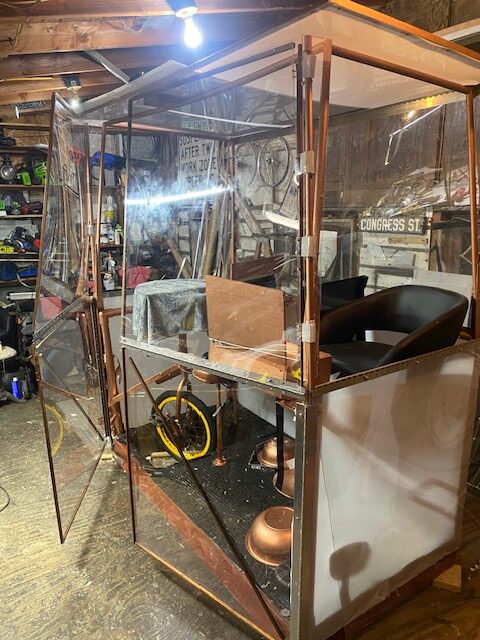
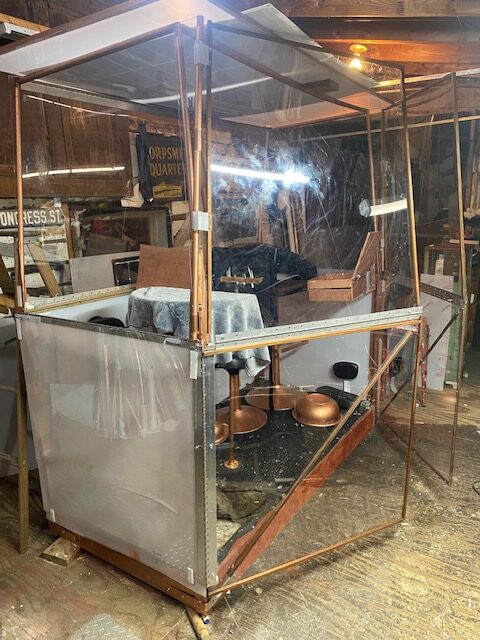
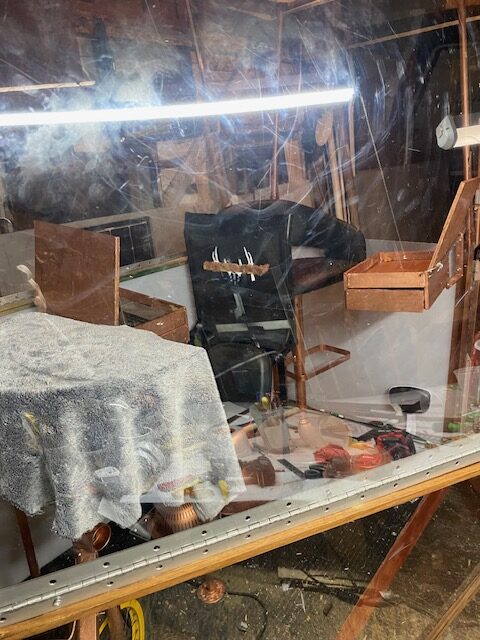
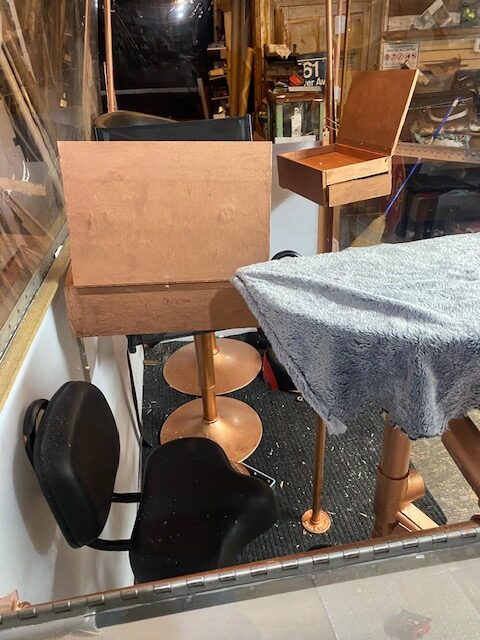
For all further information, please contact:
Email: StevenStollman@gmail.com
Tel.: 1 212 431 0600


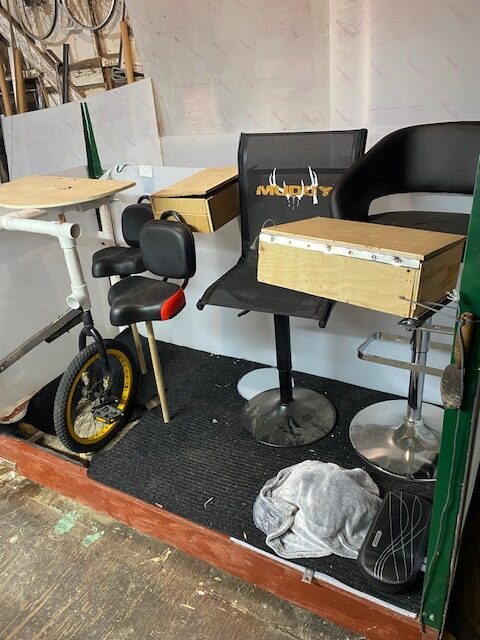
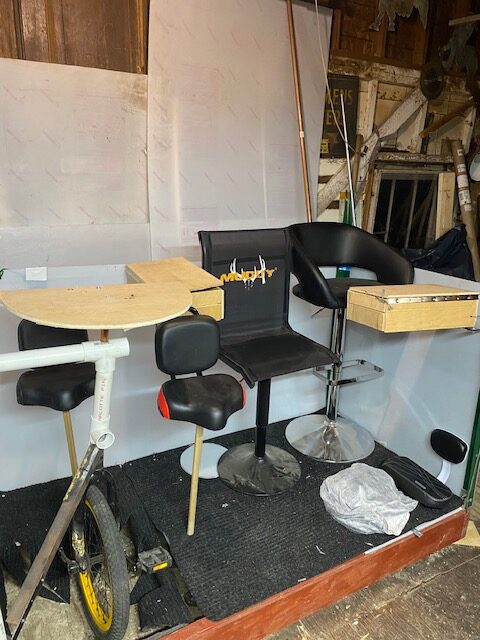
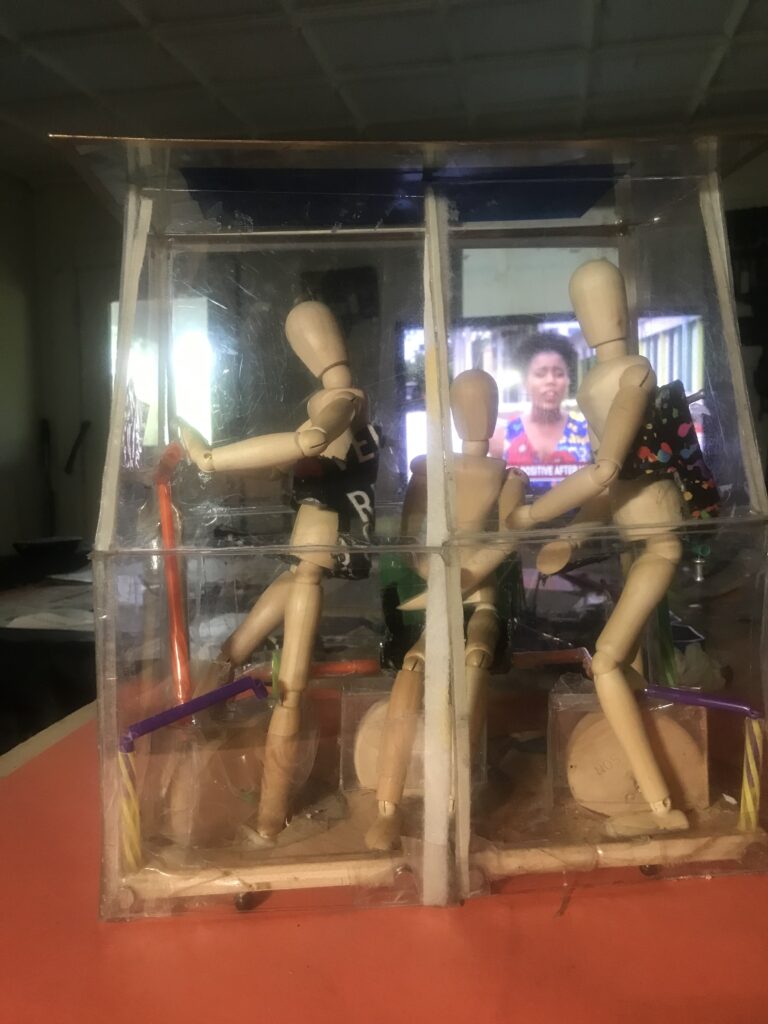
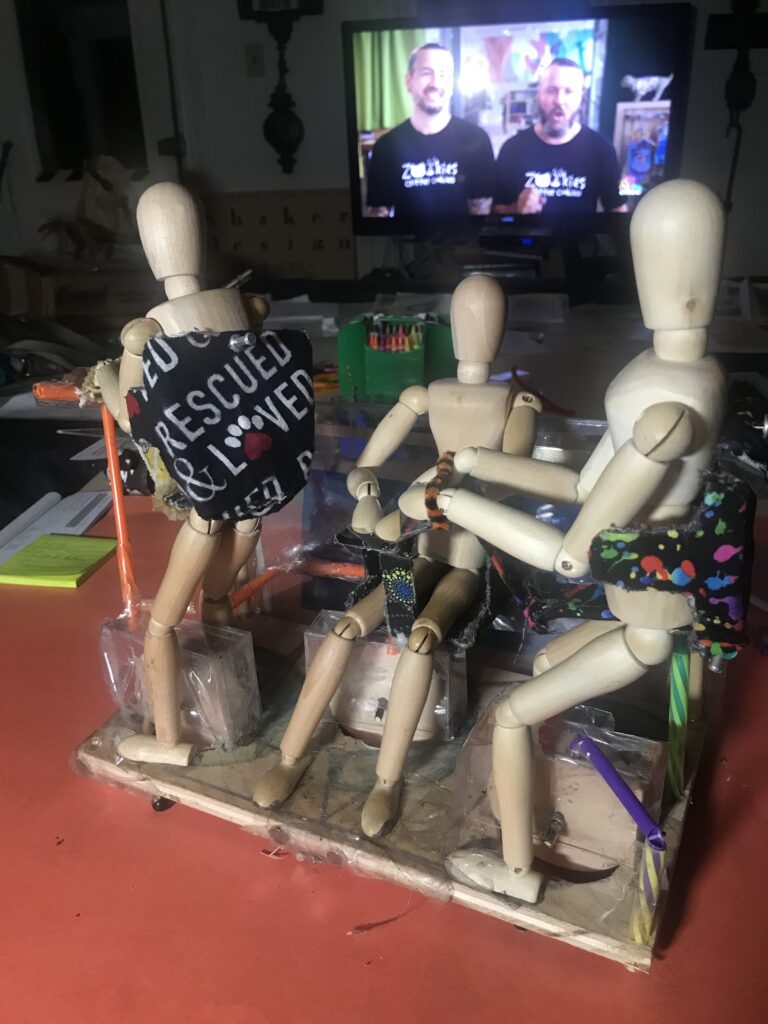
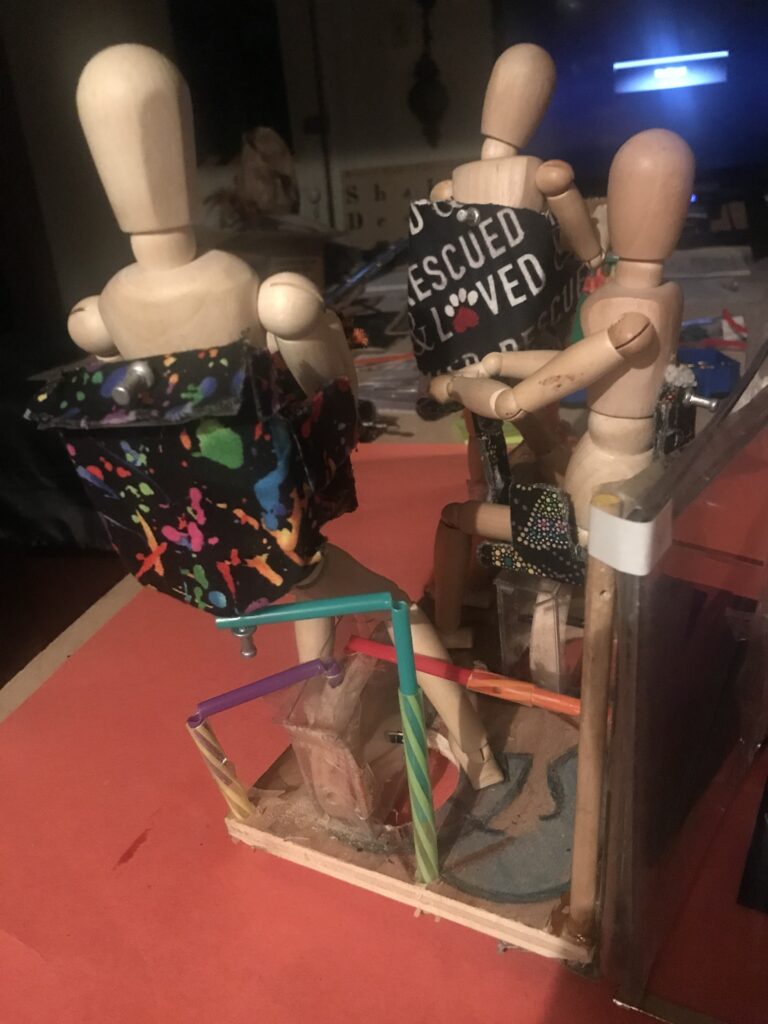
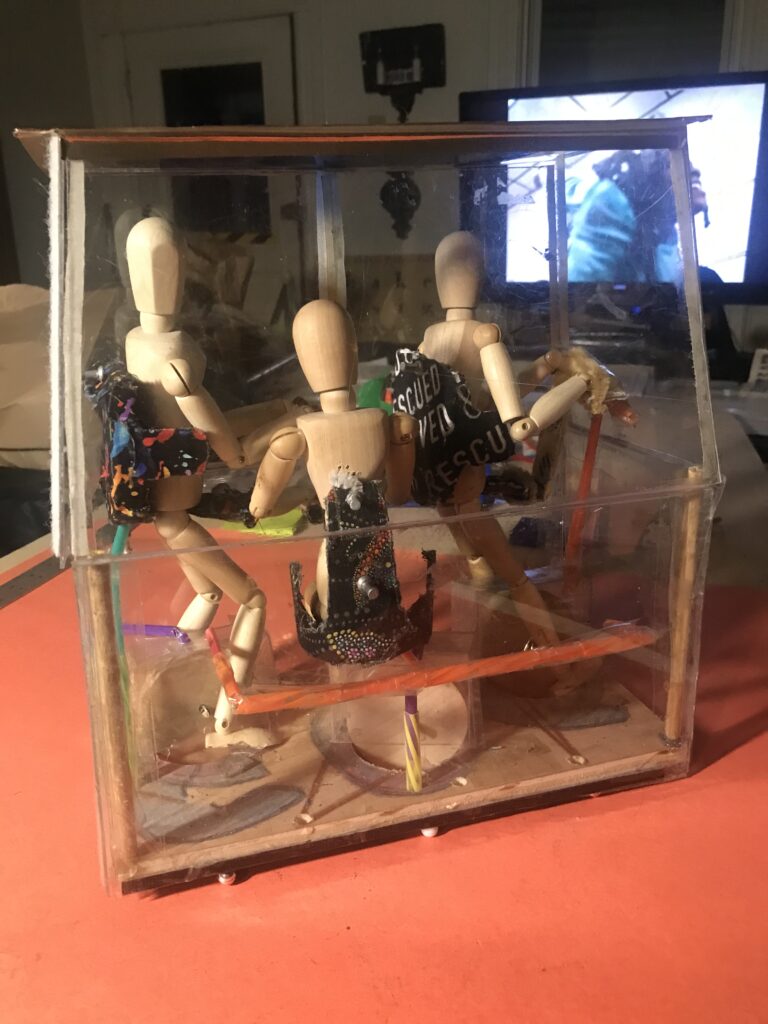
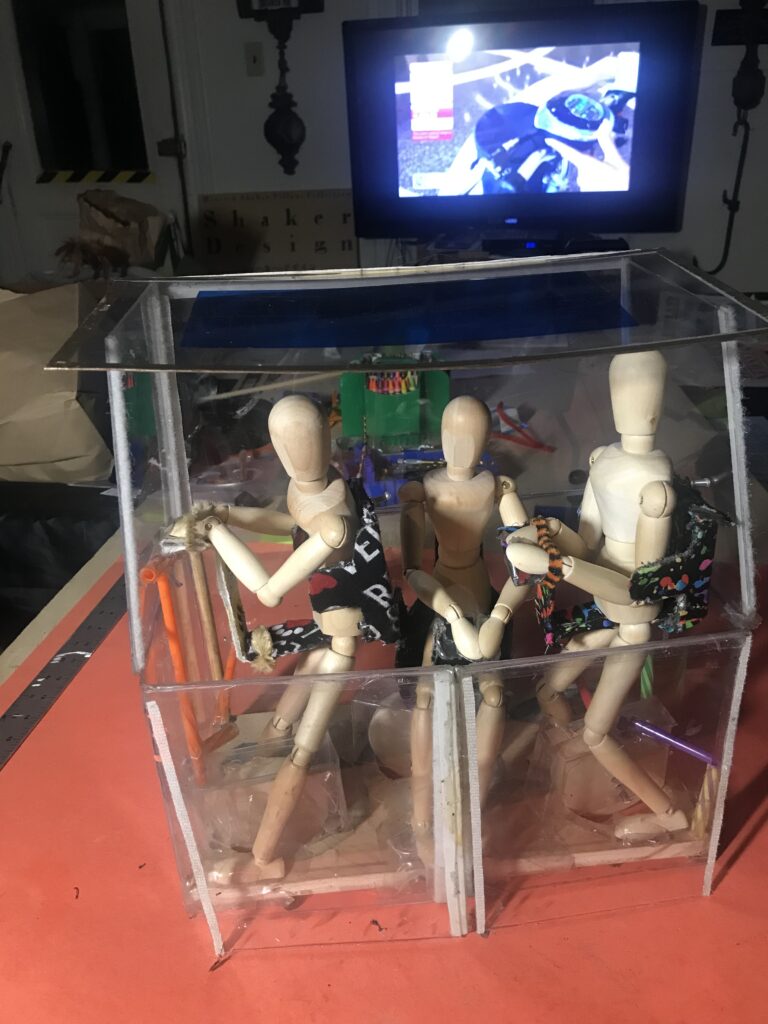
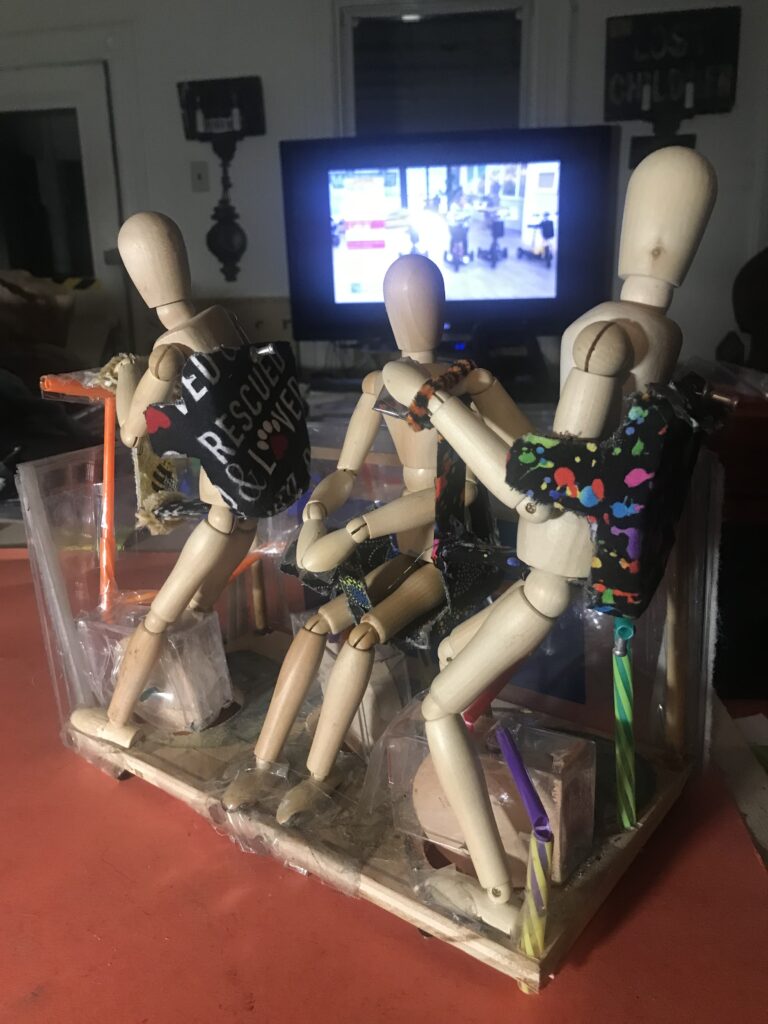
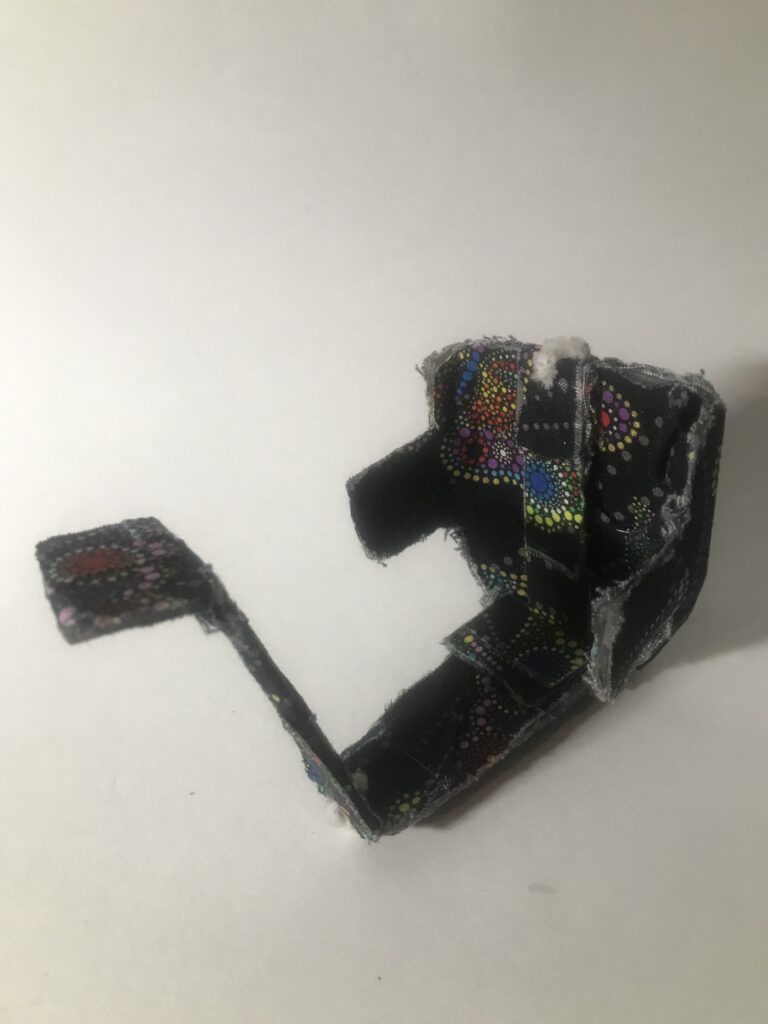
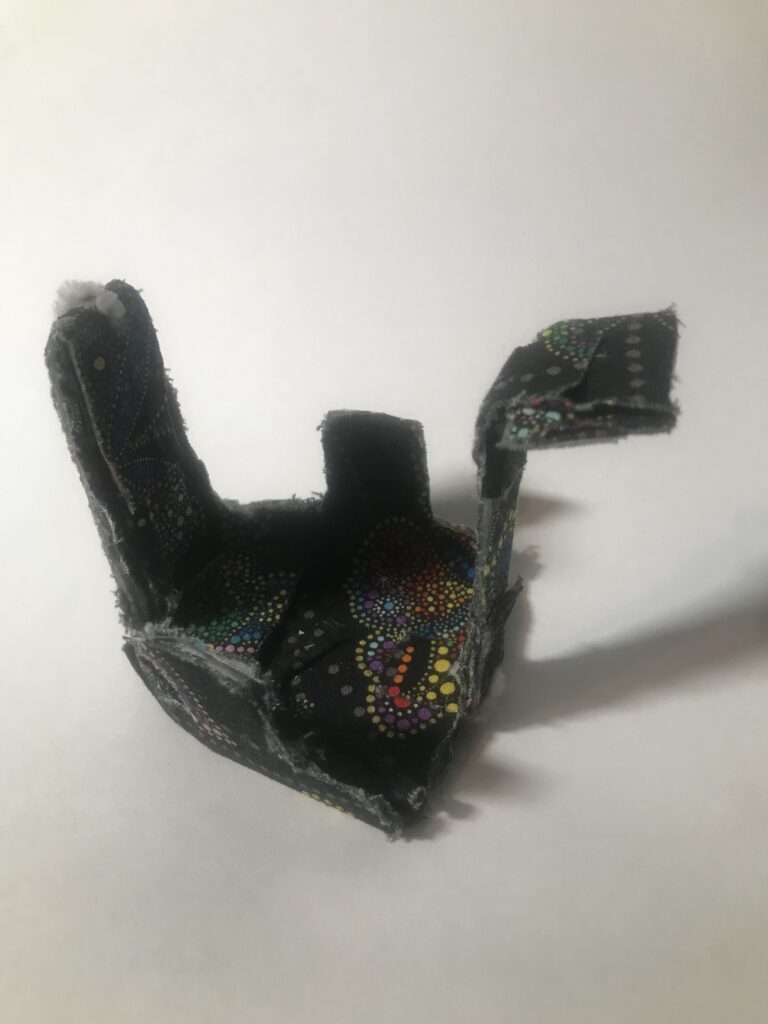
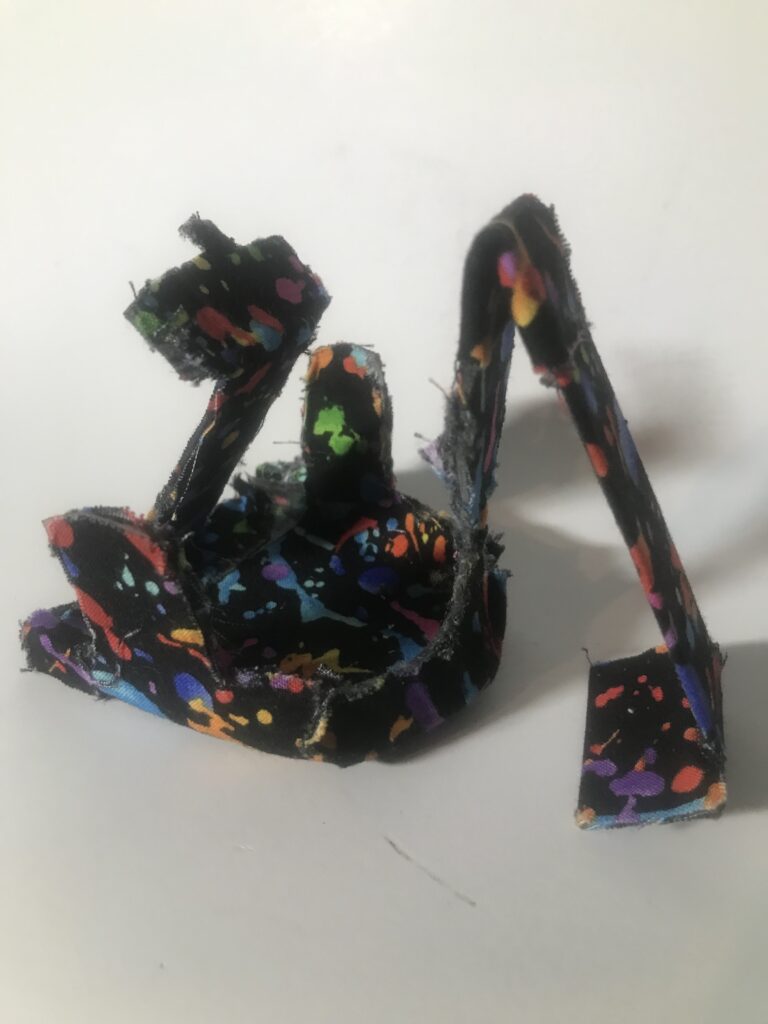

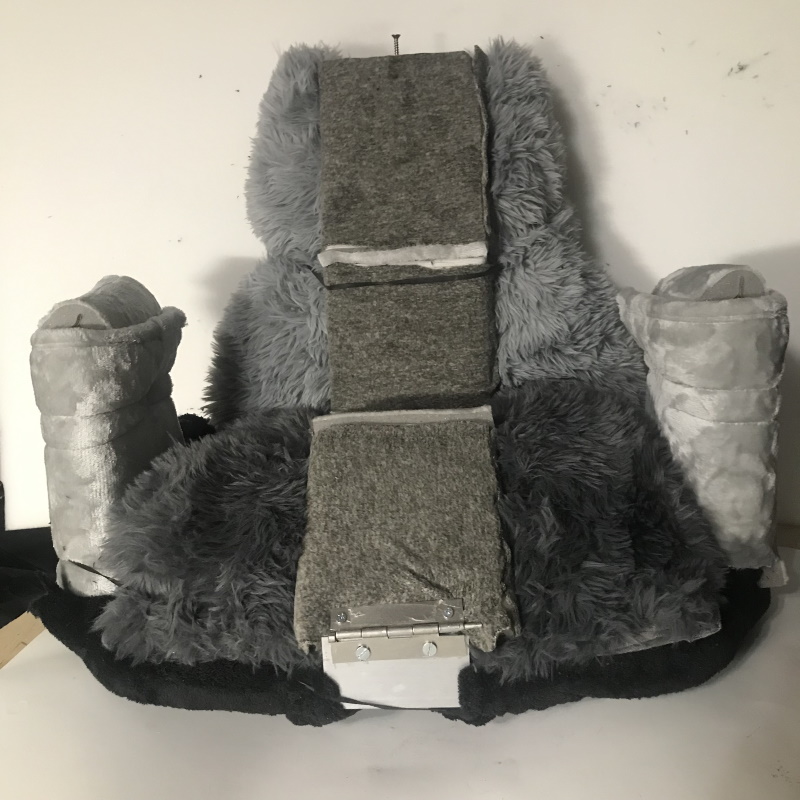
Each suggests a different approach to designing and deploying our lightest and most accommodating, slow-speed, urban vehicles.
Each provides for the users to determine how much of a cover is being provided for an otherwise almost completely open platform, depending on weather conditions and other factors such as the desire for quiet or privacy.
One has a capacity of up to nine people, the Other only three, and maybe personal, passenger, cargo, or multi-modal. The Half provides for wheelchairs and hand trucks. A version of the Other Half could also.
Most users will be provided with resting places that permit them to choose their posture, recumbent, sitting, leaning, or standing.
Foot and arm cranks will enable energy to be generated, and channeled, into the electrical system, to be used when needed.
They use the least material to accomplish several important tasks, durably, beautifully, economically, sustainedly, and creatively.
One element of this effort is to design for, and have a strong effect upon, over time, the way in which these devices are deployed and the conditions under which they are provided to their operators.
Financing these vehicles, in a manner that enables the eventual ownership of them to be provided to users, is a common feature of the Halves.
Their uniqueness can give local identity to these conveyances and, over time, making them unique through their design and decoration, can emphasize local history and the identity of current residents, can transform these objects into a new medium of expression, education, and needed direct communication.
All local economies can benefit from having a live local employment exchange, a listing of local spaces to be rented, or even sold, offers to donate things that are being discarded, music being played, public and private services available within the vicinity, etc. which also incorporates a digital element.
Since there are three 1/3 day shifts available for the Half, it is likely that there will be groups of two, three, or more different individuals attending to one route. A mechanism for resolving disputes and a system for ensuring equitable activity will be developed. Means of enabling this arrangement could help foster similar, small group, local, beneficial, efforts.
The Other Half is a personal/3-person/pedal cab/cargo vehicle, which also has the ability to move forward in both its 3’ and 6’ directions so that it is possible to sit abreast instead of behind one another, somewhat more “sociable”.
While using advertising and commercial sponsorship as one means of gaining income from the operation of these vehicles, it is expected that these sources of income would be derived from local businesses and professionals.
These machines conform to current NYS and NYC legal regulations regarding these forms of transportation, are and perfect solutions to urban congestion, yet there is nothing resembling them on the roads at the present time.
Tip-only, free transportation along the regular route could be economically feasible if the income generated by other means is sufficient. Tours, place to place travel, and other higher income-producing activities can be blended in.
There are intended to be two versions of this vehicle. One, as currently pictured, is largely made of aluminum and polycarbonate, both fairly expensive materials. The second is intended to use the same basic design, but to be constructed primarily out of available materials, wood 2x4s, etc. Both are slated to use $125 “transport” wheelchairs, employed to carry patients from their rooms to the curb as structural anchors, and wheels and pedals up-cycled from discarded bicycles. The more expensive version is intended for use in urban spaces throughout the world, all plagued by excessive traffic and the social and dangerous environmental damage being caused by our present system. The less expensive model can be used in those places with limited resources but the same needs for clean, comfortable, convenient, and economical urban transport. The construction methods are relatively simple and accessible.
In order to conserve space, and thus maximize capacity, users will be provided with a device that helps them be comfortable in a somewhat standing position, supported in a number of different ways. While sitting can seem perfect, part of the reason for this is our natural proclivity to relax but also we do it to go along with prevailing norms. We are compelled, from the youngest age, to accommodate ourselves to seated positions, at church, school, and the dinner table. Certainly, there are times when this is ideal, but we are bipedal creatures, and while we don’t climb trees much, we walk and run and stand around talking like this is our most natural posture. If we can be erect, with some modest support offered to our glutei maximi, an enhanced perspective, and other advantages can chime in, along with the health benefits.
Ten
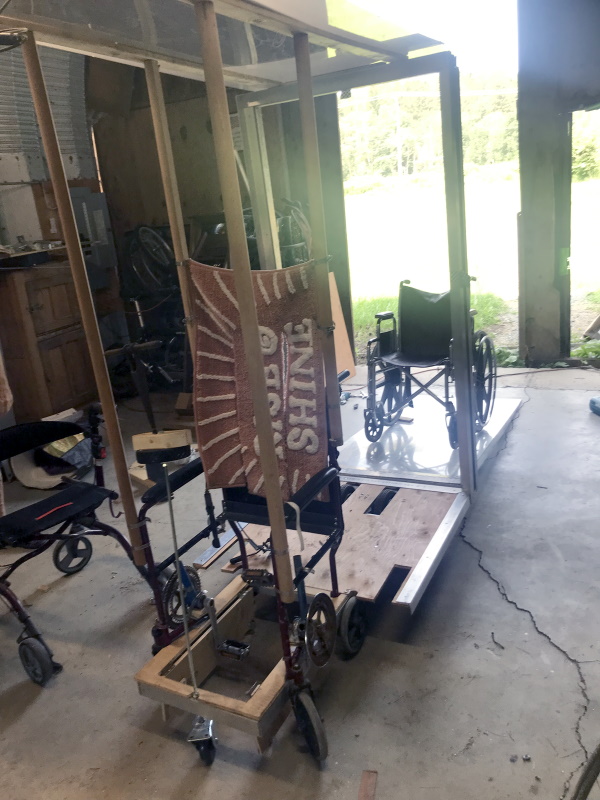
Eleven 120″ x 42″ x 75″







One version allows the rider to determine his posture when moving, from standing straight up to sitting or leaning or even practically lying down. Since maximum visibility is needed to provide safety, conspicuous extensions are deployed above the vehicles, aided by LEDs, to make certain that trucks, vans, buses, and cars are able to be aware of their presence at all times.
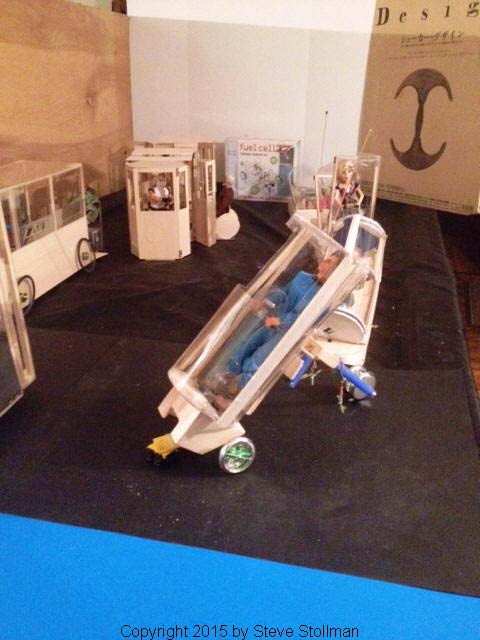
What is not there, are fully weather protected, stable and comfortable, up-to-date trikes. If vehicles are light enough, human power is relevant, and by using solar/electric assistance, travel can be pleasurable and healthful too. Until all of the relevant technologies evolved to this point, motors, batteries, controllers, etc., this advance was impossible. We have the tools now, to bring our bloated urban transportation systems, down to the Human Scale, to take a giant leap into a survivable future, and a much more beautiful and visually arresting place.
Most public spaces around the world have, historically, been monopolized by dangerous, oversized vehicles. The relevance of minimal transporters is now being acknowledged by City governments everywhere, and most of the public too. Whereas cars are too big, it is also true that hoverboards and scooters, even bikes, may be too small. They are all used, almost exclusively, only in fair weather. This is understandable, since cold can be magnified when you are moving, and rain is not much fun, and it makes pavements slippery and radically lowers visibility for drivers in dangerous, nearby cars. If every place were Copenhagen or Amsterdam this would matter less. Here and elsewhere, we have accustomed ourselves to a very high level of physical comfort though. We need vehicles that can be enclosed when necessary, and open when not, evolved designs that allow for group riding instead of just solitary, and as much artistry, creativity, and ingenuity put into these protective vessels as humanly possible.
Just as important as making it, is making it to last. There is a challenge, to make these things so they can well withstand the wear and tear of riding on rough roads, and that multi-person use of something is going to inevitably entail. There was a time when it was understood, that you made something to last as long as possible. Following that we had “planned obsolescence”, and trivial design changes to remain the “latest”. Now we need to go back to the original idea. Trolley cars lasted decades, even as they were updated and improved. Durability, especially when you are being punished by imperfect conditions, is crucial. It will also matter to have facilities that are able to provide repairs and improvements to a growing industry.
Safety matters greatly. Nobody should be expected to be harmed by the use of your product. Smooth loading and unloading of passengers must be assured. While in transit, users must be provided with comfort and ways of securing themselves to maximize their pleasure in this passage. No sacrifices are being asked for here. The point is to raise quality, access, and affordability, all at the same time by bringing things down to our “Human Scale”.
The street is also a theater. Sidewalks are full of audience members, and customers as well. Those operating these vehicles are putting on a show in which they are the star. The object is a stage and also a prop, a costume, and a statement. It cries out for lights and bright colors, to be as fantastic as it is practical. If it has been hired for a child’s birthday party it might assume one shape, if they’re for a wedding, something else. Have a Winter guise and a Tropical, a somber mien and a celebratory one.
An organization is being formed, which is intended to act as an expeditor, to instigate this activity everywhere, and help to expand the influence of this work. This effort is intended, partly, to ratify the good sense of using a kind of International Cooperative, as a model for taking action on urgent matters such as Extreme Weather. It is a way of exploring the energy that can be generated, by identifying one another, according to our interest in, and participation in, a relevant aspect of our common lives. This can be done by breaking down geographic and other nominal and irrelevant barriers to a peaceful, well-fed, and dignified population, able to move about freely and fully acknowledge each others’ humanity.
Along with agriculture, transportation has been scaled up, such that the consequences of the few players’ policies, are invisible to these immensities. Economies of scale can benefit us sometimes, but can also give all of the discretion to the largest factors, who will do anything to secure their status. A successful effort to radically improve the terrible working conditions under which those in this profession ordinarily endure may also help to make it possible for other groups, who are currently at the lowest end of the occupational ladder, to mobilize themselves, to generate the resources needed in order to improve their common lives.
The ultimate goal of this undertaking is the widest proliferation possible, the soonest, of the most environmental, healthy, unique, beautiful, and practical, human/solar/electric-powered vehicles. Some of these would be for-hire, passenger, and wheelchair-carrying models. Others would be intended for personal use, and still, others are designed to be used, primarily, to move goods. All of this is most suitable for dense urban environments since their speed would need to be limited, to maximize their safety for users and others. Making them no larger than they need to be, will permit more valuable space to be provided on often congested and crowded streets.
The expectation is, that as the public becomes completely comfortable with this needed transformation, the continuous acceleration of the process to replace the existing system, with one that is so much better, is assured. The durability of the objects produced must be of dependable and remarkably high quality. Their popularity, and the pleasure they provide, will make certain that nobody even pretends that they miss the old, deep-fake “ideal” system, that we had been convinced was our only alternative.
There is not enough room for the unlimited multitude of enormous trucks, buses, limos, delivery trucks, and private automobiles that jam urban spaces everywhere currently. Even if many of them were essential to our survival, they deny, rather than affirm, life. Adding fees has had a minimal influence on the volume of traffic. Even if some provide for needed services, while also representing a huge investment by their owners, they are, by and large, alienating, dangerous, bullying, toxic, homely, oversized, and out-of-place. To an infantilized population, all that activity may be fascinating and titillating, but the insanity of it is drowned out by its sheer volume and the zombie-like acceptance of all of this by the masses, propelled by media, all of which are addicted to the income earned by pushing consumerism.
The amount of time being wasted, the out-of-proportion helpings of food, and continuous noise, meld together and help to justify one another, to convince us that this is the only way. The disorientation that is the ordinary response to overloads of change, is to be expected. AI and the Pandemic are not just moving the goalposts, they are moving the poles. Horse stable owners at the turn of the last Century had the same problem. One had to do with sanitation, which biology rendered unsolvable. The other crisis had to do with the rapid increase in the scale of everything. Three-story buildings turned into 13, then 30, now 100+ stories. The success of cities is based on their ability to grow infinitely, giant black holes swallowing nearby stars, appearing to be inevitable. Unfortunately, this can fail to take into account the effect of all this change on ordinary people
Now that the effects of our common lifestyles are revealed to have been earned at the expense of the possibility of risking our survival on this planet, while also making an infinite number of other people miserable, recognition of the extreme danger that this distressing realization affords, is much closer. The remedies being offered to provide relief for this serious malady are very few and most are without sufficient effect to offer any hope of avoiding the worst of the looming alternative disasters. If the forests continue to burn, floods and droughts multiply, and the permafrost delivers enough methane to poison our atmosphere and render it unsurvivable, will the raising of MPGs by 2050 really matter? Even if it were 2040 or even 2030, this is the use of an umbrella in a hurricane. If there is a remedy here, it is going to have to arise out of the desperation of those many who realize the gravity of our situation and decide to devote some portion of their energies to meeting this serious challenge to our very existence.
There needs to be a wholesale re-evaluation of many aspects of our society, such as food, but the most pressing one is transportation, with its dramatic effect on our climate crisis. Soon, a fortune will be spent upgrading some transportation facilities, but almost all of it will be an effort to fortify existing bad habits while comforting the voting population that they will not tumble off their bridge any time soon. The amount devoted to supporting meaningful change in our behavior, which might provide us with some relief from the onrushing catastrophe that we are facing, will be minimal. There is no lobbying group with any major influence, that is asking the public to give anything up. That is not how you gain people’s support.
For that reason, the idea of generating an entirely new urban transportation system, based on lightweight, human, and solar/electric power, and, most importantly, creative energy, is so important. We are born ingenious but discouraged from employing this faculty or even appreciating it in others. Everything we would ever need is already here, we are told, and our role is merely to be a proper user, if possible by employing no more than a finger or two. We need to be careful that the new medium of virtual reality doesn’t become the final nail in our coffin, as we are convinced to abandon this imperfect plane, for one filled with ersatz majesty and unlimited possibilities, no matter how unreal.
Getting two hands and two feet fully back into the picture at this stage will not be easy. Designing and making things that work, especially at the highest level of the craft, requires serious effort. Few people have the personal freedom to simply devote themselves to creating something, no matter how important it might be, and neglect their other responsibilities. Help has to be found to provide some assistance to those endeavoring to do this. This project needs a framework, to encourage the artists, engineers, mechanics, and others who can contribute to this process to step forward. Putting up rewards, prizes and the potential for acknowledgment will be needed, to gain attention and motivate participants. This must be done, hopefully, without selling the “branding” opportunity that supporting this project might provide, especially to those with sketchy environmental credentials, who could use this for the purpose of Greenwashing their ordinary activities. That “help” would undoubtedly trivialize this quest, even negate it.
If this all can be financed and promoted by individuals, genuinely interested, preferably smaller, businesses, groups, and relevant non-profits, even enlightened Transit Agencies, it can happen now, in many places at the same time, and be both serious in intent and joyous in spirit. It is notoriously difficult to launch efforts of this magnitude, without the cooperation and financial support of some large entity. The likelihood that it will be misdirected or exploited increases considerably though when there is an “overseer”, especially when the intent of this program is to initiate the widest assortment of designs and approaches, rather than consolidating influence and rewards in any one place. It might be somewhat more difficult to utilize a bottom-up strategy to gain needed support, but this is the same energy direction that a human-powered device like a bike uses, and maybe it should also be the one that propels the movement to expand its growth and impact.
Bringing Pedicabs into the 21st Century, all the way from the 19th must involve a complete re-conceptualization of this opportunity. Factors include urban transportation, localization, entrepreneurship, and information. There is no historical model for this approach, and to some extent, it is now possible only due to recent advances in technology. In New York City, and in many places with similar density around the world, there is a need for the creation of a service such as this. It would:
Call for the construction of vehicles, fully accessible to wheelchairs, no larger than the 120” x 54” limits now in effect in NYC regulations guiding pedicabs. These conveyances would be fitted with movable solar roofs and wall panels which can be consolidated, when the weather permits, allowing the vehicle to be completely open to the outside, like a bike. At other times, all of these clear windows will be closed to provide for the comfort of riders.
Allow the use of these vehicles to be varied in the course of the day. There would be two or three operators of each vehicle since it would be operational during a long day. It would be available for very profitable tours, private passenger or package delivery, while a portion of the time, it would ply an established route. These 20-60 minute circuits would take it to local transit locations and other important features of their neighborhood. A serious attempt would be made to hold to an approximate schedule. Locals would come to expect this service to be available on a regular basis. Depending on the neighborhood and the desires of the operators, this would happen five times a day or 35 times.
Although it increases the complexity, the most beneficial use of this opportunity would involve vehicles plying regular routes, during part of the day, while providing a host of other helpful transportation and other services at other times. There are other informational and community-based assets that could be enhanced this way, through the design of appropriate vehicles and the establishment of the resources necessary to educate, orient, and deploy local entrepreneurs as specialists in public information. If you have the latest and best information as regards living and working spaces, especially shared ones, you are entitled to use this information to provide you with some income. The same goes for local jobs, services, and educational and entertainment connections. There needs to be a legal framework designed and implemented, a way for charges to be billed, for instance, a way to track the location of vehicles on missions, etc. These resources need to be put into place, to provide operators, everywhere, with the tools needed to fulfill these tasks, as part of a non-profit cooperative. A corresponding digital, online reference point, must also be put in place, to expand the reach of these activities. In time, this element could become one of the most important and profitable ones.
It is expected that local travel, on its regular route, could be offered at no charge, although tips would be invited. This unusual arrangement is possible if the earnings from real estate, jobs, advertising, private transport, and other activities turn out to be sufficient, to provide for a very substantial livelihood. This does not take into account the other potential ways, in which involvement in this profession could enhance lives. Becoming a relevant part of an ongoing community can open up other avenues, social and business connections, and access to positive situations and possibilities. One can become a roving, but also fixed, element of the surroundings. In fact, some time should be spent, by each vehicle, at suitable locations within their routes, so that they might be accessed by locals who want to provide them with relevant information or access it. This provides for a rest period, perhaps a snack, and closer interactions with the rest of the local community, including the provision of free terminals. Some literature can also be available, and some resemblance of this phenomenon to the city’s historic network of local newsstands can be established. Any local publications can be provided with an outlet, including some of the more esoteric, art, poetry, literature, etc.
It is understood, that operators would need to be helped to master the skills needed to make this a very profitable and satisfying way to make a living. They would also need to perform their duties to a high standard of excellence to be enabled to continue their efforts. The plan here is that successful operators would need to agree to spend a certain minimal amount of time orienting new operators and helping them succeed. The intention here is to form a community of operators, who will democratically establish the means to guarantee the high quality of these activities, while expanding the operations continuously, in order to enable more people to craft these meaningful opportunities, to improve their own, as well as everybody else’s, lives.
It is expected that those involved in this program would begin their careers as operators, after appropriate orientation, etc. to determine whether they enjoy and are suited for this work. Once they are established, it will be possible for them to begin to earn ownership of the vehicle and the business associated with it. Over time, the multiple operators of each location will have an agreement among them that outlines their responsibilities and possible rewards. This requires a high degree of responsibility and maturity and will need to be guided by a set of mandatory practices, and a process for dealing with situations where these regulations are being ignored. Without one fully-operational example of this actually working, it may be difficult to convince anyone that all of this is possible. Granted, there are many unique, and therefore as yet unproven, elements here, and the right individuals will need to be recruited, initially, to maximize the possibility that it will work well, but the quality of this opportunity is such that it should attract the best candidates to take it on.
This will be organized as a profit-making venture, partly under the jurisdiction of a non-profit entity. It is a business that, along with being profitable and relatively trouble-free, also has the goal of humanizing this activity, aiding the urban environment, and providing a full measure of dignity to those engaged in the enterprise. It is being designed to do this, while also helping to enable local communities everywhere, to find their own voices, and generate the best available means of providing the essentials of life to all of their inhabitants. One feature here is in the form of an ultra-local, Craigslist-style resource, that can guarantee that unwanted resources can find a home, and would be welcomed by everyone.
The Half is an NYC legal pedicab, designed with some of these functions in mind. Regardless of its excellent suitability, it is hoped that, over time, other highly individuated and attractive designs for these vehicles will emerge and be put into use. If created with respect for the unique surroundings that it plies, these designs can come to represent their individual streets and neighborhoods, their history, and special assets. As well as being the most useful objects imaginable, they could also become some of the most distinctive and beautiful ones as well.
Small-scale transportation, like bikes, is becoming more popular and, it is increasingly realized, essential, all of the time, especially for use in crowded urban spaces. Here though, instead of a 21st Century masterpiece of a people-carrying vehicle, we have an enlarged baby carriage. Along with the outdated, Colonial Era, humans as draught animals, and equipment, we have archaic laws to go with them, and practices as well. This type of vehicle has the capacity to be the most desirable, sensible, environmental, friendly, and appropriate form of short-distance urban travel possible, so it needs to be encouraged in every way possible, not subjected to crippling, senseless restrictions. While conditions vary in different places, needed changes in New York City include:
Small, clean, and quiet electric motors, must not be prohibited as a matter of humane working conditions. There is extreme, unhealthy difficulty in pedaling around with human cargo that could easily reach 500 pounds. Preventing access to this modest improvement is inexcusable. Besides, in spite of their being prohibited technically, 95% of New York City’s fleet of these three-wheeled vehicles already employ them.
There is an unfair and unnecessary limit to two or three passengers. If they are to be part of the transportation system, rather than a service limited to deep-pocketed tourists, it must be made economical. (The Boston system is currently free-of-charge and tips are sufficient to keep drivers happy.) It is possible, given the additional power available with the use of these small electric motors, to sensibly and safely convey 6 individuals.
More than one person should be able to supply energy to the battery/electric system at the same time. There are many riders who might enjoy the opportunity to get some exercise while riding along. Fitness means healthfulness and needs to be encouraged. If rewards can be provided to those putting in the energy being used to move ahead, that would go a long way toward motivating this activity. The current prohibition was initiated as a way to prevent “conference” bikes with a half dozen riders from operating in a dangerous fashion but was mistakenly applied to all other bikes as well.
If we are only moving at 15 MPH or slower, standing should be permitted. It is fine in trains and buses that go three or four times faster. Appropriate handholds and specially-designed places to lean can provide safe transport. In fact, many people would prefer to be somewhat upright, if given the opportunity, to feel stable and comfortable, and as an added advantage, it is economical of space. Security belts can be available and provided to those desiring one.
It must be unacceptable for drivers to get soaked or be frozen, while working, or otherwise subjected to dangerous and unhealthful conditions. They must be given proper cover and reasonably comfortable surroundings. People can not be regarded as “Coolies” or treated as draught animals.
There should be no limits on the lighting of the vehicles. Except for classic Yellow Cabs, no other means of transport is forbidden or required to look a certain way. Individuality and diversity need to be encouraged and owners should be helped to become positive contributors to our visual environment.
Not being able to pick up different persons, en route, prevents this service from realizing its most beneficial identity, as a form of public transportation that also does work as livery and for private purposes sometimes
Mandating a “Unibody” construction for pedicabs makes no sense, especially since cargo bikes are utilizing all forms of trailers and, are now proliferating through every city. Their ability to lessen the burden of too many oversized trucks clogging streets is being seen as a potential boon to urban traffic flow, and that goes for pedicabs as well.
Given that these vehicles are also a form of public service, and are relatively small and unobtrusive, they ought to be allowed to park overnight along suitable curbs in some selected places, to help enable their widespread and convenient use.
In order to lessen concern that drivers will rampage down streets using motors, a voluntary speed limit of 15 MPH may be agreed upon by all of those in the industry, to eliminate the need for regulation. The safe operation will be enhanced this way.
At least some of the fleet must be made wheelchair-accessible. One result of this would be the same vehicles that carry persons could use their design to also accommodate cargo easily and expand their money-earning possibilities and overall utility. Besides, it is the law that at least a portion of any fleet works to expand handicapped access. An entire fleet of wheelchair-accessible vehicles could be deployed citywide this way as a serious improvement to the current access-a-ride system.
One use of this opportunity, perhaps the most beneficial, would involve some vehicles plying regular routes during part of the day while providing a host of other helpful services. There are other informational and community-based assets that could be enhanced through the design of appropriate vehicles and the establishment of the resources necessary to train and deploy local entrepreneurs as specialists in public information regarding employment, real estate, education, and entertainment activity.
Failure to display rates properly should cause you to lose your permit if done more than once. Negotiated prices must be permitted but accompanied by a clear understanding of potential charges. The good reputation of this industry must be restored.
Eventually, there will need to be a great many more of these vehicles, preferably scattered throughout the five boroughs. This should happen once the existing regulations have been modified in order to make them as fair and beneficial as possible. This can be thought of as an important early step in the urgent need to re-frame urban transportation, down from the industrial to the human scale.
has recently been revolutionized and the same is needed here. It will involve more than motors, dimensions and the number of wheels. In order for this profession to reach its potential to provide benefits to both its participants and the general public, the original stunted, politically-charged legal process that defined the field and set the conditions, must be started over. The importance of the climate crisis, the defeat of congestion pricing as a way to improve vehicle circulation, the advances in helpful technologies and the ever present need for healthy, dignified, profitable and beneficial forms of making a living, demand that this subject be treated seriously. It should not be about a nostalgia gimmick, with operators subjected to bad weather while their clients enjoy comfort and splendor, but rather an honest attempt to maximize the improvements to our public spaces that a real program could provide. Design competitions and robust community discussions must be part of this, along with whatever incentives, financial and otherwise, can be gathered and mobilized.
The negative aspects of the current situation must not be permitted to conceal the larger questions. Otherwise, there may be some improvement in the most negative elements of the picture, but no real structural change in the nature of this activity, its definition as a minor form of entertainment instead of a major form of transportation, an important spur to local community development, and a form of artistic expression. The potential to fuse private and public travel, wheelchair and elderly transport, educational and pleasure tours, cargo, delivery and other improvements in urban life, is well worth exploring. If all that is asked is to throw out the bums, that is all that will ever happen. Even if that were to be accomplished, which is far from a certainty, that will be a total waste of an important opportunity to do much more.
We could use the participation of academic institutions. Some different public schools and Universities need to be contacted and invited to be part of something. We have a lot of them here, especially New York based ones, all can be given a chance to participate in this. It is about engineering and art and urban space allocation, the environment and employment and entrepreneurial opportunities, tourism and disability transport. There are advocates in each area, nonprofits and famous pioneers in their respective fields. I believe that the seriousness of this effort will determine its efficacy and scope. Sure, demanding big, lit up license plates on current pedicabs and fair and enforceable regulation is a worthwhile goal, but it is also essential that the relevant co-factors in this urgent and important work be mobilized and encouraged to make their contributions to this task.
We’re here to help and answer any questions you may have. Whether you’re interested in getting involved, partnering with us, or just want to learn more about A Movement, feel free to reach out.
For more specific inquiries or detailed assistance, please reach out to us by phone or email:
Tel.: 212 431 0600
Email: stevenstollman@gmail.com
The images used in the website links are samples of possible development and they are not the official part of this undertaking.
for human-scale vehicles, including electric-assist bicycles and pedicabs, as well as a stronger local, creative and public role in determining public-space issues. I imagine streets in the future filled with clean, quiet, weather-protected, multi-person conveyances that are beautifully and uniquely crafted, shaped, and decorated by human hands, gifting our roadways with color and rhythm, as well as safe and affordable transport, bringing a degree of charm and convenience to congested urban spaces everywhere that we are afraid to even dream of enjoying.
Total Articles: 41
The following is testimony was given by me at the hearing at DOT today, May 29th, regarding the new rules covering ebikes:
The flowering, here in its most natural and needed environment, of human-powered, with modest electric assistance, and human-scale transportation, is the best remedy for the damage inflicted by 100 years of control of this vital aspect of our lives by the mining and manufacturing industries. Using tons of materials to move us from place to place within urban spaces, when tens of pounds will do just as well, makes sense only to those selling us this mistake, pound by pound, year after year.
When I asked a Swiss participant in the “Tour de Sol” electric vehicle event in 1989 why a country with only 6 million people had 90 percent of all of the solar vehicles in the world, he replied “We have no car company and we have no oil company”
Your actions today are opening the door much wider to a fully sustainable future. You are to be congratulated for that. Now please apply your new awareness to similar vehicles, like pedicabs and cargo delivery vehicles, that have the potential to replace dangerous, oversized and polluting alternatives.
Also, please permit those using this equipment in their work to modify it, to conform to your new requirements without having to purchase brand new equipment, if the result is exactly the same. This is an unfair burden to place upon anyone when it serves no valid purpose. You can, instead, institute a regular testing procedure to ensure compliance and the Department can use the opportunity to simultaneously provide some beneficial orientation regarding traffic rules and best practices.
TO THIS I WOULD LIKE TO ADD:
The New York Bicycling Coalition deserves much credit for bringing awareness to this issue over the last four years. They are currently leading the charge in Albany in order to bring forth appropriate legislation on the State level. Any help from DOT in this regard is most helpful and appreciated of course.
We need to learn to respond to situations such as this, whether it be new technology or unforeseen environmental effects, without waiting decades to assess and act. We may not have an infinite amount of time to deal with matters of this magnitude.
I was the NY distributor for a variety of electric bike brands, including Giant, Panasonic and FORD, without much success over the past decades and all of these machines fell far short of adequacy, since they relied on heavy lead acid batteries that made them very cumbersome. The advent of lightweight lithium ion batteries has changed the situation radically though and it is now virtually impossible to distinguish some electric bikes from non-electric ones. Most importantly, the onus of using these machines has all but disappeared. The bike culture has finally come to embrace these vehicles and those who use them. Instead of sneers you get intelligent questions about how they work. All over Europe and the rest of the world electric-assist vehicles are being welcomed. We are late to the party but at least we are getting there.
I am currently designing prototypes of wheelchair-carrying pedicabs that will require pedal-activated electric-assist motors to function properly. The benefits of this technology, especially to those with mobility challenges, will be enormous.
Thank you again, on behalf of all air-breathing animals.
Jul 06, 2014. Times Article Viewed: 8863
Many of the most disturbing events taking place around the world, the Middle East, Ukraine, etc. revolve around the supply of fossil fuels. It is a militarized world because there are stores of wealth, instead of more equitable distribution, and they must be defended. The tools used to maintain the status quo are also heavily tilted in favor of big machines, military, and civilian, cars, trucks, airplanes, etc. that also depend upon these materials to provide their motive power. WWII, and even WWI, in many’s estimations, was largely decided by the combatants’ ability to manufacture, use and fuel these enormous mechanisms effectively, to employ the heavy armor that carries its ordinance into battle. In some important ways, in spite of all the miniaturization and other technological advances made in the last century, this is still true. Nobody should ignore the bravery of troops and cleverness of commanders as key factors in these matters of course, along with the righteousness of their causes, and the cooperation of populations in these struggles, but the machines, and the fuels they run on are still huge factors in determining who prevails.
Even local conflagrations, like those now taking place in Ferguson Missouri, one commentator suggested, are deeply rooted in the frequency of car stops, the assumed profiling that goes into them and the higher rate of incarceration generated by unbalanced enforcement. “The New Jim Crow”, the book I am currently reading, makes a strong argument that policing policies have had a great impact on the definition of communities and the ability of their members to assume their rightful place within societies. The remarkable revelations regarding the use of retired military equipment and the adoption of quasi-military tactics have become a serious element of the overall picture.
We have accustomed ourselves to a world where speed, power and the ability to physically overcome the obstacles that restrain our ambitions and assumed freedoms have become paramount concerns, both psychologically and practically and the source of a preponderance of violence and unhappiness. This is mostly a direct result of the importance of status and the historical differences in access to resources which the past has delivered to us in abundance. We may be able to encourage a more balanced and egalitarian approach to these situations by modifying some behaviors but the underlying influences are powerful and without examining them and finding ways to re-balance these situations, any cosmetic or minor improvements may just serve to sustain the prior contradictions and misalignments.
Our inability to face up to and deal with these important issues is dismissed by most as a consequence of our busy lives and pressures to keep things together in an increasingly pressurized and difficult environment. Who has the time to devote to causes when the garbage has to be taken out and the mortgage payments made in time? For the privileged it is mostly a question of priorities, sorting through available pleasures and choosing the most attractive ones. For everybody else, social, environmental and other problems are considered insoluble anyway and beyond the reach of the common man. It is up to the editorialists and the habitually discontented, widely regarded as maladjusted individuals with the need to complain about something, to bring up these issues and grind their molars to bring themselves a measure of self-satisfaction. The only way that things will change if there are a catastrophe and the cure might easily be worse than the problem if you’re not careful, so why bother?
This attitude is encouraged by those who would prefer that things stay the same regardless of the consequences. We are frozen in space, comforted by the amount of company we have in this paralytic coma. We know that our leaders are dunces and expect no more from them. We know our neighbors are in the same boat so why should we be the ones to stand out? The differences in priorities between old and young, black and white, male and female, in themselves are so profound and effective in determining our attitudes and ideas, that the smaller ones, like the variations in income and prospects, sink into unimportance.
We take for granted a host of incongruities and distinctions that are really unfortunate and unnatural yet too minor to rise into full consciousness. We know that everybody is different and would be horrified to live in a world where these aspects of our individual relationship to the world did not exist since we identify ourselves by them and spend a lot of time enhancing or submerging them. Sure, one person is a better dancer and another a smoother talker and that is OK. But what if one seems touched by an Angel and another doomed to fail, should that be accepted without question?
We love the competition. More so when we or our team wins, but the thrill of being in a contest where one might prevail gins up the adrenalin regardless. Some of this is perfectly natural and a wholesome way to motivate people to excel. If the game is rigged though, it can dispirit the players and make them permanently cynical. Even more importantly, it creates a model for other activities and sets standards of behavior. It has been said that in a baseball game in Japan, the perfect score is a tied one, and participants are happiest when everybody is a winner and nobody a loser. This kind of societal compassion might be pointed at by cynics as the reason that the country has been in economic distress for decades, a core failure that keeps the spirit of success from pushing individuals to achieve and thereby prosper. Another interpretation is that the commonality here is an expression of the humanity of those people and far more valuable than a trophy or medallion stuck away in a drawer somewhere.
Empathy is the enemy of dominance and can not be measured or put into a chart or a bottle to be put on a shelf. In our culture, we are captives of quantification and have sacrificed the concept of quality to the accumulation of points, square feet of house size, horsepower and stacks of possessions. Not surprisingly, 750 watts, a mere one horsepower, brings to mind a lonesome cowboy, a sad and unimposing figure, yet this is three times the figure permitted in the European Union and Asia to propel a person 25 KPH on an electric-assist bike, enough to do the job of getting somebody to work or play each day. It might be necessary to double that figure if you add a second person as a passenger or substantial sized load of goods, some weather protection or the energy to overcome a strong headwind, but it is enough for almost any purpose. Is there any rationale for keeping these vehicles off the road since bicycles are now considered legitimate vehicles everywhere and permitted on city and country roads everywhere?
The New York State situation is illustrative. The NY Times this week highlighted the increased role of electric-assist bikes in Germany, hardly a third-world country, with thousands of them in use by the post office there and a rapidly increasing presence as commuter vehicles throughout this heavily-industrialized nation. Last year, a bill here to legalize these vehicles came with a day of being passed by the NY State Legislature. The prospects for this happening next year are good, especially since the national bike organizations, People for Bikes, etc. have now indicated their strong desire for this to happen. For too long, the bike culture looked upon these devices as heretical, a departure from the ethic of self-reliance and self-propulsion essential to their vision of the role of cycles in the society. Finally, they have come to realize that there is a huge portion of the population that wants to bike but finds the exertions necessary to overcome hilly terrain, the long distances of their commutes and their desires to show up to work without having to change clothes, to be serious impediments to the use of regular bikes. Logic, fairness and common sense are overcoming historic prejudices and limitations of vision, but much too slowly.
The e-bike industry has done a pretty good job of perfecting this technology. It has come at a price though, in that typical bikes are in the $1500 to $3000 range and the cost of lithium-ion batteries is still relatively high. There is the talk of breakthroughs that will radically lower these costs and extend range while making the vehicles as light as typical mountain bikes rather than the 60-80 pounds that were the rule when lead-acid batteries were the norm. The designs are beginning to evolve rapidly as well, with Kickstarter and other such venues highlighting exotic and exciting-looking alternatives with extra features such as special communications, health-monitoring and mobile-device charging becoming standard equipment on many models. Instead of merely taking regular bikes and adding on a motor these vehicles are now beginning to forge an identity of their own. Prices in the $3000-$5000 range are no longer unusual and every major automobile company from Ford to Mercedes is featuring their own version of this new transport modality. Models with higher speeds, beyond those permitted under the Federal law that limits them to 20 MPH without assistance, are also becoming more popular here, even though they may require more paperwork and permits.
In spite of all these changes, the real potential of this modality to radically transform our transportation systems is still to be realized fully. This will involve the shift from the two-wheeled model, a bike basically, to the three-wheeled version usually referred to as a trike. Our concept of trikes is conditioned by their identity as the vehicle of choice for 3-6-year-old kids. The hilarious notion, popularized by the old “Laugh-in” bits, of a full-grown person precariously turning the wheel of his tiny tricycle too quickly and tumbling over sideways, or the elderly resident of a retirement community tooling along at 3 MPH, still dominates our thinking. Human-powered and electric-assisted hybrids, with some weather protection and freight capacity, like the ELF, are now being born, even appearing this month on the cover of the Hammacher-Schlemmer catalog, but are still rare and virtually invisible. In time, they should become the most common form of travel, especially when they can become part of vehicle-sharing systems. Many new designs will need to be perfected and introduced to the public and overcome the limitations imposed by unjustifiable rules, such as the one proposed in New York State which prevents those under 16 years of age from riding as passengers.
Sure, over time we will be able to overcome these restrictions and sense will prevail but we are already decades behind in our thinking and really need a leap forward to make up for some of this lost time. One of the reasons that it is difficult to accomplish this is because of the pressures exerted by those with the largest stake in the existing system. Keeping archaic laws in place is possible through the intransigence of public officials who automatically endorse the policies already in place without considering their actual impact. It took 10 years for the NYS Senate to even consider the legalization of e-bikes even though a bill had been passed in the Assembly each year all during that time.
This reflexive endorsement of the status quo is a willful failure to consider the improvements to our lives that new technology can sometimes provide, with no other rationale than the protection of existing interests and their historical limitations. Imagine if we were still using landline rotary dial phones because AT and T preferred that system. More public pressure can sometimes help and the ability of these new interesting industries to promote their products matters as well, but we have lost decades due to this form of reactionary mindsets. It is a subtle form of corruption and is one of the factors that is eroding the potential for those now struggling with the exceptional pressure to survive and prosper in this economy. Downscaling is very difficult for those institutions, like governments, that depend upon the scale of economic activity without necessarily relating to the amount of useful activity involved versus the amount of waste being generated. We ordinarily do not distinguish between the two and in this case, we must.
This calculation does not even count the most important issue of all, our health. Giving us the option of using our muscles and bodies to accomplish needed work is essential to our futures. The greatest costs incurred are in health care and the loss of vitality is what shortens life and makes it less rewarding and pleasurable. Here is the opportunity to preserve our most important abilities, at the same time as we save money and improve the environment and it is not being encouraged in every way? How can that be? Are we so decadent or are our institutions so out of touch with the most pressing needs that we can not recognize this reality? Sadly, there is only one answer. We are lost and we can not expect our “guides” to bring us home. Only a much higher level of activism and consciousness can change this situation and it is ours, not others, that matters. If we can’t fix something as obvious as this, how will we ever be able to take on the more difficult questions? Answer: we can’t.
In 1974, Bradford Snell, a legislative assistant to Senator Hart of Michigan, and Judiciary Committee staff attorney, delivered an historic report on the partnership between two great American industrial powers, the General Motors Company and the Standard Oil Company (Firestone was the junior partner), which resulted in the dismemberment of our entire rail system, all in a bid to increase their profits. The report was distributed by the Government Printing Office, until GM demanded, successfully, that it be withdrawn. In subsequent years some of its observations have been challenged but the central theses are undeniably truthful and shocking in their conclusions. Here is a link to the original testimony that gave birth to the report.
This amalgamation between the largest elements of the manufacturing sector and the mining sector, to some extent as the representatives of those elements of the economy, was begun in the 1930s. Their express purpose was the destruction of the rail infrastructure of the United States of America, their home country. Many would regard this as an unmeasurably immense act of domestic terrorism. This was, without question, an assault upon our common interests, one that would be expected to be perpetrated by a sworn enemy, intent upon weakening our economy and demolishing the prospects for our future prosperity. In fact, Mr. Snell’s report also details some of the ways in which these same corporations, during WW II, also maneuvered to maintain and preserve their relations with the Axis powers, even after the war had been declared.
This was a deliberate, and ultimately successful effort, to expand the market for their products, by means of demolishing the quality and availability of their competitors’. Some are familiar, through the “Roger Rabbit” movie and other sources, with the destruction of large parts of the California traction system. Less well understood, is, that this was a nationwide, three-pronged program, which targeted Inter-urban Rail, Trolleys and Rail Freight at the same time. This campaign worked so well, that these modes of transportation are virtually gone and have been replaced by cars, trucks, and buses, vastly inferior economically and environmentally. The conversion of major streets into highways and raceways also had the collateral effect of making them unusable by bicycles and other slower and more vulnerable populations.
Over the years Mr. snell has promised to put together the complete story of General Motors and its efforts to make money and influence policy. Since the company has gone through such massive contortions over the past decades it is a seemingly unending tale, which he will no doubt, one day, finish telling. Just today, it was announced that the Federal government will sell off its remaining shares in the company and sustain only a merciful $10 billion loss, a pittance compared with the potential loss to the taxpayers and employees at the time. As an additional benefit, some pressure has been applied to encourage the development of cleaner and safer and more efficient models, but, sadly, the nature of “cars” as we know them, and the industries that supply them, remains largely the same.
There are two questions that must be answered to understand the nature of this massive re-direction of resources: How could this happen in a democracy, where the interests of the many are supposed to hold sway over the preferences of any privileged minority? Also, does the convenience, comfort, and ubiquity of these new ways to get around make them vastly superior to their rail-bound predecessors? The answers to these questions are vital to those now in the process of attempting to once again bring about structural change to these areas of our lives. The expansion of human-scale transportation like electric-assist bikes, new power sources for electric cars, buses and trucks, and the land-use and other associated issues related to these developments will define our future, in some key ways, and need to be addressed in their fullness.
Next week, some more information, such as the complete “American Ground Transport” report, will be linked up to this site. This week, two events took place in the electric-assist bicycle universe here, one welcome and the other tragic:
Bert Cebular, the founder and operator of NYCEWheels, the city and country’s leading purveyor of electric bikes, died in a para-glider accident. Practicing sensitive “touch and go” procedures, he is the person who would probably have used his skills in the rescue work of the future. He was a highly admired, respected and liked person and a pioneer for ten years in raising the profile of the activity. He made sure that his staff worked, maintained a real service and tech department, was a master woodworker, web designer, mechanic and creative vehicle maker, a rare polymath and forward thinker who caught the wrong gust of wind and will be sorely missed. There is a memorial ride this morning through the snow.
The other development was a demonstration, organized by the Urban Justice Center, of over 100 restaurant deliverers, mostly Asian, who are being swept up in the city’s recent campaign to “ban” electric-assist bikes here. It is a welcome step that these hard-working people, using environmentally-optimized transport, having been demonized by the auto-advertising addled press as a hazard to navigation, are fighting back. They will have the opportunity to establish the benefits of what they do and how they do it. Some contributions to improving the current situation will need to come from the restaurant industry itself, such as a campaign to eliminate any sidewalk riding, by deliverers as well as others. A new Mayor and City Council, perhaps somewhat more sensitive to the conditions under which hard-working people must maintain themselves, should improve prospects here. Political figures at both the State and City level, and the media, will need to be educated, given rides and helped to understand the issue better, apart from the overblown rhetoric which has been defining it in the public’s mind for too long. The health value of this new transport modality to the older population and others will be brought forward and its real nature made plain. It’s about time.
Aug 24, 2014. Times Article Viewed: 9331
For over 150 years of the industrial revolution, bigger has always been better, but in the 21st century figuring out how to downscale will be the most daunting challenge mankind will face.
Many of the most disturbing events taking place around the world, the Middle East, Ukraine, etc. revolve around the supply of fossil fuels. It is a militarized world because there are stores of wealth, instead of more equitable distribution, and they must be defended. The tools used to maintain the status quo are also heavily tilted in favor of big machines, military, and civilian, cars, trucks, airplanes, etc. that also depend upon these materials to provide their motive power. WWII, and even WWI, in many’s estimations, was largely decided by the combatants’ ability to manufacture, use and fuel these enormous mechanisms effectively, to employ the heavy armor that carries its ordinance into battle. In some important ways, in spite of all the miniaturization and other technological advances made in the last century, this is still true. Nobody should ignore the bravery of troops and cleverness of commanders as key factors in these matters of course, along with the righteousness of their causes, and the cooperation of populations in these struggles, but the machines, and the fuels they run on are still huge factors in determining who prevails.
Even local conflagrations, like those now taking place in Ferguson Missouri, one commentator suggested, are deeply rooted in the frequency of car stops, the assumed profiling that goes into them and the higher rate of incarceration generated by unbalanced enforcement. “The New Jim Crow”, the book I am currently reading, makes a strong argument that policing policies have had a great impact on the definition of communities and the ability of their members to assume their rightful place within societies. The remarkable revelations regarding the use of retired military equipment and the adoption of quasi-military tactics have become a serious element of the overall picture.
We have accustomed ourselves to a world where speed, power and the ability to physically overcome the obstacles that restrain our ambitions and assumed freedoms have become paramount concerns, both psychologically and practically and the source of a preponderance of violence and unhappiness. This is mostly a direct result of the importance of status and the historical differences in access to resources which the past has delivered to us in abundance. We may be able to encourage a more balanced and egalitarian approach to these situations by modifying some behaviors but the underlying influences are powerful and without examining them and finding ways to re-balance these situations, any cosmetic or minor improvements may just serve to sustain the prior contradictions and misalignments.
Our inability to face up to and deal with these important issues is dismissed by most as a consequence of our busy lives and pressures to keep things together in an increasingly pressurized and difficult environment. Who has the time to devote to causes when the garbage has to be taken out and the mortgage payments made in time? For the privileged it is mostly a question of priorities, sorting through available pleasures and choosing the most attractive ones. For everybody else, social, environmental and other problems are considered insoluble anyway and beyond the reach of the common man. It is up to the editorialists and the habitually discontented, widely regarded as maladjusted individuals with the need to complain about something, to bring up these issues and grind their molars to bring themselves a measure of self-satisfaction. The only way that things will change if there is a catastrophe and the cure might easily be worse than the problem if you’re not careful, so why bother?
This attitude is encouraged by those who would prefer that things stay the same regardless of the consequences. We are frozen in space, comforted by the amount of company we have in this paralytic coma. We know that our leaders are dunces and expect no more from them. We know our neighbors are in the same boat so why should we be the ones to stand out? The differences in priorities between old and young, black and white, male and female, in themselves are so profound and effective in determining our attitudes and ideas, that the smaller ones, like the variations in income and prospects, sink into unimportance.
We take for granted a host of incongruities and distinctions that are really unfortunate and unnatural yet too minor to rise into full consciousness. We know that everybody is different and would be horrified to live in a world where these aspects of our individual relationship to the world did not exist since we identify ourselves by them and spend a lot of time enhancing or submerging them. Sure, one person is a better dancer and another a smoother talker and that is OK. But what if one seems touched by an Angel and another doomed to fail, should that be accepted without question?
We love the competition. More so when we or our team wins, but the thrill of being in a contest where one might prevail gins up the adrenalin regardless. Some of this is perfectly natural and a wholesome way to motivate people to excel. If the game is rigged though, it can dispirit the players and make them permanently cynical. Even more importantly, it creates a model for other activities and sets standards of behavior. It has been said that in a baseball game in Japan, the perfect score is a tied one, and participants are happiest when everybody is a winner and nobody a loser. This kind of societal compassion might be pointed at by cynics as the reason that the country has been in economic distress for decades, a core failure that keeps the spirit of success from pushing individuals to achieve and thereby prosper. Another interpretation is that the commonality here is an expression of the humanity of those people and far more valuable than a trophy or medallion stuck away in a drawer somewhere.
Empathy is the enemy of dominance and can not be measured or put into a chart or a bottle to be put on a shelf. In our culture, we are captives of quantification and have sacrificed the concept of quality to the accumulation of points, square feet of house size, horsepower and stacks of possessions. Not surprisingly, 750 watts, a mere one horsepower, brings to mind a lonesome cowboy, a sad and unimposing figure, yet this is three times the figure permitted in the European Union and Asia to propel a person 25 KPH on an electric-assist bike, enough to do the job of getting somebody to work or play each day. It might be necessary to double that figure if you add a second person as a passenger or substantial sized load of goods, some weather protection or the energy to overcome a strong headwind, but it is enough for almost any purpose. Is there any rationale for keeping these vehicles off the road since bicycles are now considered legitimate vehicles everywhere and permitted on city and country roads everywhere?
The New York State situation is illustrative. The NY Times this week highlighted the increased role of electric-assist bikes in Germany, hardly a third-world country, with thousands of them in use by the post office there and a rapidly increasing presence as commuter vehicles throughout this heavily-industrialized nation. Last year, a bill here to legalize these vehicles came with a day of being passed by the NY State Legislature. The prospects for this happening next year are good, especially since the national bike organizations, People for Bikes, etc. have now indicated their strong desire for this to happen. For too long, the bike culture looked upon these devices as heretical, a departure from the ethic of self-reliance and self-propulsion essential to their vision of the role of cycles in the society. Finally, they have come to realize that there is a huge portion of the population that wants to bike but finds the exertions necessary to overcome hilly terrain, the long distances of their commutes and their desires to show up to work without having to change clothes, to be serious impediments to the use of regular bikes. Logic, fairness and common sense are overcoming historic prejudices and limitations of vision, but much too slowly.
The e-bike industry has done a pretty good job of perfecting this technology. It has come at a price though, in that typical bikes are in the $1500 to $3000 range and the cost of lithium-ion batteries is still relatively high. There is the talk of breakthroughs that will radically lower these costs and extend range while making the vehicles as light as typical mountain bikes rather than the 60-80 pounds that were the rule when lead-acid batteries were the norm. The designs are beginning to evolve rapidly as well, with Kickstarter and other such venues highlighting exotic and exciting-looking alternatives with extra features such as special communications, health-monitoring and mobile-device charging becoming standard equipment on many models. Instead of merely taking regular bikes and adding on a motor these vehicles are now beginning to forge an identity of their own. Prices in the $3000-$5000 range are no longer unusual and every major automobile company from Ford to Mercedes is featuring their own version of this new transport modality. Models with higher speeds, beyond those permitted under the Federal law that limits them to 20 MPH without assistance, are also becoming more popular here, even though they may require more paperwork and permits.
In spite of all these changes, the real potential of this modality to radically transform our transportation systems is still to be realized fully. This will involve the shift from the two-wheeled model, a bike basically, to the three-wheeled version usually referred to as a trike. Our concept of trikes is conditioned by their identity as the vehicle of choice for 3-6-year-old kids. The hilarious notion, popularized by the old “Laugh-in” bits, of a full-grown person precariously turning the wheel of his tiny tricycle too quickly and tumbling over sideways, or the elderly resident of a retirement community tooling along at 3 MPH, still dominates our thinking. Human-powered and electric-assisted hybrids, with some weather protection and freight capacity, like the ELF, are now being born, even appearing this month on the cover of the Hammacher-Schlemmer catalog, but are still rare and virtually invisible. In time, they should become the most common form of travel, especially when they can become part of vehicle-sharing systems. Many new designs will need to be perfected and introduced to the public and overcome the limitations imposed by unjustifiable rules, such as the one proposed in New York State which prevents those under 16 years of age from riding as passengers.
Sure, over time we will be able to overcome these restrictions and sense will prevail but we are already decades behind in our thinking and really need a leap forward to make up for some of this lost time. One of the reasons that it is difficult to accomplish this is because of the pressures exerted by those with the largest stake in the existing system. Keeping archaic laws in place is possible through the intransigence of public officials who automatically endorse the policies already in place without considering their actual impact. It took 10 years for the NYS Senate to even consider the legalization of e-bikes even though a bill had been passed in the Assembly each year all during that time.
This reflexive endorsement of the status quo is a willful failure to consider the improvements to our lives that new technology can sometimes provide, with no other rationale than the protection of existing interests and their historical limitations. Imagine if we were still using landline rotary dial phones because AT and T preferred that system. More public pressure can sometimes help and the ability of these new interesting industries to promote their products matters as well, but we have lost decades due to this form of reactionary mindsets. It is a subtle form of corruption and is one of the factors that is eroding the potential for those now struggling with the exceptional pressure to survive and prosper in this economy. Downscaling is very difficult for those institutions, like governments, that depend upon the scale of economic activity without necessarily relating to the amount of useful activity involved versus the amount of waste being generated. We ordinarily do not distinguish between the two and in this case, we must.
This calculation does not even count the most important issue of all, our health. Giving us the option of using our muscles and bodies to accomplish needed work is essential to our futures. The greatest costs incurred are in health care and the loss of vitality is what shortens life and makes it less rewarding and pleasurable. Here is the opportunity to preserve our most important abilities, at the same time as we save money and improve the environment and it is not being encouraged in every way? How can that be? Are we so decadent or are our institutions so out of touch with the most pressing needs that we can not recognize this reality? Sadly, there is only one answer. We are lost and we can not expect our “guides” to bring us home. Only a much higher level of activism and consciousness can change this situation and it is ours, not others, that matters. If we can’t fix something as obvious as this, how will we ever be able to take on the more difficult questions? Answer: we can’t.
Times Article Viewed: 9331
Find a pad of paper and a pencil or pen and look in the library for helpful information.
Begin to imagine what a different kind of vehicle might look like and how it might work.
Call a friend or two so that this can begin to be a cooperative group project
Make a poster with an email describing this project and what you hope to accomplish.
Find some unused space to work or put the request for one on the information poster.
Contact local hardware, and second-hand stores, to ask them to contribute needed materials.
Offer all local businesses the opportunity to sponsor and provide resources for the group.
Collect a basic hand and power tool kit and selection of nuts and bolts, tape, epoxy, etc.
Offer other locals, with an interest in this process, the opportunity to become involved.
See if there are engineers, mechanics, artists, craftspeople, or anyone willing to pitch in.
Let the local media know what you are doing so they can publicize and help you.
Post your progress on AMovement.org so you can invite comments and help.
Follow the advances that other groups are making and continue to learn from them.
Bring local officials into the picture and encourage them to pursue your ideas seriously.
Learn the history of transportation in this country and how it has been manipulated.
Give everybody rides in your vehicle and begin re-evaluating and re-designing it.
Use the experience of the following something from idea to reality to solve other problems.
Establish the value of believing in yourself and learning to be as creative as possible.
Persuade all local educational establishments to consider beginning their own project.
Work to use the results of these efforts to bring forth actual enterprises and products.
Ride around and show off what you have done in order to inspire more similar efforts.
1. This is an invitation to individuals and groups, literally everywhere, to design and construct examples of the kind of transportation we need in order to survive this period. Must be as minimal as possible, with a human-powered component and a solar/electric one. This can be for individuals or small groups and should pay attention to a variety of factors, ease of construction, low cost, durability, beauty, originality, safety, comfort, reproducibility, energy use, sympathy with local social preferences, and culture, and weather.
2. Word of this project will be spread through the cooperation with Worldwide contacts in the educational, art, health, governmental, and environmental communities, who have the willingness to help initiate, and publicize, this activity. This could be the City of New York, perhaps on behalf of the countless different nationalities, and diverse lands of origin, of the current residents of Queens, home of two historic World’s Fairs.
This bottom-up and continuous event, taking place everywhere simultaneously, is the complete opposite of the classic version of these spectacles. Still, the creativity, the rides, and pleasurable aspects, the International factor, and the important research into new designs and technologies that are badly needed at this time, all capture the essence of our memorable past events.
3. Instead of expensive temporary pavilions, the Internet will serve as the reigning Colossus, enabling full communication among participants, exchanges of ideas, and sharing of resources. Rather than using competition as the means to encourage involvement, this approach has the potential to create a worldwide family of contributors, and cooperation that can be a model of participatory democracy.
4. A unit can be formed with the task of identifying local sponsors and enabling them to connect to local efforts. Bringing local governments into the picture is valuable and their support can be crucial, especially if the local school system becomes involved, but this can be done, anywhere, without asking anybody’s permission. Having a shop or workspace can make this much easier, but any garage or other not-precious space can serve this purpose. If a car repair shop decides to help, their access to tools and expertise can be crucial. If a school is willing to adopt this program into their existing ones, that is fine too.
5. The goals here are to maximize participation while demonstrating the ability of communities to use their own human resources to contribute, profoundly, to solving their problems.
While it is very ambitious, it is also intended to put emphasis on the smallest unit, the group of friends, the class, and the family. Changing discarded bikes into a method for developing a full-service, local transportation system, can be done with hand tools and widely available knowledge, of design and fabrication. It can involve seamstresses and carpenters, welders and mechanics, cyclists and electricians, digital magicians, teachers and organizers, artists, craftspeople, and local residents, all anxious to strengthen their neighborhoods and clean their air.
while most comfortable, vehicles possible is the aim here. Users should be able to assume any posture which is their preference, from standing, to leaning, to sitting and recumbent. Also, the clear, outer, weather-protecting shell, must easily be partly, or entirely, rendered minimal, in accordance with the weather and desire for privacy. This is a low-speed vehicle, roughly the same as bicycles, 15-25 mph, most suitable for urban/suburban use. Multi-modality is optimal since it enables the most economical operation. A higher speed version, more suitable for less dense environs, presents a host of additional safety issues, which will, naturally, take more time to successfully resolve.
This is a serious matter but a case can be made regarding this process as similar to the one that motivated the creation of the Kinetic Sculpture Movement. It has been amply demonstrated that a human-powered vehicle, even without the added benefits of a solar/electric element, can be phenomenally efficient, while also being construed into an infinite variety of disguises and presentations. It can be a duck, or a fly, a mock Cadillac convertible or guided missile, and still function magnificently as a conveyance. It can also add a huge element of pleasurable whimsey and otherwise colorful creativity to grey concrete sidewalks and dark asphalt streets.
The surrender of our public space to oversized, dangerous, toxic, and homely machines has negated these spaces’ suitability for any other, more appropriate purposes. Recreation and relaxation, while surrounded by loud and ill-mannered devices, are impossible. Unless in a park or other designated space, the atmosphere is so obnoxious that only street workers, like deliverers, who must be there, regularly populate it. Urban spaces are becoming more and more congested, some impassable, and finding refuge from them by avoiding them, is the most popular remedy.
While people who must be there, like vendors working hard to make a living, are regarded as a nuisance, an array of obnoxious machines are welcomed to monopolize the space while pumping poisonous gases in their wakes, as long as they are a lubricant for profit-making, tax-generating activity. Given the current environmental catastrophe, they are also a clear threat to our future. Unmentioned and completely unacknowledged is the tremendous psychological damage caused by our submission to these constant assaults on our physical and mental health, without any measurable resistance.
Efforts to improve this situation must be urgent yet joyous. This does not involve anyone having to give up anything that they now utilize. To a society in the grip of various addictions, to ease, for instance, the threat of losing anything once possessed, would be fatal to the enterprise. This plan involves providing access, eventually to everyone, to an entirely new fleet of the most creative, fun, and efficient vehicles imaginable.
Fortunately, the result of this undertaking will be the diminution in the use of the ugly, uncomfortable and environmentally and psychologically damaging multi-ton monstrosities, which now fill our streets. This opportunity should serve to draw the attention and participation of many creative and caring individuals from everywhere, since virtually no developed places on this earth are free from the life, and injury-threatening impacts, of having to share their vital public spaces with endless marauding armies of treacherous machines. The talent that is needed to do the work is out there. It just needs to be aroused and focused on the task at hand, to save this planet, while having a wonderful time doing it.
in various forms, colorful, relevant, important, diverse, and local.
To be provided:
As a mobile exhibit/display, mounted on a New York City pedicab,
As a 24-page full-color tabloid,
As a monitored website, geared to a locality.
To structure this as a worker-owned cooperative, with the intention of using profits to expand into as many places as it is relevant.
To do this in one neighborhood to begin, in order to demonstrate the validity of this new resource to communities, based on their needs, for movement, and for useful information.
To collect examples of the many talents and varied experiences of local residents and provide a means for them to share their gifts with deserving others.
To develop the means to present a wide variety of articulate statements on vital issues, to begin conversations that can lead to more informed understandings.
The 24 or more mounted panels will focus on a wide variety of different subjects. Some will be established, such as local history and a guide to services, others will be changed on a regular basis, evolving as further contributions permit.
Various information will need to be researched and established, and tasks performed, to accomplish this project.
These include:
Choosing the neighborhood, route, and stopping points
Finding three or more operators and orienting them
Financial and legal paperwork must be completed
The website must be designed and created to reproduce display and permit interaction.
The system for mounting and displaying artwork must be tested and perfected.
Choosing the rarely-seen International political cartoons that occupy half of the panels.
Capturing all of the artwork and information in 3 Mediums, posters, paper, and website.
Using the reproduction of artwork, using archival ink and papers, as an income source.
Local history must be researched and written, updated when possible.
Postings relative to available spaces, and employment can generate financial support.
A calendar of local personal, and creative events, healthy exercise possibilities, etc.
Offerings of free goods and opportunities, education, rides, help with other shared needs.
Space for community-connected activity, political, cultural, environmental, joy, & pets.
Ads for local businesses and for-pay services can help provide income for this effort.
The operations of the pedicab are the most complex elements of this proposal.
Some part of the time, it would operate on a regulated route. It would connect to local transit and other important locations. There would be no charge to passengers but they would be encouraged to tip generously.
At other times, the vehicle would be available for private tours and personal destinations.
They would also do deliveries as available.
Their most unusual feature is that they would stop at designated locations, at certain times, and deploy their displays, which are mounted in spring-loaded shades. Copies of the displayed panels, artwork, etc., printed on archival paper and with archival inks, can be purchased.
They would also collect material from local residents to be incorporated into further displays. Optimally, operators would become very familiar with their surroundings and begin to function as participants in ongoing events and discussions, the best-informed person on many local matters, including opportunities relating to employment and available space and other resources, a griot, and a concierge.
This proposal is being put together, initially, by Steven Stollman, a founder of the NYC pedicab industry, a designer and fabricator, and an environmental, transportation, and community activist. There is further information on this project on www.LightWheels.com including an animation of the panels being displayed on the “Half” vehicle, a prototype of the one intended to be used as part of this undertaking.
Our failure to guarantee that we have a place to relieve ourselves when the need arises seems trivial until we need one. Then you realize that, without a doubt, this is a much more important issue than is commonly realized. It is also a vivid example of the sharp differences in access to the necessities of life among the members of our different classes and a powerful indictment of our current social and political system. If we can’t acknowledge the most indisputable of our commonalities, how can we ever confront and resolve the more complex and difficult challenges that confront us?
Governments are, as a rule, not interested in trying to provide these facilities to the public if they can help it. They are expensive to construct and maintain, possibly messy, and frankly embarrassing. It is preferable to ignore the issue and leave the private sector to carry the burden. If you are well-heeled and well-dressed there are always plenty of places to find relief. If not, there are not. As the population ages, this has gone from a problem to a catastrophe and can not be allowed to continue as it is any longer.
In some major European cities, like Paris and London, it has been the rule to provide attended and ubiquitous facilities for many decades. The health risks that accompany ignoring this issue are obvious and unavoidable. The means to provide enough political pressure to change these conditions are not easily generated. Using income from toilet-mounted billboards to pay the freight has not worked here, replacing one form of pollution with another. More creative and effective strategies are needed and they are obvious:
Combine public toilets with other vending and income-generating opportunities so that these locations can be attended and of the highest quality
Incentivize restaurants and those others with existing facilities to make them more widely available
Establish a program of both urgent and regular maintenance to relieve these more accessible locations of the most burdensome aspects of this situation
A network of support groups, including public health, homelessness, community, and human-interest organizations can combine their influence to establish an effective force to confront this issue and deal with it successfully. Some international groups are already working to raise awareness and concern about this. They need to be bolstered by other forces, both local and large like hospitals and doctors organizations as well as potentially influential individuals. This may not be a glamorous matter but it touches everyone and is a measure of our willingness, as a society, to put aside our embarrassment and deal with our most universal problems.
“Who cares about toilets? 3.6 billion people do. Because they don’t have one that works properly.“ That is the starting point of this 2021 Campaign for World Toilet Day. The Observance celebrates toilets and raises awareness of the 3.6 billion people living without access to safely managed sanitation. When some people in a community do not have safe toilets, everyone’s health is threatened. Poor sanitation contaminates drinking water sources, rivers, beaches, and food crops, spreading deadly diseases among the wider population.
Continue reading on UN World Toilet Day page.
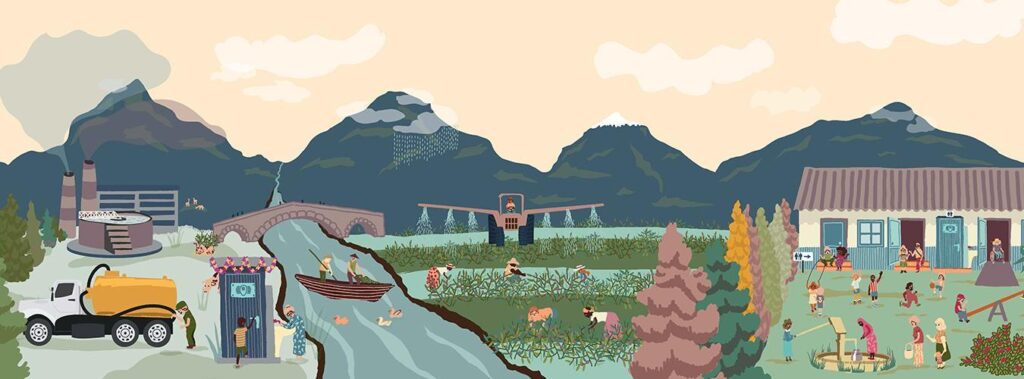
Photo by UN-Water Project
When some people in a community do not have safe toilets, everyone’s health is threatened. Poor sanitation contaminates drinking water sources, rivers, beaches, and food crops, spreading deadly diseases among the wider population.
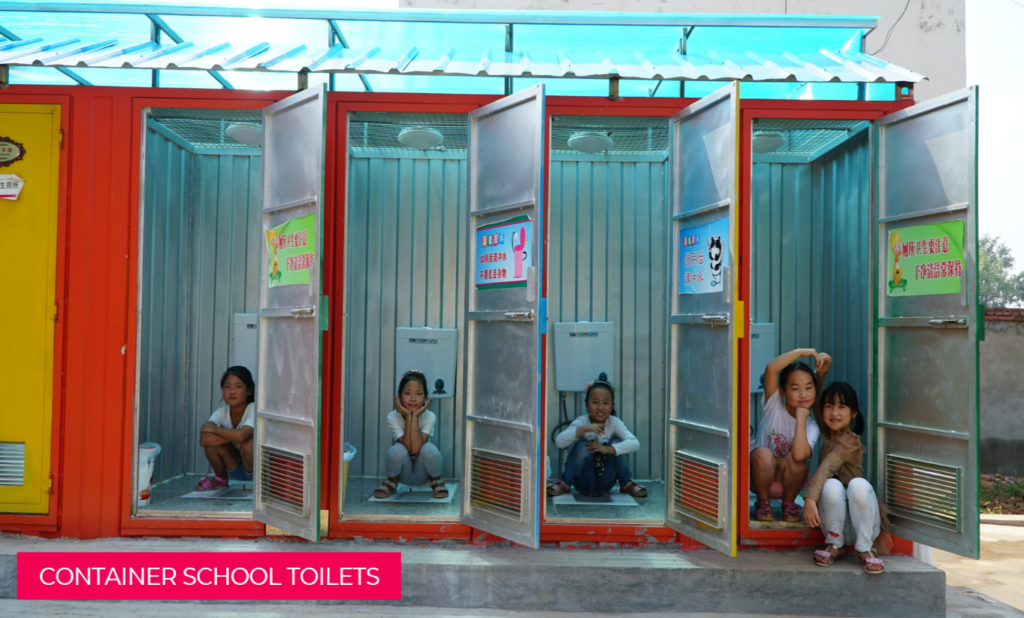
Photo source https://www.worldtoilet.org/rainbow-school-toilet/
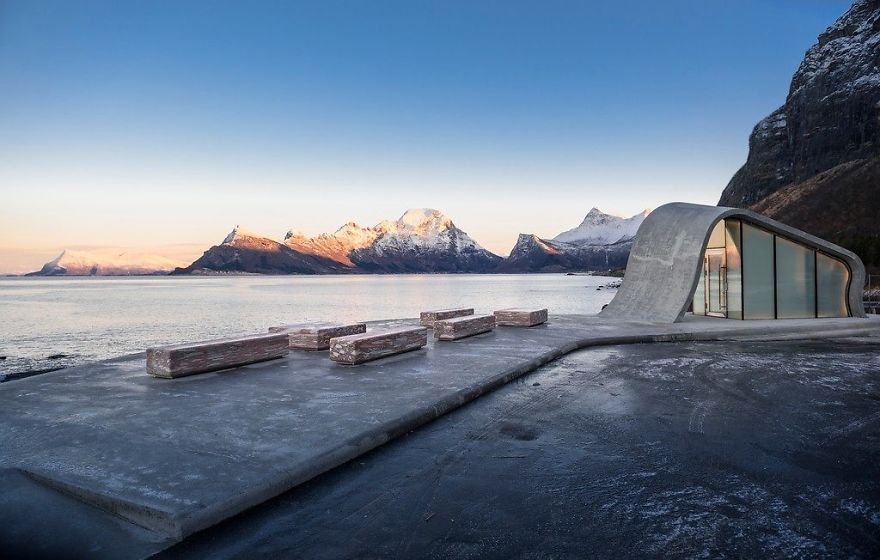
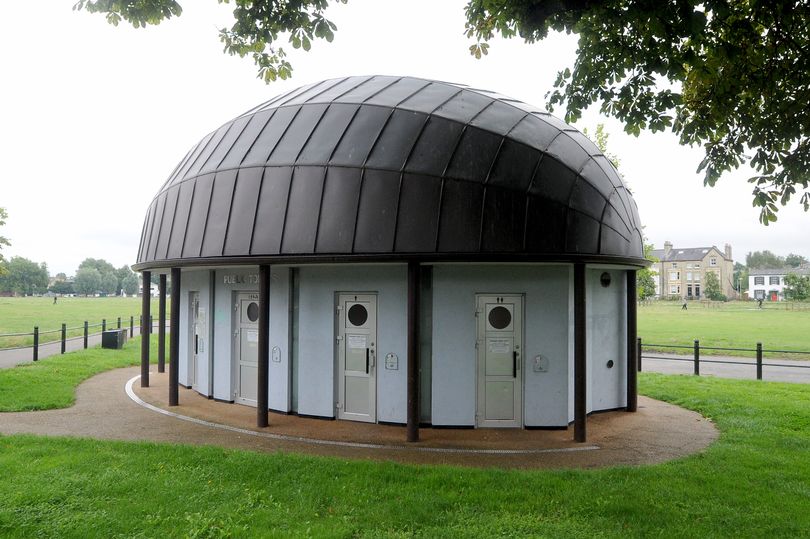
https://europeforvisitors.com/venice/articles/public_toilets.htm
Carry change for toilets, which often have turnstiles at the entrances. Public WCs of AMAV, the Venice sanitation authority, charge a mind-boggling €1,50 unless you have the Venice Connected pass. Larger museums (such as the Doge’s Palace) have attended restrooms with posted fees. In other museums and galleries, toilets are often free.
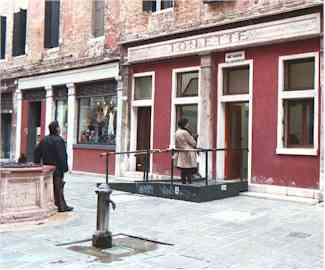
https://says.com/my/imho/please-stop-doing-these-in-public-toilets

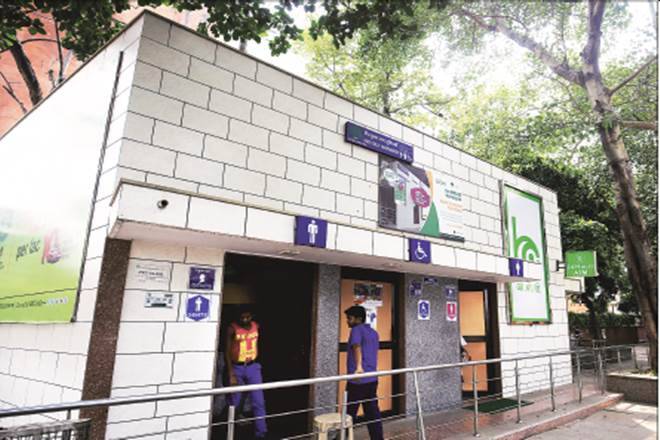
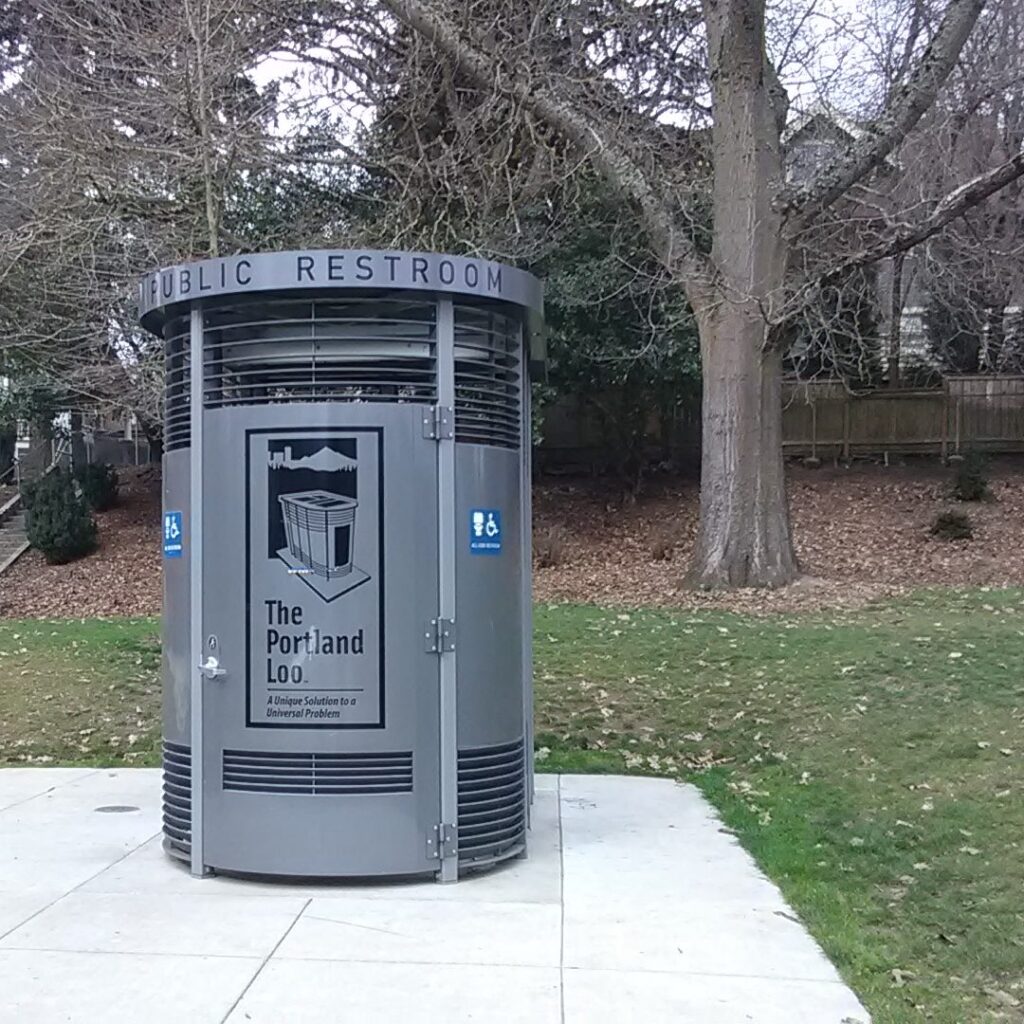

source: https://www.dezeen.com/2020/09/14/tadao-ando-toilet-tokyo-jingu-dori-park/
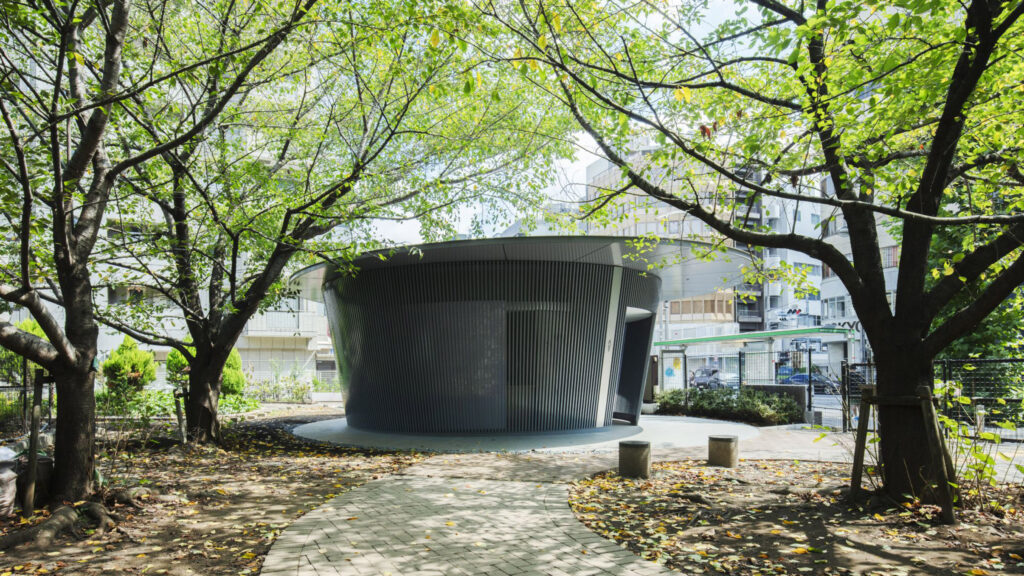
Pritzker Prize-winning architect Tadao Ando has completed a circular toilet in a Tokyo park as his contribution to the Tokyo Toilet project.
Built-in Jingu-Dori Park, the toilet was created as part of a scheme run by the non-profit Nippon Foundation to upgrade public facilities in the city’s downtown Shibuya district.
The initiative has already been seen by toilets built by Ando’s fellow Japanese Pritzker Prize-winners Fumihiko Maki and Shigeru Ban.
Surrounded by cherry trees in a small park around a five-minute walk from Shibuya Station, Ando derived the toilet’s shape from his desire to create a structure that enhanced the park.
“I sought for this small architecture to exceed the boundaries of a public toilet to become a ‘place’ in the urban landscape that provides immense public value,” said Ando.
“Using this clear and simple reasoning for the concept of this structure, I chose to utilize a circular floor plan with a spanning roof and engawa [Japanese porch].”
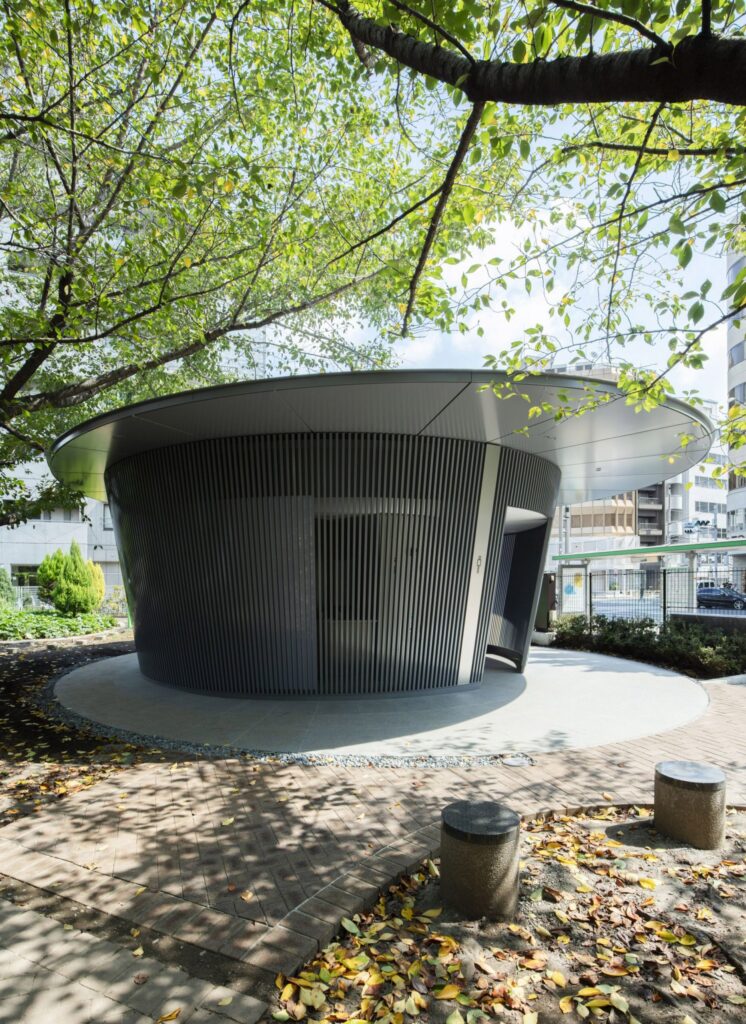
The circular toilet block, which contains a male, female, and accessible cubicle along with external sinks, is wrapped in a wall made from vertical metal louvers. This wall creates privacy while letting air circulate.
The whole structure is covered with an angled roof that overhangs the toilet to provide shelter.
“It was vital for me to make a space that was comfortable and safe,” said Ando. “Visitors can move inside a cylindrical wall of vertical louvers to feel the comfort of the wind and light from the surrounding environment,” he continued.
“A feeling of safety will be emphasized by the free and centripetal circulation which passes through to the other side. This toilet tucked away in the greenery that is Jingu-Dori Park will be known as ‘Amayadori’.”
Ando’s toilet is the sixth to be completed as part of the Nippon Foundation‘s Tokyo Toilet project. Shigeru Ban’s toilet design comprised a pair of transparent blocks, while Fumihiko Maki topped his toilet block with a “cheerful roof”.
Nao Tamura based her bright red triangular toilet block on the Japanese craft of Origata and Wonderwall referenced primitive Japanese huts for its design. In total 16 toilets are planned as part of the project.
Photography is by Satoshi Nagare, courtesy of The Nippon Foundation.
by https://www.wim-wenders.com/news/
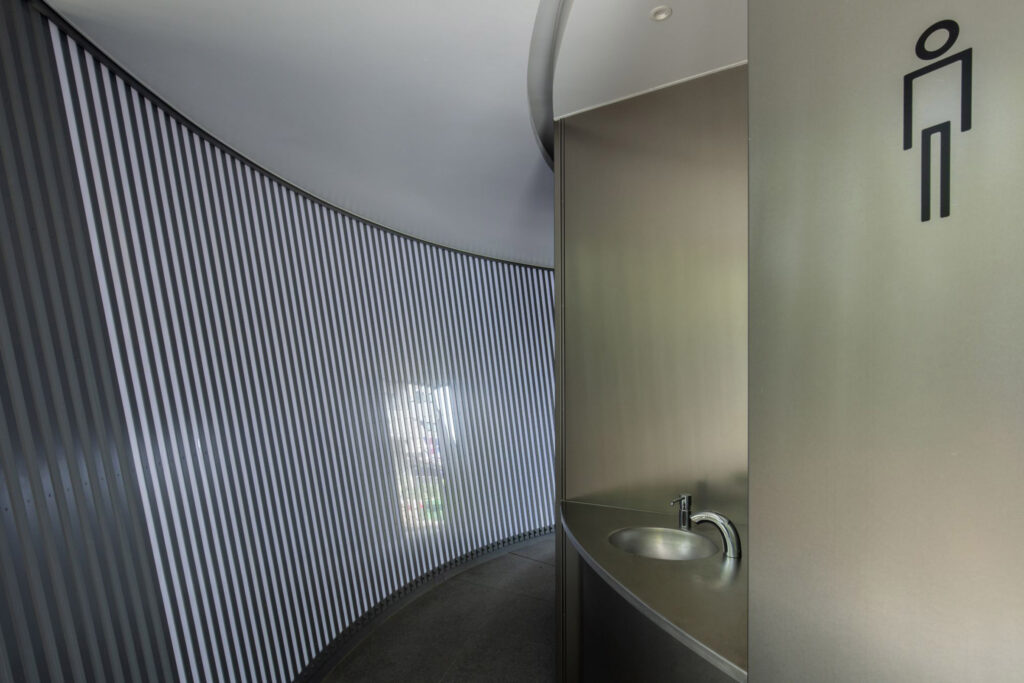
Harvard:
24 Pages
10” x 16” printable areas
Must be re-configured for posted version
Permanent
Maps with locations of Social Services, Bathrooms, Transit, Help (1)
Historical Info (2)
LightWheels.com (1)
Route and highlights (2)
Ad Directory (2)
Changing periodically
Political Cartoons (6)
Events (2)
Local contributions (6)
Artistic
Opinions
Achievements
Problems and solutions
Job openings (1)
Space available (1)
Total 24
The new Mayor of New York has made it one of his first priorities to reduce the number of roadway casualties in that city to Zero, from the 271 who currently expire each year, in addition to the 65,000 who are injured. This is more than an ambitious and very difficult, though thoroughly admirable, goal. It is really an effort to evolve the entire population of this place, past the assumptions of unavoidable brutalities that this transportation system invariably provides, as a “normal” feature. It is gratifying that the Chief Executive seems to understand that the need here is tectonic and not cosmetic.
Partly this is a matter of enforcement. Setting up an operation in Brooklyn where cars were ticketed for failing to yield to pedestrians was a trial balloon, to see if the publicity surrounding this was sufficient to have an effect on driver’s behavior in the short and long run. Another much less successful effort, to ticket pedestrians for jaywalking, became a disaster when a Chinese-speaking man was apparently thrown to the ground by a police officer and sustained head injuries. Regardless of such anomalies, everybody understands that the ultimate purpose here is to reduce harm to unprotected pedestrians, and cyclists. In a city with a 30 MPH speed limit, 60 MPH is standard. The Mayor is the Commander in Chief of the Police Department and he can single-handedly direct a comprehensive overhaul of our traffic rules and how they are enforced.
I believe that the other most important factor in engineering this change will be the rapid proliferation of small, safe, human-scale vehicles, to replace the far more dangerous industrial-scale ones that currently dominate the landscape. Not only will this result in saving many lives and preventing numerous serious injuries, but it will also provide major health, environmental and other significant benefits to society. Regardless, It is not going to be easy reining in the taxis, flying down the street, the enormous garbage trucks and buses, and huge SUVs with their relatively limited vision.
In order to accelerate the process of providing ourselves with a new range of vehicles, we will need to incentivize the designers and builders of these devices with both recognition and financial benefits. Pavlov proved that animals are motivated by rewards and will respond to them in a predictable way. Since there is no marketing venue for these objects their introduction over time has been nearly impossible. The advent of the internet and its means to inform the public about novel ideas and attainable objects can help to overcome the historical resistance of the conventional marketplace, bike shops, and car dealers, to provide us with access to these machines. When Rob Cotter used Kickstarter to get his seed money to produce the first multi-modal ELF it signaled a new channel opening up between makers and those who know that this is a vital path to explore. Building on that realization is a new task and a welcome one. His current success in expanding his enterprise will alert many to the increasing value of these new opportunities. Hybrid human/electric-assist vehicles are the wave of the future, and nobody can deny it anymore.
It is not a motorcycle but it is a cycle with a motor, so even the language conspires against us. It is built on the scale of a bicycle, minimal, so the contribution of human power is relevant, and the stored energy is supplied through advanced design batteries rather than fossil fuels, petroleum, so it is considered exotic. In fact, many of the best designs were already made in the 19th century and will simply need to be updated for this day and age.
The contributions of creative people, artists, and craftspeople are the critical element. The importance of fresh thinking and the use of incredibly durable materials, like polycarbonate and composites, will change the game. Just this week it was announced that an important breakthrough had been made in the use of sugar in batteries, far more powerful than current ones and much cheaper. The amount of effort going into the research into nanomaterials, carbon fiber and all the rest is bringing home the relevance and importance of weight and scale in the design of better forms of transportation.
Mr. DeBlasio’s declarations about safety need to focus on the greatest challenge, reducing the throw weight of the lightly-guided missiles that fill all of our streets. As long as something has a certain bulk and weight, it is automatically a candidate to be regarded as an offending object due to its potential to do harm. The problem with industrial-scale vehicles is their momentum, calculated as weight times speed. Being hit by a multi-ton object moving at 40 miles per hour is often fatal. When the speed is reduced to 20 or 30 miles per hour this hazard is greatly reduced. When the weight of the vehicle can be measured in tens rather than tons of pounds, the risks are practically eliminated. Human-powered, electric-assisted vehicles are nearly on the same scale as a person walking along a road. At the 10-15 MPH that they normally move, the danger is further made smaller and the visibility provided by a relatively open design adds to their safety too. Of course, they must be operated responsibly.
The Mayor is to be commended for taking on such an important task but errs, at least modestly, in his campaign against carriage horses in this Year of the Horse on the Chinese calendar. We need to remember where we came from and to cultivate our awareness and appreciation of our ties to the rest of the animal kingdom. You don’t have to raise goats or love mice but making the connection to your fellow species and acknowledging this linkage is a good thing and along with such arts as handcraft and Yoga, puts you in touch with forces, otherwise invisible to the naked eye. Muscle-power is awesome, both our own and that of other creatures, and recognizing its appropriate role in a world ruled by mechanical and electronic forms of power is essential to our self-understanding and self-realization.
Whitey, the horse that pulled my Father’s fruit and vegetable wagon along, in the early years of the 20th Century, made it possible for him to cover enough ground to pay his bills, start a family and make his way up in the world. How could he have done it otherwise? The tiny One Horsepower motors required to help food deliverers and pedicab drivers do their jobs without having to punish their bodies are just as vital to our ability to provide a humane and decent world, as is our willingness to co-exist with our natural counterparts.
Banning little electric-assist motors, for no real reason, is just as cruel as it is to send the carriage horses to their doom, to erase them from our sight. Because of the excellent fertilizer that they manufacture can not find its way to a Community Garden nearby? It seems, in fact, that they are extremely well taken care of, at least at the current time. Replacing them with multi-ton “replicas” will only heighten our sense of artificiality, Disney on steroids, which is already far too prevalent, and permanently wipe out one of the few fragments of natural and historical authenticity remaining. Sadly, Mr. Mayor, It will do this harm while simultaneously reinforcing the mistaken and unhealthy sense of entitlement, that the oversized and overpowered urban-inappropriate forms of transportation, that are so hazardous to our health and which currently dominate our space, depend upon. Let’s hear it for muscle-power (with just a little electric-assist please).
The original colonial Tea Party was a bit of blame-the-victim, racist, black-bag op terrorism, with a spoonful of patriotism, and so is the current one for many of its most passionate adherents. The difference is that back then, we were rising up against protected monopolies and giant corporations, whereas the current version is largely funded by these megaliths.
We can do better, much better. If we need a theme song, how about the Automat’s egalitarian and inclusive “Let’s have another cup of coffee”? We can organize friendly people in all the coffee shops and let the people who have trouble with including everybody have tea shops. We can have Starbucks and the corner diner and the morning breakfast table and they can have the crumpets. We can have meetings morning noon and night, all over town, to figure out how to take back this puppy from the beast. Confused and frightened people, looking for help are being told, ”Sharing is Socialism”. So elevators and trains must be hotbeds of Marxism, and water mains and sidewalks a sinister, devious plot, to tie us together and make us dependent.
So what is COCOA, Coffee Conversation Action? It’s not a Party exactly, (even though a little fun is always a welcome relief from the tedium), or a means to anoint the already too self-important with additional titles and privileges. Rather it’s a minimal mechanism for building an energetic, ongoing, constantly-evolving plan to maximize the chances that our species can have a healthy future on this rock. It is also an action agenda, without hysterical, lying demagogues, and without non-stop, one-dimensional self-interest masquerading itself as the common good and crushing our humanity in its path. We had sound-outs and teach-ins, but we need a continuously-refreshed framework that frees us with the truth instead of confining us in lies, open for business wherever and whenever sippers meet.
That’s the Coffee Conversation Action Agenda, COCOA2. Namely: Move over a little so there’s room for everybody and when it’s freezing out there, who doesn’t need something hot to drink to help take off the edge? No matter how cold the facts get out here, friend, in the coming days, please remember what your Mom told you about what you had to do if you wanted to get into Heaven, and make mine hot Cocoa thank you, not hate-filled Cuckoo.
We need water, air, and the occasional snack, to survive. Clothing and a roof over your head may not be quite as essential, depending upon local climate and social customs of course, but are still pretty important. If you are a person of deep faith, you have the conviction that all of this will arrive, in good time, due to the grace of the Almighty. All that is required of you is patience and fortitude and the ability to suffer the pain which comes from realizing that there is still something missing from this picture. It can even feel as if all of this seemingly undeserved and unnecessary distress was put there on purpose, to put your faith to the test, since it feels otherwise to be so purposeless and random.
If you are more modern in your ideas, you might consider it the job of the government to make sure that you can fulfill these basic, human needs. Some would put companionship in the “absolutely needed” column too, but, aside from our sentimental preferences, we have a demonstrated ability to exist, even prosper, without any nearby two-legged accomplices, for quite some time. Got to have drinkable water and breathable air no matter what though. So why are our supplies of both under attack and in jeopardy? Are we completely out of our minds? Do we think that playing Russian Roulette with our essentials makes the game more interesting, raises the stakes and creates excitement out of the mundane? Is it possible that what we have always taken for granted, as belonging to us, is being completely commodified, and that everything has, or will soon have, a price tag, even the air we breathe?
Meanwhile, if so much has been reduced to numbers, pushed so far into the abstract that we can hardly recognize its connection to our reality, how do we push back and reassert the need to recognize, acknowledge, even celebrate that linkage? Since passivity is the ocean that we swim through to reach our life rafts of activity, it is no wonder that there is so little coordination amongst us in this continuous, ongoing process. Each person is too involved in staying afloat, paddling towards their destinations and making sure that there is plenty of oxygen in the immediate vicinity, to worry much about anybody else, except their own blood and kin.
So, if a problem arises which requires the coordinated effort of these various arbitrarily-distanced souls, there is no mechanism for enabling that to take place. The institutions we formerly relied upon, as narrow-focused as they were, religion, proximity and the rest, are moribund. Sports teams serve as place setters for real community and symbols replace actuality. You root for the home team, maybe win a few and probably lose the rest. Then a Karina happens and we are all brought back down, for a little while, kicking and screaming, to reality. Then the Dream Machine kicks in again and we are glued into our easy chairs, back on the program, waiting for the next wave to break.
The ultimate injury suffered here can not be quantified and in most cases does not even have a name. It is embodied in a concept which we named “empathy”. It is the ability to share someone else’s pleasure or pain, accomplishment or loss. It is natural to us, as is the mechanism which permits us to shut it off and become absorbed in ourselves. If you listen to popular music, the most common word in songs is always “you” and close behind that “love”. The focus is constantly directed to the other, because that is where your affirmation lies, with your lover or your child. The ability to care more for them than for yourself is the path we have been given to escape the tyranny of our own bodies and selves, to displace our attentions and affections on another. Since the other primary drive programmed into us by our natures and our conditioning is to focus on ourselves and to relegate others to bit parts and extras, this is the exposure of our centers to the light, the closest we may ever come to a revelatory experience.
When we can provide all who are alive, and all that is alive, with the grace afforded by these flashes of unselfishness, and unification with what is outside of ourselves, this can be a long sea voyage to the land where change lives. Without mechanisms to sustain you on your way, it becomes very difficult to hold your course though, so we need to become designers and builders, to re-form the institutions and methods that we have contrived, or which, in most cases, been imposed on us over time. Since so much of this existing framework was contrived with only minimal feedback from the consumers of all of this society-building, there is a lot of slack to take up.
When the equipment provided to us to help in our encounter with raw nature has been in the manner of weapons, to force nature back into a predictable and beneficial state, for the sake of distributing better prizes to the populace, there is no reckoning of the long-term effects of so much manipulation of our resources. This is a giant experiment gone off the tracks. Literally, when it comes to trains and figuratively when it comes to everything else. Take the food supply. Here is one thought about how to help put it back on the tracks.
PUCK magazine, in downtown New York City, gave political satire its most powerful boost. Its momentum has propelled it 150 years into the present day in the form of Comedy Central and millions of youtube videos. The impatience of these cartoonists with corrupt politicians, greedy accumulators and the webs they jointly constructed to rid us of our fortunes and futures, put them in the role of wise surrogate parents, preparing us for the real-world conditions that we were going to have to face in the post Civil War economy and society of the United States, in a difficult and fast-changing environment. PUCK U. printed 80,000 gaudy diplomas a week and awarded them to anybody with a thin dime and a little time, to laugh at power and privilege and its alleged prerogatives.
In the print world, it revolutionized its impact with full color. This took the movie industry another half-century to do and the Electronic version still another half-century. Mobilizing amazing humor, courage, and wit, it is a MAD magazine, Vanity Fair and the New Yorker today, and most lately CHARLIE HEBDO. If we did not have the benefit of the perspective that the revelations of absurdity provide, we could not survive the strange occurrences that surround us daily. Without the ability to capture and highlight the obvious, and often unavoidable contradictions, that arise out of the self-serving testimonials, of all of the one-dimensional purveyors of this ideology, or that web of mystical beliefs, how can we sort through them and figure out where we stand within them?
Our teachers are Socratic and skeptical and need to be since there are so many contrary notions competing for your fervid loyalty and so little proof that anyone is any better than all the rest. Many of us sift through the lot of them and pick and choose elements that appear to hold together, the way you would in a supermarket, looking for ripe ideas, squeezing them to ratify their readiness to be consumed. You do this at the same time as you are computing the value of venturing down the paths currently on sale, seduced by their sometimes ridiculously low prices, or put off by the high tariffs. We’re careful shoppers but we’re also captives of our habits and histories, and not that interested in what the person next to us is doing. That is until the walls start shaking and the small stuff starts mattering a whole lot less.
If you are going to hold up to ridicule those who have the means to harm you, the rich and powerful for instance, you must accept the possibility that they will take offense and try to do something to lessen your ability to do them damage. They may buy your publication and find a new editor or withdraw their advertising from it or start their own. When PUCK magazine began to exert its influence, a group of those with opposing views, mostly defenders of the status quo, formed JUDGE, a practically identical journal in style. They pirated some of the PUCK’s best cartoonists by offering them higher remuneration and relied upon the code of the illustrator, which is to give the client what they ask for, to deliver them of a counterbalance to their rival’s popular messages. Fortunately, the public appreciated the quality of the original and remained loyal to it, and it enjoyed a longer and much more robust influence than its copycat’s.
The co-option of anything is still one of the most insidious and dangerous effects that economic competition can produce. It is easy for the most powerful truths to be diluted down to punchlines in a situation comedy, with a laugh track primed to hold up to vigorous ridicule, any serious deviation from “acceptable” behavior. We are constantly being conditioned to enforce stereotypes on all individuals and commentaries according to categories that we hardly knew existed. There is even, inevitably, a character who is charged with challenging convention who must be portrayed as too complex to really understand, or secretly conflicted about his, or her, identity or worth. Our attitudes are manipulated the way a piece of french bread dough is, pulled and pounded and shaped until it fits the popular mode and then baked into its permanent shape. Unfortunately, a lot is lost in the process. Think of the difference between a perfect baguette, still hot out of the oven, and its fluffy replica, sealed in a plastic bag and devoid of taste, crust or character and you have the model of the actual in all of its glory and a world of sad phoniness.
It is true that creativity is not easy to find. We are, by and large, copiers and adaptors. Nothing wrong with that but the accompanying self-congratulations and inevitable egoism which is associated with calling oneself an “artist” or a creative person in general, too often barely conceals an army of sycophants copying somebody else’s homework not tortured souls giving birth to difficult notions. Repeating the mistakes of the past, endlessly, by dressing them up in new costumes and disguises, preserves a sense of freshness on that which is perched on top of a mess of out-of-date rottenness.
The common bicycle broadcasts a powerful and important message, just by its existence. If “lighter is better”, a principle that has invaded and conquered the information and communication universes lately and lain them to waste, is applied to transportation, the age of the “bike” is upon us. The Internal Combustion Engine, ICE Age, is already over and what TESLA doesn’t turn into yesterday’s news, the “Shareable” and “Wearable”, pared down to its minimal expression, will. The opposite effect is happening in many parts of Asia like Vietnam and South Asia like India, where heavier motorcycles (some admittedly electric powered) are replacing bikes, as symbols of higher status.
Being carried along, without conspicuous effort, can feel almost magical. Preserving the element which can be defined as “self-propelled” or “muscle-moved” is essential though, for any vehicle that wants to call itself a “bike”, or it just becomes another kind of motor transport, and we certainly have enough of them already. We may be lazy by nature but there is no doubt that this is the way we are being aggressively nurtured. Self-drive cars? Will robots shave you too and brush your teeth? Can you manage a fork and knife at the same time so that your food can be broken down into bite-sized pieces or will that need to be done for you too, like you were still two years old? If you are too weak and rendered unably, it is understandable. Otherwise, it is not.
At the same time as we are miniaturizing the personal equipment that we depend upon for many tasks, the systems that maintain these devices are growing larger and more consolidated. This is a good thing in many respects because the economies of scale provided by this massive adoption of personal communication devices have brought the costs down considerably. Meanwhile, there is the ever-present danger that this consolidation will result in huge monopolies that will manipulate the charges and raise them into the upper atmosphere while thwarting better technology and ignoring risks to the environment or insults to human dignity. The beneficial effects of competition can evaporate on overheated trading floors. There is also the matter of tacit conspiracies in various industries, among the few large companies that invariably control each one, to maintain a certain level of charges for all of their sakes. This is not just an attack of paranoia either though these kinds of tacit arrangements can not always be proven very easily, no matter what the facts clearly reveal.
The recent victory for “Net Neutrality” gives hope that concerted action by millions of stake-holders can influence public policy after all and restrain the influence of the largest factors. This is not the way that these things usually are decided though and it is not easy to keep your constituency constantly on the alert and ready to send in all those emails and sometimes it just doesn’t work, no matter how much effort is put into the struggle. If you do care what is going to happen next, you are already used to the hills and valleys that make up expectations and accomplishments, so you are also used to that rocking motion while you’re rolling. Eventually, we are going to fully remember how exciting the creative process can be, when you are not so frightened to use it that it is locked in an access-proof vault, in a part of your mind that only comes into being in your dream-life.
Please visit www.LightWheels.com for some examples of what I think are the missing links in our current transportation systems. My intention is to build them. If you want to help, let me know. Also please consider making a comment about them, sweet or sour, in the space provided below, to help spice up this bubbling stew of words.
Pickers and gatherers of produce, People getting their hands dirty, by pulling roots and breaking stems, filling baskets and boxes, are making about a penny a pound for their work, give or take. When the final products of their efforts are passed along to the consumer, the price will be measured in dollars a pound.
If retailers were willing to mark prices in increments of 5 cents (not a common figure currently) this could be used to signify that they are passing this much down the line, to these hard-working men, women and children, an additional 5 cents per pound for their hard labors. Consumers can make certain this way that those employed to supply them with their needed nutrients are being compensated in a more reasonable way than is common today.
How are foreigners and migrants going to be able to keep track of and report what they are due? Rewarding cooperating growers with better sales will help and a well-monitored program of verification and tracking of funds. Of course, a mechanism must be implemented, to make certain that these funds are not diverted before they reach their intended recipients. For these reasons, one cent of the five will need to be used to devise and operate an efficient and honest process to make certain that everything works as well as humanly possible.
Any funds not needed to administer this program are to be used to enable other populations who are accustomed to receive a minuscule portion of the profits generated through their sweat-fueled efforts, apparel workers, etc., to accomplish this same purpose. Perhaps clothing prices will include a 25 cent additional payment to the gatherers of the raw materials, along with those who sew or dye the cloth, with $.25 prices reflecting retailers’ participation.
Will employers simply lower wages by the amount of these “bonuses”? Unfortunately, some will try to, so effective means must be employed, and constantly improved and updated, to thwart humanity’s worst impulses and habits or nothing will change. Great public shame must be heaped on criminals who rob the poor to help themselves and they must know that they will be identified, blackballed and ejected from civilized commerce.
The details needed to make this a reality must be gleaned from a number of conferences, by telecommunications and in person, and the participation of all those to be affected by these measures, workers, growers, retailers, distributors, and consumers of food. Time is of the essence since this has already taken far too long to implement. These actions must be carried out in harmony with not in place of other attempts to improve the working conditions of all farm laborers.
While there is almost no image more elegant or romantic than a person simply riding a bike, we are constantly being enticed into embracing something grand, a car, a nice big house, which is intended to inflate our sense of well-being. Seldom on display is the ragged couple, exhaustedly dragging themselves into that home, in that car, the lines of worry deeply etched into their foreheads, trying to figure out how they are going to make the next payment on these behemoths or finance a needed repair. Of course, the second home, or second car, has now entered the picture and how can the Jones’ ever keep up, when it is only a matter of time before the next generations appear and begin to assert their right to all that the earth provides, without limit? The Merry-Go-Round keeps spinning faster and faster and even historic floods and droughts are not enough to slow it down enough to get on or off, without the aid of an accompanying power failure.
Now that the school year is in full gear it may be instructive to project oneself back into the time when each of us was enrolled in one of these august institutions. Fitted with a book-bag, (now a backpack), we were dropped off, or made our own way, into a crowded classroom filled with kids just like ourselves, wondering if we would be able to do what was expected of us and meanwhile get along with the others. Another big issue was behavior. If the teacher was temporarily absent we spent the time ribbing each other over something trivial, an article of clothing or a new haircut or misspoken word and the wisecracks and teasing went on until the teacher appeared. Often, for at least some of us, that was not enough to stop the errant activity, but soon order was restored and the sound of chalk on slate brought us back into line. Some kids kept it up, as often as not, and had to be shushed or berated to sit down and behave themselves. Restlessness prevailed regardless since the young are naturally energetic and spontaneous until they have been tamed and disciplined into orderly automatons. Slowly, the pressure to conform and fit in is applied and few escape its gravity.
Most of us could not wait until the time between classes when we could have a few minutes to whoop it up and get to the next classroom. This varied from grade to grade and kid to kid and the rules of the school about talking and being restrained in our behavior, but the time gaps between sitting there, and being told not to move around too much and keep quiet and not disturb the class, were precious. Even more important, in the midst of all those calls for self-control, were lunch periods and recesses, where you could move about more freely and express yourself more completely, where you could, in effect, be yourself. Since we are all different and especially when it comes to how we regard and relate to others, this was a unique experience for each of us and could be troubling if you didn’t think you fit in quite right or had problems that few recognized or related to very well. Peer-pressure starts early and has a powerful effect on all of us, although much more on some than others. Going along and doing well is the most important thing for many, while the opposite is true for a significant number of others and these patterns can continue for a lifetime, for quite a few.
There are some factors that affect everybody in that class though. You must become comfortable in a seated position, facing forward and being as passive as possible. Sure, you need to answer a question if the teacher has one, although not too eagerly or often or the other kids will think you are a nerd or kiss-ass. Acting or speaking out of turn will earn you a reprimand and really outrageous behavior on a trip to the Principal’s office. If you do it often enough you will get some pills to take and will be regarded henceforth as a troubled child, in need of extreme discipline or worse. Order is what matters and going along with the program. There are too many bodies to manage and not enough time to master the essential skills, reading, math, and comprehension, so there is no time or patience for being too spontaneous or expressive. This is a giant Viking ship and all of the oars must be pulled in unison or the voyage will be delayed or misdirected. We are being trained to be little conformists, to find our rightful places and fit in so that needed jobs can get done and good order preserved. Ergonomically disadvantageous sitting down becomes more natural than standing or lying down. Or running.
Consequently, for many, sports becomes an important release. There is the ability to get physical at a time when the body is growing and vigorous activity provides an outlet for the energy that we possess in abundance and is always looking for a channel to express itself. There can be tension too, (do you make the team, are you good enough, is your team a winner?), but the participation alone is gratifying and healthy if it doesn’t get too competitive. The bad news is that recess is in a recession, takes away valuable time from studying for the standardized tests that teachers and principals are judged on, requires resources that are in short supply and is being eliminated along with the music and art programs, that experience shows do so much to motivate and improve attitudes. We are in a death spiral when it comes to providing a really well-rounded education, along with the memorization and drills. The impact on our mental health and ability to truly understand who we are and where we want to go in this life are being short-circuited and demolished, by one-dimensional measurements and lack of depth in these venues.
Why is it so difficult for this society to get the point about what matters the most and how to reach it? Mostly it comes from a lack of understanding of the nature of society and how it functions. A cab driver from Haiti last week, a hard-working fellow enjoying the music on his radio, commented about the life here and the lack of connections among people. His country, one of the poorest on the planet, with deprivation as common as sunshine, is a wonderful one to him he said because everybody regards each other as family. What is good for you is good for me. Here, we are all in a race, sometimes described as one between rodents, and what benefits your neighbor may mean that it is costing you. The media embraces this message and amplifies it until it is deafening. If your own kid is doing great, that is what matters. If your city’s team is winning you should be happy. If your country’s economy is improving, who cares if the other guy is in trouble. What is missing from the picture is the way in which your economy is dependent upon the other’s, that their problem is soon yours. If the educational system is producing mostly losers, unsuitable for more than the merest tasks and rewards, how long will it be before this malaise undermines your own kid’s fortunes? This lack of connectedness is fatal to the big picture’s health, and so-called recessions elsewhere can easily turn into depressions here.
One way in which this process has evolved has to do with the wealth which is now in the hands of different races. We are now aware, following the economic disaster recently barely averted and still poised to swallow us all in its potential aftershocks, that the material holdings of those called “White” people, conventionally those descended from Europeans, is 20 times that of those we call “Blacks” or African-Americans. Latinos are only slightly better off. Is it any wonder that vast swaths of our population regard themselves as persecuted and unfairly treated? Certainly, it does denote a shocking disparity and distance from the egalitarian ideals that we are all taught to embrace and respect, as part of the American ideal. Furthermore, does it come as a big surprise that the average person, of any race or nationality, living from week to week and enveloped in insecurity, feel immersed in worry?
Our habitual wasting of the material resources that have been provided to us, (whether or not we deserve them), is nothing compared with the waste of human resources that we perpetually witness every day all around us. It is so considerable that it barely scratches our consciousness. Nowhere is this more obvious than in transportation. Whereas one horsepower is enough to get us where we are going, we expect to have 200-300 to get the job done, without a second thought about all of the resources needed to feed that mighty herd. 80% of the time, only one-sixth of the seating capacity of the vehicle is in use. I can remember many long hours standing by the side of a windy or rainy highway, wondering why nobody would consider sharing that empty space with a needy, non-threatening looking civilian, with his thumb hanging fruitlessly in mid-air. This machine sits idle 90% of the time and that is alright we compute since it is there when we want it, with nary a thought about who might really need it at that moment. It is giving us a wide variety of maladies, from heart disease to diabetes, kidney malfunctions, and bad backs, but we think it is an unalloyed blessing. We are deluded and living in a fantasy world constructed from TV commercials and smug assumptions of our superiority and dangerous fantasies in regard to the permanence of these conditions.
Lately, I have spent a lot of time making models of tricycles with a variety of features that are missing from our conventional forms of mobility. I wonder why, since we ordinarily avail ourselves of a variety of postures during a given day, from prone to standing, sitting, leaning, maybe even crouching, we have been conditioned from an early age to sit, the most unhealthy of them all, according to medical authorities, almost all of the time. Your car, your desk, your dinner table, and train or bus, all demand that you assume this position and stay there. The conveyances that I am currently construing, permit the assumption of the widest number of different body positions that are possible. In school, past kindergarten, as I have just asserted, sitting is the only permitted way to position ourselves. We are not even given the choice between a tall stool and a conventional chair. We may not crouch or stretch out on the floor lest we get “dirty” or encourage undisciplined behavior. It is either follow the rules or get out. Instead of listening to our bodies, which crave some difference in attitude and position, we are commanded to obey, and we do. It is claimed that there is an inner logic to this, that we are too young and stupid to understand, but really it is just for the convenience of our managers, who want to encourage “responsible” predictable behavior and who must enforce their commands without fail.
The second variable element is the source of the motive power, conventionally either a motor or leg power. To these choices, I would like to add arm power as well. The “Rowcycle” is one already well-developed example of this. To these, I would add the choice of an electric-assist motor as well. The combination of the three, arm, leg and motor, is superior to any one of them by themselves but is virtually unavailable in any vehicles with the exception of some recumbent and disabled vehicles that use two or more of them in tandem. Why not all three? Because it has not been the rule up to now and we are creatures of habit and captives of the conventions that have been most popular. Some of it is technological since the advent of lithium-ion batteries has now made practical the inclusion of electric-assist motors on primarily human-powered vehicles easy and economical. Mostly it is the difficulty of popularizing any radical variations on what we have been accustomed to. There is no retail marketplace that is available to sell and display and offer free test rides of these variations on the usual, so they are virtually invisible. The internet will change that somewhat but the pace needs to pick up much faster and that will require more ambitious and energetic ways to get the word out.
In addition to needed changes in available postures and power generation, there is the matter of rolling resistance and road condition. (Ignoring for the moment such heavyweight considerations as self-image and convention). Two wheels have many advantages over three, most of them based upon the greater efficiency of a single-track vehicle over one with three tracks like a tricycle. These advantages disappear when the need to minimize the weight of the vehicle is reduced due to the addition of the electric-assist motors. Lessening rolling resistance demands high-pressure tires, and the increased bumps and shakes produce by the triple-track vehicle makes the ability to steer around them of a single-track machine vastly superior. But if you can use bigger and softer tires, which are much better at absorbing these imperfections of the roadway, that advantage inefficiency is reduced greatly and more than made up for, by the increased stability and utility of a three-wheeled device. Since we have just begun to enjoy these electric-assist motor benefits, the advanced design of these three-wheelers is in an infant stage. Creative designers are just beginning to evolve the formerly slickly-aerodynamicVelomobiles of yesterday, into the comfortable and safe and reasonably-efficient, rather than maximally-efficient, conveyances of tomorrow.
Weather protection is an essential feature of any up-to-date vehicle. Rain, hot sun, wind, airborne grit and dust, cold, all discourage riding out in the open all of the time. In order to become the ordinary means of transport, a vehicle must be able to protect the rider against the worst effects of these annoying elements. Nobody expects a car, or bus, or train, to expose the rider to a host of unhealthful and disturbing elements but bike riders bundle up and assume that this is part of life and unavoidable. This reduces the number of users of human-powered vehicles tremendously except in the most forgiving climates. Putting an umbrella above a bike is to invite a gust of wind to carry you into oncoming traffic, a dreadful thought. Assuming a lower position, (while providing visual signals of the presence of the rider, flags, LEDS floating above, streamers and the like), offers great advantages, through a lower center of gravity, aside from greater comfort at times. Additionally, Three wheels and an electrical-assist motor and its batteries, add weight down low, where it contributes the most to safety, and guard against the negative effects of the increased surface area that weather enclosure requires. We have some wonderful weather-resistant and very lightweight materials available today that allow for tight, transparent enclosures to be made that can be easily stored when not needed, so this improvement in the usability of the vehicle can be deployed only when necessary. No industrial-scale vehicle can offer this kind of variability to the rider. Tiny battery-powered also relatively easy to provide and wind-screens are easy to deploy on stable tricycles.
The bike is essentially a single-person device. There are tandems but they are rare and require good coordination between riders. With appropriate designs, we can have side by side or tandem-style multi-person human-powered vehicles that, because they are on a stable three-wheel platform, do not require anything special from the riders. One could even be severely-disabled and it would be of no consequence. Even three or more people could ride on a single vehicle with no problem. We have sen this so seldom that we don’t consider it even possible, but it is not really a problem, just very unusual. The multi-person ”Sociables” of the 19th century laid the groundwork for this development but have, sadly, subsequently disappeared. We can bring them back and build on that tradition, expand the common bicycle into the multi-person vehicle it always had the potential to be.
All of these improvements in the safety, utility, enjoyment, practicality, and range of features available for muscle-powered, electric-assisted vehicles, primarily (hopefully shared) futuristic tricycles, are ready to be deployed today. They will change the expectations that we have for the most appropriate use of materials and resources that we, in any event, need to cultivate for our own benefit and survival. There is a full century of slack to take up in the opportunity for innovation in the field of human-scale transportation. This will involve no sacrifice of comfort or other pleasures, in fact, will enhance our existence in numerous ways, help us to be healthier and more vigorous in closer touch with our surroundings and each other. It is the reason I am devoting my energies to the development of these possibilities, and suggest that you do too.

Late 19th-century ‘Socialable’ bicycles put riders side-by-side, unlike tandem bicycles. Modern examples are still being custom-made.
Oct 19, 2014
Times Article Viewed: 49086
especially as the weather turns wet and cold. What’s needed to make them viable year-round are creative solutions that meld form and function into the perfect Light Electric Vehicle.
While there is almost no image more elegant or romantic than a person simply riding a bike, we are constantly entangled in innumerable schemes to wed us to something grand, a car, a nice big house, which is intended to inflate our sense of self and give us a greater sense of well-being. Seldom displayed is the ragged couple dragging themselves into that home, in that car, the lines of worry etched deeply into their foreheads, trying to figure out how they are going to make the next payment on these behemoths or finance a needed repair. Of course, the second home, or second car, has now entered the picture and how can the Jones’ ever keep up when it is only a matter of time before the next generations appear and begin to assert their right to all that the earth provides without limit? The Merry-Go-Round keeps spinning faster and faster and even historic floods and droughts are not enough to slow it down enough to get on or off without accompanying power failure.
Also see EV World’s interview with William Mulyadi on the Virtue enclosed tricycle featured at the 2014 Interbike show in Las Vegas.
Now that the school year is in full gear it may be instructive to project oneself back into the time when each of us was enrolled in one of these august institutions. Fitted with a bookbag, (now a backpack), we were dropped off, or made our own way, into a crowded classroom filled with kids just like ourselves, wondering if we would be able to do what was expected of us and meanwhile get along with the others. Another big issue was behavior. If the teacher was temporarily absent we spent the time ribbing each other over something trivial, an article of clothing or a new haircut or misspoken word and the wisecracks and teasing went on until the teacher appeared. Often, for at least some of us, that was not enough to stop the errant activity, but soon order was restored and the sound of chalk on slate brought us back into line. Some kids kept it up, as often as not, and had to be shushed or berated to sit down and behave themselves. Restlessness prevailed regardless since kids are naturally energetic and spontaneous until they have been tamed and disciplined into orderly automatons. Slowly, the pressure to conform and fit in is applied and few escape its gravity.
Most of us could not wait until the time between classes when we could have a few minutes to whoop it up and get to the next classroom. This varied from grade to grade and kid to kid and the rules of the school about talking and being restrained in our behavior, but the time gaps between sitting there, and being told not to move around too much and keep quiet and not disturb the class, were precious. Even more important, in the midst of all those calls for self-control, were lunch periods and recesses, where you could move about more freely and express yourself more completely, where you could, in effect, be yourself. Since we are all different and especially when it comes to how we regard and relate to others, this was a unique experience for each of us and could be troubling if you didn’t think you fit in quite right or had problems that few recognized or related to very well. Peer pressure starts early and has a powerful effect on all of us, although much more on some than others. Going along and doing well is the most important thing for many, while the opposite is true for a significant number of others and these patterns can continue for a lifetime for quite a few.
There are some factors that affect everybody in that class though. You must become comfortable in a seated position, facing forward and being as passive as possible. Sure, you need to answer a question if the teacher has one, although not too eagerly or often or the other kids will think you are a nerd or kiss-ass. Acting or speaking out of turn will earn you a reprimand and really outrageous behavior a trip to the Principal’s office. If you do it often enough you will get some pills to take and will be regarded henceforth as a troubled child in need of extreme discipline or worse. Order is what matters and going along with the program. There are too many bodies and not enough time to master the essential skills, reading, math, and comprehension, so there is no time or patience for being too spontaneous or expressive. This is a giant Viking ship and all of the oars must be pulled in unison or the voyage will be delayed or misdirected. We are being trained to be little conformists, to find our rightful places, and to fit in so that needed jobs can get done and good order preserved. Ergonomically awkward sitting down becomes more natural than standing or lying down. Or running.
Consequently, for many, sports becomes an important release. There is the ability to get physical at a time when the body is growing and vigorous activity provides an outlet for the energy that we possess in abundance and is always looking for a channel to express itself. There can be tension too, do you make the team, are you good enough, is your team a winner, but the participation alone is gratifying and healthy if it doesn’t get too competitive. The bad news is that recess is in a recession, takes away valuable time from studying for the standardized tests that teachers and principals are judged on, requires resources that are in short supply, and is being eliminated along with the music and art programs that experience shows do so much to motivate and improve attitudes. We are in a death spiral when it comes to providing a really well-rounded education along with memorization and drills. The impact on our mental health and ability to truly understand who we are and where we want to go in this life is being short-circuited and demolished by one-dimensional measurements and a lack of depth in these venues.
Why is it so difficult for this society to get the point about what matters the most and how to reach it? Mostly it comes from a lack of understanding of the nature of society and how it functions. A cab driver from Haiti last week, a hard-working fellow enjoying the music on his radio, commented about the life here and the lack of connections among people. His country, one of the poorest on the planet, with deprivation as common as sunshine, is a wonderful one to him he said because everybody regards each other as family. What is good for you is good for me. Here, we are all in a race, sometimes described as one between rodents, and what benefits your neighbor may mean that it is costing you. The media embraces this message and amplifies it until it is deafening. If your own kid is doing great, that is what matters. If your city’s team is winning you should be happy. If your country’s economy is improving, who cares if the other guy is in trouble. What is missing from the picture is the way in which your economy is dependent upon the others, that their problem is soon yours. If the educational system is producing mostly losers, unsuitable for more than the merest tasks and rewards, how long will it be before this malaise undermines your own kid’s fortunes? This lack of connectedness is fatal to the big picture’s health and so-called recessions elsewhere can easily turn into depressions here.
One way in which this process has evolved has to do with the wealth which is now in the hands of different races. We are now aware, following the economic disaster recently barely averted and still poised to swallow us all in its potential aftershocks, that the material holdings of those called “White” people, conventionally those descended from Europeans, is 20 times that of those we call “Blacks” or African-Americans. Latinos are only slightly better off. Is it any wonder that vast swaths of our population regard themselves as persecuted and unfairly treated? Certainly, it does denote a shocking disparity and distance from the egalitarian ideals that we are all taught to embrace and respect as part of the American ideal. Furthermore, does it come as a big surprise that the average person, of any race or nationality, living from week to week and enveloped in insecurity, feel immersed in worry?
Our habitual wasting of the material resources that have been provided to us, (whether or not we deserve them), is nothing compared with the waste of human resources that we perpetually witness every day all around us. It is so considerable that it barely scratches our consciousness. Nowhere is this more obvious than in transportation. Whereas one horsepower is enough to get us where we are going, we expect to have 200-300 to get the job done, without a second thought about all of the resources needed to feed that mighty herd. 80% of the time, only one-sixth of the seating capacity of the vehicle is in use. I can remember many long hours standing by the side of a windy or rainy highway wondering why nobody would consider sharing that empty space with a needy, non-threatening-looking civilian with his thumb hanging fruitlessly in mid-air. This machine sits idle 90% of the time and that is alright we compute since it is there when we want it, with nary a thought about who might really need it at that moment. It is giving us a wide variety of maladies, from heart disease to diabetes, kidney malfunctions, and bad backs, but we think it is an unalloyed blessing. We are deluded and living in a fantasy world constructed from TV commercials and smug assumptions of our superiority and dangerous fantasies in regard to the permanence of these conditions.
Lately, I have spent a lot of time making models of tricycles with a variety of features that are missing from our conventional forms of mobility. I wonder why, since we ordinarily avail ourselves of a variety of postures during a given day, from prone to standing, sitting, leaning, maybe even crouching, yet we have been conditioned to sit, the most unhealthy of them all according to medical authorities, almost all of the time. Your car, your desk, your dinner table, and train or bus, all demand that you assume this position and stay there. The conveyances that I am currently construing, permit the widest number of different body positions that are possible. When we get to school, past kindergarten, sitting is the only permitted way to position ourselves. We are not even given the choice between a tall stool and a conventional chair. We may not crouch or stretch out on the floor lest we get “dirty” or encourage undisciplined behavior. It is either follow the rules or get out. Instead of listening to our bodies, which crave some difference in attitude, we are commanded to obey, and we do. There is claimed to be an inner logic to this that we are too young and stupid to understand but really it is just for the convenience of the managers, who want to encourage “responsible” predictable behavior and will enforce their commands without fail.
The second element is the source of the motive power, conventionally either a motor or leg power. To these choices, I would like to add arm power as well. The “Rowcycle” is one example of this and I would add the choice of an electric-assist motor as well. The combination of the three, arm, leg, and motor, is superior to any one of them by themselves but is virtually unavailable in any vehicles with the exception of some recumbent and disabled vehicles that use two or more of them in tandem. Why not all three? Because it has not been the rule up to now and we are creatures of habit and captives of the conventions that have been most popular up to now. Some of it is technological since the advent of lithium-ion batteries has now made practical the inclusion of electric-assist motors on primarily human-powered vehicles easy and economical. Mostly it is the difficulty of popularizing any severe variations on what we have been accustomed to. There is no retail marketplace that is available to sell and display and offer free test rides of these variations on the usual, so they are virtually invisible. The internet will change that somewhat but the pace needs to pick up much faster and that will require more ambitious and energetic ways to get the word out.
Two wheels have many advantages over three, most of them based upon the increased efficiency of a single-track vehicle over one with three tracks like a tricycle. These advantages disappear when the need to minimize the weight of the vehicle is reduced due to the addition of the electric-assist motors. Lessening rolling resistance demands high-pressure tires and the increased bumps and shakes produces by the triple-track vehicle make the single-track one vastly superior. But if you can use bigger and softer tires, which are much better at absorbing these imperfections of the roadway, that advantage is more than made up for by the increased stability and utility of a three-wheeled device. Since we have just begun to enjoy these electric-assist motor benefits, the advanced design of these three-wheelers is in the infant stage. Creative designers are just beginning to evolve the slickly-aerodynamicVelomobiles of yesterday, into the comfortable and safe, and reasonably efficient, rather than maximally-efficient conveyances of tomorrow.
Weather protection is an essential feature of any up-to-date vehicle. Rain, hot sun, wind, airborne grit and dust, cold, all discourage riding out in the open all of the time. In order to become the ordinary means of transport, a vehicle must be able to protect the rider against the worst effects of these annoying elements. Nobody expects a car or bus or train to expose the rider to a host of unhealthful and disturbing elements but bike riders assume that this is part of life and unavoidable. Putting an umbrella above a bike is to invite a gust of wind to carry you into oncoming traffic, a dreadful thought. Assuming a lower position, while providing visual signals of the presence of the rider, flags, LEDS floating above, streamers, and the like, offer great advantages through a lower center of gravity. Three wheels and an electrical-assist motor and its batteries add weight down low where it contributes the most to safety, and guard against the negative effects of the increased surface area that weather enclosure requires. We have some wonderful weather-resistant and very lightweight materials available today that allow for tight, transparent enclosures to be made that can be easily displaced when not needed, so this improvement in the usability of the vehicle can be deployed only when necessary. No industrial-scale vehicle can offer this kind of variability to the rider. Tiny battery-powered heaters embedded in clothing and body-heat itself can be quite efficient and the rush of air past the body is a form of air-conditioning that has always been there. Shade to block the sun when needed is relatively easy to provide and windscreens are easy to deploy on stable tricycles.
The bike is essentially a single-person device. There are tandems but they are rare and require good coordination between riders. We can have side-by-side or tandem-style multi-person human-powered vehicles that, because they are on a stable three-wheel platform, do not require anything special from the riders. One could even be severely disabled and it would be of no consequence. Even three or more people could ride in a single-vehicle with no problem. We have not seen this very often so we don’t consider it possible but it is not really a problem, just very unusual so we are unaccustomed to the possibility. The multi-person ”Sociables” of the 19th century laid the groundwork for this but have, sadly, subsequently disappeared. We can bring them back and build on that tradition, expanding the common bicycle into the vehicle it was meant to be.
All of these improvements in the safety, utility, practicality, and range of features available for muscle-powered, electric-assisted vehicles, primarily futuristic tricycles, are ready to be developed today. They will change the expectations that we have for the most appropriate use of materials and resources that we need to cultivate for our own benefit and survival. It will involve no sacrifice of comfort or other pleasures, in fact, it will enhance our existence, help us to be healthier and more vigorous. It is the reason I am devoting my energies to the development of these possibilities and suggest that you do too.
Jun 08, 2014. Times Article Viewed: 8317
Ebikes weigh 60 pounds. Cars weigh 3000. That is a factor of 50. A car is driven about 10,000-15,000 miles a year, at typical speeds of about 30-60 miles per hour. This computes out to about an hour a day, about 1/25th of the time. Cars provide comfort and speed. We can make human-scale vehicles that allow for changes in body position and provide other advantages that make them far superior to industrial-scale vehicles in a variety of ways. We need to create and deploy automobiles’ replacements.
We can evolve electric bicycles while developing a system, for them to be handed from person to person, during the 20 hours that we are active each day, as an alternative means of travel. When you multiply the excess weight of cars, by the wasted time that they sit unused, multiply 50 by 25, and you arrive at 1250 pounds/hours expended. By this calculation, the person who is using the car is wasting 1230 units out of the 1250 units used, in order to accomplish the same task, to provide mobility for a person, every day.
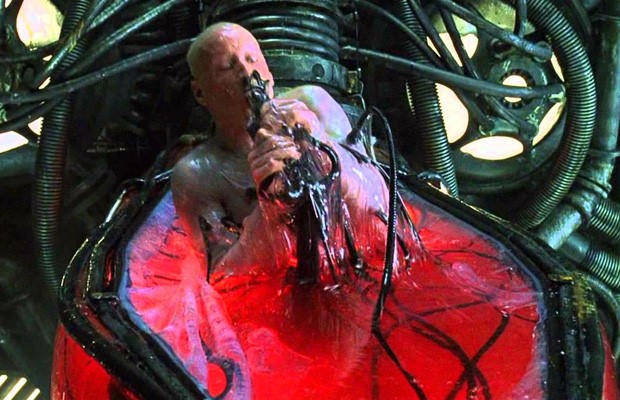
Neo (Keanu Reeves) awakes in the movie ‘The Matrix’, finding he has been asleep all his life and dreaming in a computer-generated world
If I was a fan of conspiracies, which I sometimes am, I would say that we are so rich that, in order to maintain the same social system, a way had to be found to keep us poor, or at least deeply in debt. This methodology, inserting us back into a padded mechanical womb, has the added benefit of rendering us dreamily unconscious so that we are incapable of offering any defense against this savage assault on our well-being. We are required to be regimented from birth, in order for us to be deprived of our natural tendency to cooperate and instead be set against one another, continuously, in unnatural formations, called classes, races, sexes, or social orientations. We want to find and establish the ways that we are not the same as everyone else, as a way to assert our individuality and specialness. Being tied up in that quest takes a lot of energy. What is left over is seldom enough to achieve lift-off?
We find that our self-esteem, to some serious extent, is being measured by our capacity to generate waste. Being concerned about issues such as this, can put you in the category of somebody who may not be able to pay their bills promptly, or is suffering from some other debilitating stress. You have to project an attitude of ease and comfort or you could be on the skids. This attitude of nonchalance, whether on the receiving or the delivering end, includes the ability to totally disregard the needs and concerns of others, to be a virtual monarch in your own dimension, living high and acting like a big baby.
To foster this addiction to competition and loss of empathy, we are constantly being reminded of the pecking orders that surround us. Superstars in their bling rule. If you are in a certain profession, it is understood that you will behave in a certain way. Businessmen and women wear cleanly-pressed garments and speak in measured tones. The food servers are usually extra-friendly and smile even when it is not called for, as a way to lessen the chances that they will displease you and be called out for their behavior. Kids play their games and choose their friends and soon begin to treat others differently, depending upon a host of signals that are unspoken but ironclad. If you hang out with this one, that one doesn’t want to know you and vice versa. The popular kids know it and begin to use the value of their friendships as bargaining chips and so the game begins.
Part of this is biological and has to do with choosing mates and improving the species, but a lot is learning where you belong and adjusting to the realities. That one is faster. That one is smarter. That one is prettier. Here is where I fit. Here is what I have to do to get along. Good educators know that you can break down these classifications and the limitations that they impose on our ability to appreciate the unique contributions that each of our fellow creatures may be able to make to our common lives. It takes skilled workers to help kids to do this though, and paying professionals to do this is too expensive for most school systems.
Bullying is just an extreme form of the tiny slights and little signals that define our relationships to each other and to the world. If you look around at all the subjects which interest you the most, sports, music, business, etc. it is clear that there are only a tiny number of big winners and a huge army of wannabes, and you soon get the message. The realization that this is the nature of our society or at least its dominant trend, puts some into a frenzy of determination to be the winner, sometimes at any cost, while many others collapse into despair, full of the realization that they can never reach the pinnacle. The frustration that ensues can take many forms, but anger and hostility are one. Unfortunately, there has never been a good system for identifying anti-social individuals at a young age and helping them to modify their behavior. These days, it is easier to give everybody the anti-ADD behavior-modification pills and disregard the underlying problems.
We are constantly receiving messages and sending them, what we like, what we accept, what drives us crazy. When they are not received and responded to we get bent out of shape and behavior becomes more extreme. Identifying issues becomes difficult or impossible as, often, those with the same view of the world become friends and cliques grow based on a wide variety of factors, including insensitivity to the pain of others. Mall rats watch their parents’ consumption patterns and start copying them early. The owner/manager class is anxious to pass down the skills and habits needed, to preserve position and status, to their offspring. Often these lessons are ignored or actively opposed by the next generation and the materialism and shallowness rejected. Just as often, they are absorbed and used to give a further advantage to the advantaged.
How we respond to this situation defines our personality, and we are a product of our perceptions and actions, and they also determine how others see us. All the jockeying for status takes a lot of energy. Extreme rejection by your young peers can be destructive and permanently damaging but it is also a way for your fellows to let you know that you had better change your ways, that you are not fitting in. This can be a good thing, for instance, if an overweight kid decides they are tired of being made fun of and are ready to put the work in to get themselves into better shape. Someone can be tired of being called stupid and start studying more. Usually, the result is the opposite though. We are cowards and conformists and peer pressure does more to intimidate us than to teach us. Our sense of the possibility of a common future or a commonplace is destroyed over time, by the realization that people live in every kind of condition, from horrible to exalted, and that this is not only considered alright by many, but it is also seemingly becoming more so every day.
The remedy for the angst associated with understanding your place in the world is to foment a system in which the inessential differences between us do not prevent everybody from getting a modicum of what is needed to survive and prosper. The essence of that enterprise is shared access to needed resources, like transport for instance. NYC is blessed with an underground railroad that carries the majority of people around without clogging up the streets. Most other communities are reliant upon various forms of surface transport and face endless lines of barely moving, smoke-spewing motorcars every day.
In addition, in NYC, there is now a shared bike program that is enjoying great success. It is proving to be safe and convenient and attracting use from every sector of society. It is still not being deployed everywhere around the city where it is needed, and the economics are still being tweaked to get it to work better, but no fatalities after a year and widespread joy at its installation, have made it possible to consider expansions and variations on the theme. If it is better to be able to use something than to own it, what implications does that have on everything else? If your status is a product of what you do, not what you have, what does that do to the current model of Paradise?
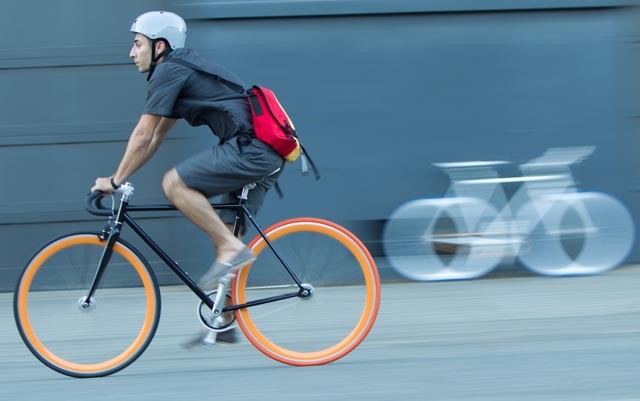
Only .8% of us commute by bike. It is too much hard work early in the morning unless you are a very fitness-conscious person. The troupe is tiny, but growing to be sure, especially in big cities, where distances are modest and a lot of young folks are moving into the workplace. The fashion now is “fixies”, incredible machines of under 20 pounds, that can be hauled upstairs with aplomb and use coaster brakes (mistakenly described as “no brakes”) so they are as trim as many of their riders. Like messengers before them, they connote style and are streetwise fashion leaders. Clunky electric-assist bikes are considered to be a sign that you are not at the height of physical condition and therefore a few notches down on the ladder to perfection, for the cool, Brooklyn crowd. Pride of ownership is a big deal at this time with this crew too. The notion of sharing their prize possession is anathema. There is nothing inherently wrong with bonding with your ride, I suppose, although it is a little kinky.
The current bike culture is the enemy of the future bike culture. It is still very trendy and fashion-conscious. Whether you ride a classic clunker or a $10,000 carbon-fiber masterpiece, defines, to some extent, who you are and how you are. Being a rebel on wheels was a great image for decades, a symbol of those who rejected the central tenet of the consumer society. Now, you are riding a big, heavy shared-bike, with ugly advertising on it, but it doesn’t matter because it is only a 15-minute ride and much easier and more fun than the subway. It doesn’t matter how you look, it matters that you can go nearly door to door in minutes and without mussy hair from wearing a helmet. The barriers to riding are breaking down. Older people are getting over the fact that is has been decades since they rode and doing it.
Even on the smooth and level roads of the city, it still takes effort to move the machine. That discourages a lot of people, accustomed to our no-sweat lifestyle. There are moments when you want to minimize that effort because you are tired, or feeling lazy, or loaded down with gear. Voila, the electric-assisted bike. Transportation for the other 99.2% of people who are not accustomed to making muscle-powered transport their mode. I don’t think that even 1% of the public has ever been on an electric bike. They are being used by a bunch of food delivery people and a handful of older folks. Everybody has seen them in motion but almost nobody has ridden one.
That’s a shame because once that has happened, a million free rides later, the public is going to turn into a loud cheering section, demanding their availability. The only way to accomplish this task expeditiously, aside from the manufacturers unleashing a host of free rides at block parties, etc., is to deploy shared-e-bike schemes. They are already underway in San Francisco and Berlin and many other places and will soon be everywhere. The slack is ready to be taken up. By connecting to existing businesses, the huge expense of automated kiosks can be avoided by giving local establishments first dibs on handling the action in their neck of the woods. Instead of putting existing bike stores out of business, as was reported in Bloomberg News this week, this program can be used to infuse new traffic into neighborhood businesses, who will welcome it and the income it can bring.
It has to be made possible for the machines to be taken home at night by commuters, who are only charged a reasonable fee for the privilege. They need to be made so rugged that they can hold up under constant use, and have their components replaced on a regular schedule along with other kinds of maintenance. They will need to be electric-assist and require pedaling to move, not just throttles so that they are not in conflict with existing bicyclists, some of whom are already displeased at this prospect. There can be an infinitude of designs and we can shake out the best producers and shapes and configurations, through feedback from the users. The evolution of these devices from the crude imitations of standard bikes that we have now, into the fully-functional, safe and comfortable transport of the future, has to come from the bottom up. This pertains to the weight and impact of these transporters as well as the hand-crafted, constantly-changing nature of the devices.
Many of these new vehicles need to be trikes rather than bikes. Even though two wheels have the advantage of less rolling resistance and overall weight, lean steering and easy storage, trikes bring stability and a way to mount the weather protection, inflatable mostly, in place, along with copious storage. Multi-passenger vehicles, like virtually all existing cars, will become the rule rather than the rare exception for cycles. It will be possible for multiple persons to use their muscle-power to contribute to the movement of the vehicle too, both for fun and for energy efficiency, and side by side configurations will make the experience more social and comfortable.
Replacing the giant-esque automobile with something more suitable for dense and congested urban spaces is inevitable, and does not have to take forever. Sparking innovation is not easy, but in this case, everybody is familiar with the concepts; it is just the equipment that is temporarily not yet available. That situation will change dramatically when a few designs are being produced more widely, like the ELF, which proves the viability and popularity of these ideas. Programs like www.SharingUmbrellas.org will help encourage more creative activity. Full legalization will advance. Peace will find away, and so will we. Or I’m a monkey’s uncle.
Times Article Viewed: 8317
Jun 02, 2014. Times Article Viewed: 6804
It now appears that the New York State Senate will move the bill legalizing electric bikes forward. This welcome move comes at the very end of the session and leaves just enough time to pass it and reconcile it with another bill that is ready to pass the Assembly. That bill contains two restrictions which will put painful limitations on use: persons under 16 may not ride as passengers and helmets are required for adults. Since you can ride a kid on a Harley-Davidson or a Schwinn, why are e-bikes singled out as especially hazardous? I’m not sure that this restriction exists anywhere else in the country or even the world. I think it may be motivated by a sincere desire to protect the vulnerable from harm, but by doing it this way, it prevents electric-assist transportation from evolving into its fullest expression, as family-friendly vehicles, at least in this state. It is hard to blame someone for not seeing that minimal vehicles can provide for weather protection and passenger capacity if you have never seen one, or even a picture of one. It is not in your experience and it is not in your imagination, so it doesn’t exist.
Bike groups, from the NY State Bicycle Coalition to the city’s Transportation Alternatives, including all of the major national organizations, are consistent in their recommendations that individuals use bike helmets. They are also all, however, strongly against making this a requirement under the law. The fact is that the number of riders is reduced tremendously by this requirement, and research shows that this makes it much more dangerous for the resulting riders. There is safety in numbers after all. Also, importantly, car drivers get closer to helmeted bikers and cyclists tend to be more adventurous and less risk-averse since they feel protected by their headgear. Adults can decide if they want a plastic bowl on their head, or even a full-tilt jet fighter pilot helmet, with an outside air supply, but almost everybody agrees, let it be a personal decision, not the law. It is perfectly understandable that a public official would be inclined to want to protect his constituents from harm when possible and helmets are a bit of safety gear. This is a counter-intuitive situation however and requires study and independent thought. Regular bikes go 30 MPH and faster and these electric-assist models go only 20 MPH max. They should be considered more dangerous? It doesn’t make a lot of sense.
The two legislatures will need to work out these questions over the next couple of weeks, in a conference committee context. They may well do this now, 13 years after it was first introduced in the Assembly, especially since the NYC legislature is ready to pass a resolution urging them to do this. Last year, this was not the case. Even though these same bills passed the transportation committees in both houses, unanimously, a call from the Mayor was enough to kill them. He didn’t want it to look like he favored the riding habits of restaurant deliverers. This year, there’s a new Mayor and City Council, and Rafael Espinal and Ydanis Rodriguez, chairs of their committees in the NYC Council, are working to help provide us with access to this important new form of healthy, high-tech transportation. What a difference a year can make. It is still not decided but there is a good chance that this can actually happen.
When I tried to describe the current situation to somebody this week they were incredulous. How could electric bikes be illegal and stretch Hummers fine and dandy? Is this legal jumble the primary reason that millions of these handy devices are sold in Europe every year and mere tens of thousands here? The Federal law from 2002 says clearly that their law supersedes State laws that are more restrictive, but over 30 States regulate these machines the way that they feel like it anyway, with some defining them as mopeds and others as motorized vehicles. The companies who are selling these products are not of the magnitude needed to engineer a massive public relations and public information campaign to put their products on the map. Laws that restrict the use of your legal product can be challenged but it is a costly campaign. The issue has not been pushed yet by the environmental movement or health groups, except in all of their ads, which feel almost naked without a bike in the picture.
Imagine a world in which the telephone land-line companies had been able to stop the spread of cellphones, what we now like to call smartphones. We would have been left in a world of only dumb phones, with no other features besides fixed-location voice communication, and we’d still be spending $2 a minute for long-distance, plenty more if an operator is involved. Now it is a penny and the operator is a robot who always sounds like it is happy to hear your voice. We are in that place now when it comes to transportation technology. If you thought AT&T was hard to budge, just think how difficult it has been to do anything about industrial-scale transportation and its well-heeled and well-mobilized adherents. The resistance to change is a natural phenomenon Those who are in control are willing to use any means, natural or unnatural, to maintain their hold on the situation. Making roads too dangerous for pedestrians, and small vehicles have been a major weapon used against human-scale travel for a century. Lax enforcement of traffic offenses, the forgiveness offered to drivers who end up being an instrument of death, are others. A recent news story featured a dapper fellow with a Ferrari, who had just gotten his 15th DUI, and was ready to get back on the road.
The spectacle of the privileged pumping poison gas into their vicinity, while they semi-reclined in air-conditioned splendor within their cocoons, also serves to discourage the unadorned and unprotected, from disturbing the status quo. The chemical stew in which we are being marinated, in our close urban quarters, on a nice hot day with no wind, is being concocted out of an unknown combination of substances, with letters and numbers for names. It is not dope in the sense that we would begin to shudder and shake if we left the city for the piney woods and found ourselves outside of its fumes for a period of time, but we really don’t know how it operates and what it is doing to us. It is not a matter for conspiracy theories, it is a subject for serious scientific research, much of which is neglected because its conclusions could require changes that those in power do not want to have to deal with if they don’t have to. What happens to populations that are surrounded by different mixtures of these chemicals over time? Do they become more passive and accepting of these substances? Is this the physical manifestation of what we call a self-fulfilling prophecy?
The problem with epidemiological studies is their cost, the time they take and the need to establish control groups, in order to isolate causative factors and relevant comparisons between different populations. They are the most reliable evidence of a phenomenon, the kind that can not be ignored. In contrast, anecdotal information, which merely relates the experiences of a particular group and issue being studied, can be fragmentary and therefore not entirely convincing. Does this mean that we should ignore what is before our eyes? Do we need to study whether oil trains can be derailed, if there are reports of it every week? We know that living in the vicinity of a big highway, especially one that suffers from congestion, is going to send your asthma rates through the roof. Your kids are going to have trouble concentrating in school and local streets are a powerful magnet for those avoiding the traffic on the big road, so playing on the street becomes a version of Russian Roulette.
Sure, it used to be worse when all those dirty factories were working away, and no environmental laws even existed or were enforced in any serious way. We have much to be thankful for and not everything is just going downhill. We can’t use that progress as an excuse to not look hard at what is in front of us though. We have no larger responsibility then to be the protectors and preservers of what deserves to be there. We don’t yet have the most effective means to collect our influences and focus them, and we are deeply distrustful of all movements and organizations and rightly so. Some wish that an alien would alight, give us a reason to recalibrate and recalculate. That is just waiting for the messiah in a secular guise. We don’t need a planetary awakening to know that there is work to do here.
Politics is always a contest, who is right, who is wrong. When we are all wrong, or all right, that should be enough. If we did nothing but exhaust those issues about which we, practically all agree, we could get them out of the way and move on the more fractious and difficult ones. Ralph Nader, our National Conscience, has begun to search out areas of agreement among those of ostensibly different, even contrary, views, and use those overlaps to help advance worthwhile causes. That sounds about right. We are never going to agree about everything and trying, causes a lot of conflicts. If we can not agree to agree on those matters that we do agree on we are, clinically speaking, nuts.
This does not mean that those who continue to dissent should be treated like yesterday’s french fries. It is just that we need to prioritize. If we can’t even get down the list, past the things that nobody in their right mind would disagree about, the need to make sure that everybody has access to drinkable water for instance, where can we go, what hope is there left? We are doomed if we allow ourselves the indulgence of endless conflict when the urgent business at hand goes neglected. It is easy for the emotional element of this to overcome the reasonable and lead us into an invisible cul de sac. We throw all of our energy into our own dilemmas so there is nothing left over for anybody else. We have been offered one last chance to prove, for all time, that we are not simply addicted to the chase and therefore fatally bored with the prize. This may or not be true but, in the final analysis, it doesn’t matter. The problem is that nobody likes a sore winner.
Times Article Viewed: 6804
May 25, 2014. Times Article Viewed: 5726
OK, I admit it. I hate the New York Post. I used to love it. There were writers like Murray Kempton, who fashioned poetry out of the muck, and dazzled us with the hard evidence of his enduring love affair with words, and our humanity, and inspired us with his justifiable suspicion of everything else. He was only associated with two material objects in this universe, aside from his typewriter and pencil, and they were a pipe and a bike. He was a minimalist to the core, although his sentences sometimes led through long and dimly lit caverns. He told the truth, never pretended to know anything that he didn’t and showed you how to find enough irony in a situation, to keep you from having to shed real tears about it.
Rupert Murdoch, the current owner, spends a fortune each year to provide himself with an editorial sidearm and the political leverage which comes with it. Now, this former illustrious rag, is a nail-studded, poisoned club, to be swung at its “enemies”, in angry drunken lunges, devoid of reason, truth or compassion. They get almost everything wrong if it has a political dimension. One of the problems with this modern-day version of William Randolph Hearst and his “You supply the photographs and I’ll supply the war” mentality, is their fealty to their advertisers. One day’s worth of ads in a shrinking world of tabloid newspaper advertising is the old reliable, in his case 29 pages long, car ad section. Counseling any reduction in the consumption of anything, is halfway between treason and heresy. Since he also owns the Wall Street Journal, this article of faith has been elevated to the level of Prime Principle.
One consequence of this arrangement is that this classic tabloid, America’s oldest newspaper, the NY Post, is in an unrelenting war against anything having to do with human-powered transportation. Economical bikes are the enemies of the people and those who ride them are barely human. Before bike-share was established they had regular screaming headlines, claiming that this was going to result in something resembling a battlefield, the streets littered with the bodies of both cyclists and their victims. Ambulances would need to cruise the streets constantly, to pick up the bodies and get them out of the way of legitimate vehicles. After 7 million rides and zero casualties, they are in trouble. Pedicab drivers from other countries are their new devils and restaurant deliverers a constant target. Only 1% of us commute by bike, so pandering to the other 99% comes naturally to them. (This is in spite of their ordinary sympathy for the wealthiest 1% when their interests are threatened) They can even do it self-righteously, with phony allegiance to principles that don’t even exist.
We owe a debt of gratitude to one of the richest men in this country, Michael Bloomberg, also the master of a media empire, who could, due to his wealth, resist the automobile industry’s stranglehold on the political system. He pushed for congestion pricing because he knew it would cut down on traffic considerably and improve the air outside at least as much as his smoking bans did indoors. He couldn’t get past the outer boroughs addiction to easy passage for their beloved cars, but he decided to do the next best thing and put in lots of bike lanes and even a bunch of bus lanes. Unfortunately, he had a City Council that was totally beholden to the usual suspects and unable to do much more than step aside and let it happen. The new Council is much more activist though and totally behind the current Mayor’s Zero Vision plan, to slow speed limits and rein in dangerous misbehavior by those tooling around in multi-ton machines, texting and talking their brains out.
Last week we were treated locally to an event put on by the titans of the bike industry in this country, INTERBIKE, who puts on the yearly show out west and Bicycle Retailers Magazine, BRAIN, and Outdoor Retailer. They assembled a small handful of electric bike manufacturers, a tiny fraction of the industry, and provided them with an opportunity to give rides to journalists at a fancy resort in New Jersey, a 90 minutes car ride away from New York City, the city with the lowest rate of car ownership in the country. This recognition, by the largest factors in the bike business, of both e-bikes, and the East Coast of the United States, is very welcome, albeit long overdue.
When I first became involved in this issue, the “Bike Show” was one floor, and a mere fragment of, the “Toy Show” here in New York City and obviously strongly tilted towards the young. A few major manufacturers dominated the industry and the most original element of any given show was likely to be based on snazzy paint jobs. Now that Las Vegas, one of the least bike-friendly places on the planet earth, is the home of the yearly INTERBIKE show, our side of town has become almost incidental to the process.
This is all in spite of the density of population on the East Coast and therefore the relevance of slower means of travel, like bikes, to the transportation systems. Besides bikes are not often considered transportation. They are for sport, for exercise and pleasure. They are marketed to young people primarily, although somewhat less than in the past, and there is a real dichotomy in their demographics. They go largely to the upper and upper-middle classes and the lower classes, delivery workers, etc. They are either the only affordable, or at least most economical, way to travel, or just another recreational option, a way to get out into the country.
In Scandinavia and the Netherlands, 25%-50% of trips are made by bikes, not 1%, and we all have the same arms, legs, hearts, etc. We also have the same need to keep those limbs functional and in that regard, we in the US are also way behind, in health, vitality, life span, etc. Breathing the by-products of hydrocarbon incineration, daily, at close range, is clearly not a good idea, whether you are in Beijing or NYC.
Is this a plot by doctors to make us unhealthy? Not really, but many are concerned, that they do far too little, to exert their influence on the political process, especially when it comes to policies that either damage or improve our health profile. They should be riding and promoting bikes like mad. What activity could be more supportive of good health?
It is notable that the 5-Boro Bike Tour, which had its big ride and accompanying Expo only a few weeks ago, had 85 exhibitors rather than the tiny handful in New Jersey. In the afternoon, bike store owners were invited to ride some of the bikes on display around the grounds of the golf club and residential development surrounding it. While there were surely benefits to this demonstration and exhibit, I could not help wondering where everybody was? Wouldn’t it have made more sense to have this affair in NYC itself, on some piece of private property, like it was in NJ, which also currently bans electric bikes from its roads? Since the NY City Council and State Legislature are going to be voting on this issue, within the next month, could invitations have been provided to all of its members and their staff, to have what will probably be their first ride on these devices? We know that the level of positive responses from those who have actually ridden one of these machines is stupendous.
The US Open attracts over 10,000 journalists to its event. The NYC press core alone is huge. As rare as such an event has recently been, maybe it suggests a stronger East Coast presence on behalf of the industry in the future. A great many journalists and store owners from Philadelphia, Boston, Washington DC and Europe might find their way to a great demonstration event, with a chance to try a wide variety of machines. The public too is hungry to see what the fuss is about and could be a part of such an undertaking. Being in NYC puts you in the middle of the media industry, from magazines to web companies, Google, etc. etc. The interest in this subject, if you measure it by the number of stories written about it and mentions it, is immense. It is an anomaly, that there is a subject, about which almost everybody knows only a little tiny bit, especially regarding the legality, and what they think they know is usually wrong. The industry needs, but can’t afford apparently a huge public information campaign. When it includes a multitude of free rides at County and State Fairs and block parties, and a scattering of celebs, the breakthrough will come in a big rush.
The missing piece has been, as is so often the case when it comes to worthy causes, the financial one. The cost of machines has been a few thousand dollars, significant for bike stores but not enterprises like car showrooms and TV stations, where multiple $10,000 bills are expected. The profit margins are a bit better than ordinary bikes, but the volume, at today’s low level of awareness, is still very small. In New York State electric bikes have not been approved by the Department of Motor Vehicles, so they are technically not permitted. Some argue that the Federal law grants them rights to the road, but there have been problems for some users, especially restaurant deliverers, whose ignominy is magnified by their need to get there as quickly as possible. Regardless, stores are nervous about renting them, which would provide the key step in giving the public a chance to find out if they work for them, all due to the liability risk that accompanies a product in legal limbo.
The problem with determining its relevance is that 99+% of people have never been on an electric-assist bike. They have no idea how pleasurable and empowering it is to realize that you have the ability to decide when and how much handy power you want, in moving along. Even car drivers do not get to make this choice. Since our health ultimately depends heavily on how well we are able to keep ourselves limber and use our faculties, this is not a small matter. It is an immense advantage that human-scale transport has over industrial-scale solutions. Cars kill and not just when they hit you. They are slowly killing you while you are sitting there when you could be standing, pedaling or even cranking. The key question is: who makes the choice, you or the machine? Are you controlling it, or is it controlling you? Is the answer $60,000 multi-ton robots or $6000 shared devices, measured in tens of pounds?
If you are in heavy industry, there is no question, this beneficial adaption would be a catastrophe. If you are insuring things or loaning the money to purchase them, this will not please you at all. If you are tired of wasting time in traffic and ready to get closer to the ground and in closer touch with nature and what is around you, this will be a positive development. Whether it is a wheel or a shoe, transport is bottom-up. When we begin to direct its development from down here on the ground, rather than in the boardrooms of the petroleum and automobile industries, much can change. I am afraid that there are decisions being made on behalf of the bicycle and e-bike industries, that are also not fully appreciative of the immense potential here, both for themselves and for others as well.
We are in the initial stages of a new “Movement” as it applies to movement and it is being propelled via a new “Medium”, Hybrid Human-Electric power. The question “How do I get there?” turns out to have so many answers, applications and varieties that it qualifies as a creative “Medium”, like Dance or Sculpture, not just a mechanism. Unlike those classic arts, its history is one of suppression rather than expression, its prospects held down by its own “leaden” identity. It is now an opportunity, to open up the issue of expedited movement, to artists and other creative makers. Sure, it is a functional exercise, mostly engineering, on one level, but it is also the key element in the re-design of our streets and public spaces and our relationship to them re-conceptualized. We are talking about what is beautiful, unusual, unique and fantastic, something that changes how you view the world.
There is work that needs to be done here, to forge links between the health, environmental and other public interests involved with this issue. One person who is already part of this coalition is Tim Blumenthal, the President of Bikes for People, who was the main speaker at the NJ Charged-Up event. His organization has been known for their pro-bike activities, and happily, he and his group are completely supportive of electric bikes. This has both symbolic importance and practical benefits as well, as better information begins to circulate. There have been times historically when this was not so when the strength and endurance needed to take part in cycling was considered essential to its nature and identity and motors were considered “cheating”, a sign of weakness, or an unwillingness to suffer the pain that athletes must endure. That self-limiting attitude, fortunately, is in the past now.
This more recent acceptance of diversity within the cycling community is a vital step on the path to legality and legitimacy. The League of American Bicyclists (a 120-year-old organization originally known as the “League of American Wheelman”) has also taken the same enlightened position. Their support will be essential in the struggle across the country to craft rules that will enable us to accept the blessings that bikes, with helper motors, can provide great swaths of our population. The complete acceptance of the many forms of cycling and its evolution into a fully functional and refreshingly diverse, healthy and vibrant element of our transportation system is now possible. It is clear, that if we would legalize the future, we would immeasurably improve the likelihood that we will have one.
Times Article Viewed: 5726
May 11, 2014. Times Article Viewed: 5762
“There used to be a little grey cloud that followed me around and rained worry on me all the time, about the environment and things like that.”
“Sounds like a drag. Is it still a problem?”
“Not really. I took care of it.”
“What did you do?”
“It was easy, I just moved into that cloud. Now it’s somebody else’s problem.”
“Don’t you mean me?”
“That could be. There’s plenty of room up here if you want to join me though.”
“But if everybody moves up there, who is going to take care of everything down here?”
“It’s probably too late to do anything about anything anyway, so it makes no sense to worry about it.”
“Aren’t you afraid that it could all just fall apart, trap your grandkids in a deluge or avalanche of grief?”
“Yeah, I’d probably have to really increase my dosage, of whatever it is that they’ve been giving me.”
“Does it concern you that you may be witnessing the total breakdown of the world you were gifted with at birth?”
“If I cared about anything, I suppose that is something that I might care about, but honestly I don’t.”
“Maybe there is some secret technology breakthrough that will solve all of these crises, a reason to hope?”
“More inanimate devices seem unlikely to re-connect us to the life-force, which has been in open retreat.”
“What happened to the concept that your whole life is devoted to enhancing the prospects of your heirs?”
“It was discarded as archaic, selfish and unrealistic, as they are unworthy, undeserving, and unappreciative.”
“Don’t you worry that your kids will abandon you in your dotage, ignore you and forget you exist?”
“They’ve been practicing that day and night since they were little tykes, have got it down pretty good.”
“So you don’t care if there is a habitable planet left when you are carried off onto your next adventure?”
“I doubt if a piece of rock has many feelings for me and the sentiment is just about the same over here.”
“What about all the plants and animals, and all that fervent praying for everlasting life, etc. etc. etc.?”
“Well it’s nice to look at all that stuff and music in church is sometimes cool but none of that really matters.”
“You mean that was all an act, a charade, a Big Lie, just a way to get what you wanted on the cheap?”
“I guess you could say so, but I was just doing the same thing everybody else was doing, no big deal.”
“But don’t you see that not paying attention turned your chicken coop into a fast food joint for the foxes?”
“You vegetarian-types think it’s all about the “Big Picture” but you forget it can be pretty rough down here.”
“Does anybody think that emptying out the oceans of anything alive, down to the plankton, is survivable?”
“More hysteria, whipped up by professional environmentalists who depend upon these wild exaggerations.”
“What about the fishermen, whose empty boats and long faces speak loudly about their changing daily lives?”
“They can get jobs as truck drivers or plumbers, tell stories about how great things used to be sometimes.”
”But if this isn’t just one cog in the wheel, is it possible that it could be a crucial one, that we can’t do without?”
“Look, maybe our species is like a restless teenager, tired of the routine, looking for some risky behavior.”
“Sure, but don’t you hear all the time about a terrible accident, where one of these kids goes over the edge?”
“And girls have babies when they’re too young and maybe we expect too much of those who are in power.”
“Once you take on those responsibilities though, shouldn’t we expect a much higher order of behavior?”
“Only if we are delusional since they have demonstrated historically that they are just like us, only bigger.”
“So what about the guy who writes this blog, who thinks that we all have to make new kinds of bikes, jump to the human-scale, etc.”
“He’s just like all the rest, except worse, because he fosters the hope that there is actually a way out of this .”
“Well, we have our hands and brains so shouldn’t there be a way to use our ingenuity to crack this case?”
“Nobody beats the rap unless somebody gets to the judge, which is why politics actually matters.”
“So if it doesn’t help that he writes this thing, the proof is that nobody, at least hardly ever, comments on anything?”
“That’s how I would interpret this lack of response, either nobody is actually reading it, or nobody cares.”
“Then, does it even make sense to keep going on about this stuff, creative designs, World’s Fair blah, blah?”
“I’d suggest there be a pause, see if anybody noticed, to open up the discussion to everybody else and see.”
“Maybe that Disqus system doesn’t work just right and the comments get swallowed up and disappear?”
“I suppose, or very few people get through those 2000 words all the way to the end where the comments are.”
“Or do readers think that you said it all, and it really doesn’t require their commentary on your commentary?”
“There is really no way to know what they are thinking if they won’t say anything even when you ask them to.”
“So should I stop writing every week? I’d like to ask you to decide. Is there anybody there? Anybody care?”
Please create your own Commentary and begin a conversation. Help put the Common back in Commentary.
And identify yourself and let us know that you exist. Check-in. It makes this all worthwhile. Thank you.
Times Article Viewed: 5762
May 04, 2014. Times Article Viewed: 7600
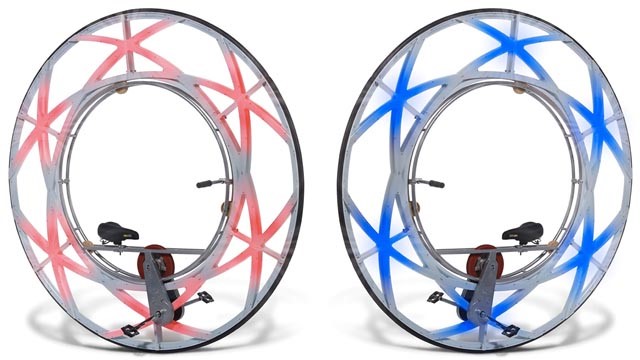
While a focus on the rewards of unbridled wealth, and the lurch towards hyper-consumerism, are two trends that I normally abhor, there is, regardless, much to be admired about the Hammacher Schlemmer catalogs and their cornucopia of treats and sometimes very practical devices and objects. Next month their cover will feature my friend Rob Cotter’s revolutionary “ELF”, the vehicle that has begun to change a million minds about the practical nature of hybrid human/electric powered vehicles, from its economics to its aesthetics. One of the ways that the world changes, is as a result of people voting with their wallets and generating buzz, and by earning profits and fueling entrepreneurism, inspiring more breakthrough projects.
As usual, this month the catalog features a variety of mobility devices. They range from the Worksman Trading Company’s genuine ice cream cart tricycle to a gizmo that projects laser lines on to the ground at night so you can make your own bike lane as you go along. Even stranger are two machines that are as odd as they are provocative and both use human power as their essential feature. One is an edition of the “Monocycle” that was featured in the closing ceremony of the Beijing Olympic games [pictured above], its slowly spinning rings of light providing a serene parade, symbols of balance and coordination based on our energies, the human element. This was a beautiful, almost magical display, with a strong statement to make about our capacities and abilities.
While traveling inside a giant glowing ring has its charms, I have long felt that we could stand to make our lightweight vehicles, in such a way that the passenger can travel very close to the ground, for the sake of minimizing wind resistance, improving safety by lowering of the center of gravity and the stability that this provides, while enhancing the comfort of the rider. This still allows for this person, or even the number of persons, to use pedals or hand cranks to propel the vehicle in an ergonomic, efficient and comfortable fashion. Of course, the problem that immediately comes to mind is that buses and trucks and tall SUVs, could squash you like a bug that way, plead that they hardly knew you were there, and drive away without so much as a summons.
The solution is lighting, contained within thin telescoping filaments, projecting 8 or 10 feet high, deployed when needed only, flashing unmistakable signals that there is a small, perhaps hard to see, vehicle alongside you. This can also be a means of developing the personality of these modes of travel, by focusing on the graceful aesthetics of gently moving objects and how much they can lend to the landscape, instead of being huge, endlessly repetitious examples of the same massive, personality-less, potentially-lethal objects. While you ride peacefully, nice and close to the ground, all that commotion up there can be fresh and surprising, intermittent instead of continuous, colorful and fun. Accompanying this eye candy with sound displays, musical and otherwise, (the sound of a flock of birds seems appropriate), adds another variation, and one that can contribute to the safety of nearby pedestrians too.
The catalog’s other featured vehicle is propelled by electric energy, which is being generated by the four passengers, through the use of rowing bars. The manufacturer claims that it can reach speeds of 60 MPH and costs $60,000. One of its most interesting aspects is the mechanism whereby their rowed energy is converted into electric energy stored in a battery, which is used to power the motor which actually propels it. It is described as “battery agnostic” meaning it can be “upgraded as future battery and motor technologies advance”. While it has the flavor of the wonderful Kinetic Sculptures from the 1980s, it is also a very serious lesson in the art of combining power-sources and having a good time. It is reminiscent of the wonderful tiny railroad-tracked vehicles, that were moved by the up and down exertions of the two operators. It is another version of Derk Thijs’ excellent Rowbike from the Netherlands, a proven winner for decades, which also cleverly employs cables to carry the power to the wheels.
Getting around is recently becoming much more of a subject of interest to the geek community. Communication has been conquered. One push of a button and you are in the Land of Infinite Apps. Information is ubiquitous. We speak now of “overloads” and the impossibility of turning it off. Both have been shrunken down into something that fits into the palm of your hand, soon to be an amulet around your wrist or neck. Minimalization has proven to be the key to accelerating our access to what had preciously existed as two trivial factors, that we barely knew existed, clunky black phones and their fat yellow paper directories.
Now it is time for Transportation’s close-up, to be followed by its right-sizing, which, if history is any guide, means it’s on the road to virtual disappearance. It is the next mountain ready to be turned into a molehill. This will be even more fun than taking on TV Networks and Ma Bell. This is the really big one, that fills the streets and empties out the bank accounts. There is no aspect of our lives riper for revolution than transport. This is the next step beyond Social Media to the Mobility Movement, the MoMo. Who’s riding with who and where has implications even beyond the Human Be-Ins that rocked the sixties with Peace and Love and all that other good stuff.
There will be, and already is, a monumental change in this arena. We are getting ready to subtract, from the personal monetary equation, its second-biggest factor, your domicile being the one that requires you to take on the greatest amount of debt. (Schooling, of course, is starting to rank up there with the top causes of “voluntary” serfdom). Cars take up an exaggerated amount of both real three dimensional-space and, if you live in the country especially, virtually control the ability to access essential services. With the advent of bike share and car share though, rideshare is on the horizon and nothing could be a greater threat to the hegemony of the current automobile paradigm than a sharing economy. This doesn’t just threaten the auto and oil companies, this is a potential attack on the entire mall culture and a return to local shopping, slower living and an ethic of greater cooperation on all relevant issues before us.
The “Autocracy” is also a huge element in electronic media, TV, cable, and satellite. You can not avoid the pitches for brands that go on constantly, much less the ads for car insurance and oil companies, injury lawyers and finance companies. Programs themselves feature cars as top prizes on game shows and the essential instrument of heroic cops speeding around to catch the bad guys. Traffic reports dot the news stories and horrifying accident pictures are reliable fodder. Aside from work-related associations, we have accustomed ourselves to ways of life that permit us to largely seal ourselves off, from all but family members or a few intimates, in any meaningful activities or exchanges. We treasure our privacy more than almost anything else, even though it does nothing for us but give us some seeming protection from others. Do we have so little to offer each other that we should want to remain at these distances and with these barriers in place? As the importance of what you drive becomes less important than what you have to say, (and recent surveys suggest that, in a radical departure from the past, young women are much more interested in guys with practical vehicles than flashy ones), many sacred “truths” are being questioned.
Granted, folks ignoring each other, is far better than the anti-social activities featured in the news stories about civil wars and bar fights, but does this constitute a society? We are happy to be safe and secure in our houses too, and nobody says that this is not important, but we don’t even imagine a world, in which the conditions that exist are not inevitable and unchangeable. TV reinforces the same stereotypical ideas and attitudes that prevail. If you tilt right you go to Fox, Lefties congregate on MSNBC. It’s almost like High School, with the jocks and the nerds in everlasting battle. So the jocks get the girls, but later on, the nerds will marry them because they have a better sense of humor and earning potential. The missing element here is the artists, who don’t buy any of it, who thrive on total social interaction and crave change instead of being frightened and alienated by it.
The many parents who testified at the Vision Zero hearing about the death of their children under the wheels of multi-ton vehicles were touching in their deep concern. The Chair, Councilman Ydanis Rodriguez, let them speak their piece and seemed genuinely moved by their stories of loss and despair. Nobody had to recruit them to speak. They are compelled to right this wrong, to bring us to our senses. Some responsible legislators are asserting a new reality, in which local streets are not allowed to be high-speed highways and cars not permitted to rudely nudge and intimidate pedestrians out of the way. I like bikes but shoes are the ultimate human-powered vehicles and NY’s Mayor DeBlasio is kicking an important program into gear, with his Vision of safe and friendly streets for pedestrians. He has the Police Department re-arranging its priorities and adding new programs to enforce traffic laws more stringently, especially involving the most dangerous infractions by motor vehicles. It’s not going to be enough but it is a start. Smaller and slower vehicles, along with better laws and enforcement, are the best paths we have to safer streets.
Linked here is a flier we prepared for the 75th Anniversary Celebration of the opening of the 1939 World’s Fair, and the Public Hearing on Vision Zero the same day. This Fair made one of the most persuasive arguments ever, for the total Automobilization of our planet. It is here, synchronistically encountering a bold proposal, to initiate severe and rarely, if ever, imposed restraints, upon oversized motorized vehicles’ domination of our urban roadways and spaces. This is a remarkable conjunction of events, possessing considerable historical irony. The additional coincidence, of the 50th Anniversary of the opening of the 1964 Fair, on the same day as “Earth Day” this year, further emphasizes the urgent need for new ways to move about, in smaller, slower, cleaner and safer vehicles, to reduce our consumption of space and all other resources, before we use them all up and run out of everything, including excuses.
Times Article Viewed: 7600
Apr 27, 2014. Times Article Viewed: 4811

April 30th marks the 75th Anniversary of the NY World’s Fair that brought us Television, lots of cars and many other modern miracles. On that same date next week, the Transportation Committee of the NY City Council, under its Chairman Ydanis Rodriguez, will hold an important Public Hearing on Mayor DeBlasio’s Vision Zero, his initiative to reduce the number of traffic fatalities here to that number. Every year, hundreds of pedestrians and scores of cyclists are killed by motor vehicles in New York City, fewer than previously but still a lot. This is in addition to the hundreds of motorists killed by other motorists as well. The count of injuries is in the tens of thousands and the Mayor has decided to confront this carnage and to begin the process of reducing it to, in his words, Zero.
At a Town Hall meeting before a host of City Council members, the head of the city’s Department of Transportation, and other luminaries, 100 different one minute long public comments gave a good picture of their neighborhoods’ concerns and their expectations, for this bold proposed step, to improve our transport infrastructure and make it less likely that a step off a curb lands you in a hospital or worse. Many residents pointed to a corner or intersection that they found particularly problematic, and the guys who represented the taxi and black car industries gave statistics that showed that professional drivers are actually less likely to be involved in accidents than some other categories of drivers, regardless of appearances. Well, maybe. Everybody was grateful that a blue-ribbon panel had descended into their midst and was listening to their serious concerns and gripes and was offering to respond to them. Not everybody thought that anything different would actually come out of this exercise, but they were all willing to take their time out to give it a try.
A top police official listened while the question of enforcement and the lack of it, in crucial areas, came up again and again. What good are laws if they are not enforced? The city promised a more aggressive policy towards speeders, those who don’t give pedestrians their right-of-way and DUIs. A lot of people pled that the whole traffic system is slowed down, especially in residential neighborhoods, even on some major arteries, with many more bike lanes a popular request.
One minute is very little time if you are trying to say something. I used mine to point out that this was the week of the anniversary celebrations of the Fairs that took place in this very Borough 50 and 75 years ago. These events were influential in convincing everybody that cars were the wave of the future. They were a factor in rendering our roadways rail-free and bike-free, which helped to guarantee the hegemony of the automobile. I’ve suggested that we use the reminder, that these historic happenings provide, to inaugurate a program to encourage the creative design of human-scale and human-powered vehicles, perfect for dense urban environments. There are few things that the political leaders of New York could do that would have as dramatic an impact on the safety and civility of the streets of the city. Sure, reining in marauding garbage trucks in the middle of the night is important too. The 22 different bills being presented on April 30th, on this historic occasion, address a whole range of problems and opportunities. Although not included in this first batch of street-calming and traffic-controlling measures, the creative downscaling of the machines we use to get around may be the healthiest response of all, to this dangerous and toxic traffic mess.
The formula for improving the safety on our roads begins with the issue of scale. We identify two forms of this phenomenon, one is the Industrial Scale and the other Human Scale. One is measured in tons of pounds and the other in tens. The lightest vehicles may currently share the roadway in many urban environments but most are banned from highways and discouraged from using many roads on which they are legal. Historically, the smaller vehicles fall into a few separate categories. Some, like mopeds, motorcycles, and scooters, can weigh hundreds of pounds and go fairly fast. Neighborhood Electric Vehicles are an odd duck that is not allowed to go more than 35MPH and is not allowed on roads which are posted at 45MPH or faster. Bad luck chum, you are wedged in a regulatory crevice from which you may only emerge in a planned community or golf course. They are Industrial Scale because they weigh 1000 pounds or more, but share some other vehicles’ problems with access to the road.
Pedaled bikes and electric-assist models, that can only be moved when the pedals are in use, are in their own category and it is the one with the most potential to aid the Mayor in his worthy goal. All Industrial Scale vehicles are inherently dangerous, just due to the combination of speed and weight which results in their substantial momentum. Relatively slow, 15 or 20 MPH, lightweight bikes, even those with electric-assist motors, can not do the harm that a 3000-pound compact can, even at a modest 30 MPH. It has been customary for us to use minimal conveyances, like cycles, only in fair weather. The exception has been the amazingly hardy food deliverers, who manage to get around under the harshest imaginable conditions when mere mortals are retreating into trains and taxis.
We have accustomed ourselves to use, almost exclusively, these single passenger vehicles we call bikes. When it comes to automobiles, only racing cars ever fit just a single person. In China, you were allowed to have a passenger on the back or bar of your bike if you were in the country, but not the city, due to safety concerns allegedly, but hardly enforced. Sadly, the “Sociables”, multi-rider tricycles of the 19th Century are now considered exotic and the social aspect of travel on the smallest scale has been absent for over 100 years apart from a few tandems and trailers for kids.
These limitations can be overcome in many ways and thereby improve utility tremendously. This is not to say that this task is not a demanding one: these are design challenges of the first order. You must make something that is going to share the road with monsters. The weather is going to change and that includes possibly strong winds. You want to be as portable as possible, but not easy to steal, lightweight, but not easy to break, unusual or unique and therefore somewhat unfamiliar, but still easy for anybody to use safely. This is a difficult assignment but fortunately, the world is filled with ingenious people, many of whom like tough cases, who want the satisfaction of solving complex and demanding puzzles.
Doing things on a human scale can also mean hand fabrication and wide customization as well as variety and diversity of design. Hand craftsmanship has become less and less evident as market imperatives and heavy competition demand economies of scale that can only be achieved through mechanization, sometimes even leading to automation. There are great advantages to having a machine that can crank out aluminum pipe by the mile and do it fairly economically, consistently, and in a wide selection of sizes and specifications. Regardless of the efficiencies that can be achieved through some use of highly automated machinery, many operations benefit from the contributions made by live attendants, monitoring progress or completing certainly associated hand-tasks. It has been demonstrated that the ability to add the human touch to a piece can both enhance its beauty and its value.
Many factory workers are recent immigrants from parts of the world where hand metalwork and woodwork and other crafts are still popular and have many practical applications, so there are a goodly number of people practiced in the arts of handcraft. If we shift from totally mechanized to moderately so and leave room for hand-painting, first-class leatherwork, a host of optional features, some of which require measuring the recipient and testing their tastes and needs, the product is upgraded considerably, life-span extended and otherwise made better. If the only focus is on profit than it is inevitable that the human factor will be minimized. Unless there is more bottom-up momentum, if the customer is not a known person and, like the maker, an anonymous, unidentified element, we will have lost an essential aspect of our goods. What was once passed down through generations is discarded now after a few uses. We need to regain our respect for both people and the objects that they help bring into the world, give them as much care and concern as we would our spawn.
Even though cars now come with sealed modules and big replaceable units, there are still plenty of mechanics who know how to take things apart and put them back together as well as modify existing parts to fit special needs. Our biology compels us to explore ways to fulfill our requirements continuously and we do not entirely lose the ability to contrive and invent simply because we use it so little. Those who are used to employing their ingenuity, of course, will find it easier to put it into use. Artists, for instance, would be lost without it. We could all stand to have a closer relationship with our basic natures, and in touch with the instincts and talents that go with it, whether they reside within ourselves or in others.
I would urge any readers of this blog who are in the NY metropolitan area to consider coming to this hearing and speaking on behalf of enhancing a city with more electric transportation of all kinds, taxis, buses, cars and all. The trains already run on Niagara Falls juice. Many are accustoming themselves to a world filled with bikes, thanks in large part due to the currently fragile but much-loved bike-share system. It is time to begin to incorporate the new, higher-tech electric-assist bikes of all kinds into the mix, in many cases to replace the huge and dirty vans that now fill the streets. The rapid expansion of same-day delivery is going to require a bouquet of new configurations, preferably with narrow profiles, and perhaps with three wheels, that will serve the now instant-gratification society, that Amazon and eBay have decided to further advance. The same improvements that will be made to cargo bikes will translate easily to passenger-carrying vehicles like pedicabs as well.
The food delivery business is making considerable strides in generating more positive practices in the industry to help lessen the unhappiness felt when a deliverer rides his bike on the sidewalk or narrowly misses colliding with a pedestrian. This is a difficult issue, since the congested streets of midtown Manhattan especially, mean a constant dance to avoid cars and other big and dangerous vehicles. Bikes (not just electric-assisted ones) are far less hazardous of course, but also somewhat less predictable since they may want to avoid going an extra four blocks when they can simply slip carefully up the current one. There will need to be increased civility by everyone, even including pedestrians, if a reasonable situation is to be reached under such difficult and stressful conditions. Meanwhile, encouraging as much activity to take place at the Human-Scale rather than the Industrial, improves our prospects considerably, lessens noise and smoke, hazard and threat.
Likewise, the 850 pedicabs plying the streets of NYC are now being deployed with greater care and concern about the quality of the fleet and their drivers. The rash of bad actors has mostly left town and the new administration may improve the operations of the department enough to restore some balance in this activity. One needed improvement is the legalization of electric-assist motors of course and the incorporation of the Fair Sex fully into the industry by humanizing the experience, making it less of an extension of brute strength. Better weather protection for both drivers and passengers and progress on other needed design changes is in the works.
The groups that will be forming to design and build their own vehicles, might well consider making their project one that involves transport of people or, even better, one that is able to transform itself from freight to a passenger vehicle with ease. Providing capacity for the transportation-challenged also has to be high on the agenda. Lessening the pressure from an overabundance of large motorized vehicles will require a conscious process, of substituting multi-ton nightmares with minimal, muscle-propelled works of art, that doesn’t fill the air with poison or crush the unwary.
In his documentary “The City”, made as a prelude to the 1939 World’s Fair, the opening of which we are celebrating here, Lewis Mumford said, ”We used our hands and mastered what we put our hands-on”. This was part of his plea, to recover the values that once characterized our society, the competence and care that were so diminished, during a period of rapid expansion of industrialization, and consequent lower standards, with nobody “personally” responsible for what emerged. Re-connecting to our natural identities as ingenious creatures and re-making elements of our world, with our hands, beginning with those which we all have the greatest access to, like bikes, can help give us back the confidence we deserve and need, to move forward on all of the other issues which require this kind of creative and compassionate attention. Your contributions are welcome at SharingUmbrellas.org
Meanwhile, if you happen to be in the neighborhood, don’t forget to come to NYC City Hall on Wednesday, testify and celebrate the birth of a new Vision of getting around, one that goes way beyond GM’s slick Futurama, that thrives on the human-scale and protects and enhances the life-force, instead of diminishing it.
Times Article Viewed: 4811
Apr 20, 2014. Times Article Viewed: 7492
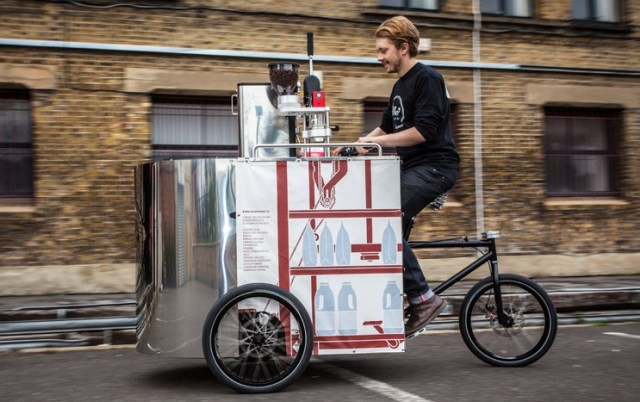
We are surrounded by machines, but it is still only through the earnest efforts of homo sapiens that anything ever actually gets done here. Our fuel, the most important source of power on this planet, (forget fracking), is measured in calories, a beneficial by-product of our neighboring star’s long-burning fires. These handy green shoots live in the earth until their synchronized internal clocks order them all to break out into the air and begin their transformation into Cheerios and cheeseburgers. Not that long ago, most of us spent most of our time tending to this element of our lives. In more recent years, the whole system has appeared to be on automatic pilot, seamlessly delivering the fruits and vegetables, grains and spices that we crave and need. Our re-created Eden often feels just right and few question the inevitability of all this or our qualifications to enjoy its benefits.
In the 1950s, with the rest of the world struggling to re-build and lots of wartime technology to translate into consumer goods, this made sense. In the 21st Century, with the fortunes of the most fortunate and everybody else seemingly heading into different dimensions, the social fabric is stretching to the breaking point and only the most oblivious deny that we are in a heap of trouble. Good jobs are as scarce as hen’s teeth and four-leaf clovers. Nobody wants to leave their current positions, no matter how tired they are of doing it, lest the economy suffers another sharp blow and their protein is called cat food. This dismal situation leaves fewer and fewer good opportunities, so recent college grads are moving in with their parents in record numbers, postponing starting families and wondering if anything will ever change. When you add the accelerating effects of automation and the out-sourcing of nearly everything, the clouds that have been gathering, threaten even darker days ahead.
Owing to a growing sense of uncertainty, we have begun to focus more on our futures. Where does it leave us, if we are fashioning machines to run our machines for us when the next generation of robots, automated cars, etc. appears to move us one full step further from the processes that are responsible for the manufacture of all of these products? Since this meant smokestacks and mines for a century, we heaved a great sigh of relief when more and more of this got off-shored, grateful for the freedom from the conspicuous burdens that accompany this dirty activity. Much later on, it sunk in fully, that there were no ready replacements for all of those missing jobs and whole regions of the country took a drastic nose-dive, while the rust-belt finished rusting. Compared to the noise and dirty dust of the Industrial Revolution, clean service industries like hair-dressing, retailing and food-serving, often paid less but, in some important ways, beat the pants off of dank factories, nasty chemicals and the endless repetition of the assembly line. We thought we were moving ahead.
If you are at a broken stop-light though, how does high tech save you? If you are Detroit and you can’t keep your streetlights on, how long will it be before the water stops flowing? We take everything for granted and we are not prepared for the next phase, whatever it may be. Tending the same burger grill or passing paper bags filled with low-nutrition, highly-processed treats, loaded with sugar and salt and an amazing number of chemicals that you have never even heard of, is also deadening, and it doesn’t take long to realize it. Since you must attempt to project a pleasant demeanor, no matter how you actually feel, there are special demands from this kind of work that even exceed those extracted previously. Monastery-like prohibitions on certain kinds of speech are ordinary, the recitation of insipid conversation, “Have a nice day” etc. is widespread. The loss of individuality and personality beneath a blaze of motivational messages and unending uniformity is the result of this model. A consumer is a puzzle to be solved or a piece to be moved. We are mysteries only to ourselves. Our habits and responses are carefully monitored and processed by a “Feedback Machine” that reinforces an artificial sense of belonging but robs us of our essence, our personhood.
I think the only remedy for this is a great burst of creativity. It is also important that this energy emanates from everywhere not just current centers of activity. When the tools, materials, and skills needed are widespread, so should the ideas and projects be disbursed as widely as possible. Since the issue being addressed here is transportation, the moving of persons and their goods, it is a universal need and a vital factor in the economies and social lives of all those living on this rock. Our growing reliance upon fossil fuels to enable us to get around and grow our crops can not continue. It will either bankrupt us or turn us against one another in the struggle to maintain our lifestyles and the identities that they give us. Droughts and storms are disrupting the supplies of essential foodstuffs and Beijing and Shanghai live in places so polluted that people wear masks every day just to stay alive. The climate-change denial goes on, like the burning eyes and the runny nose, without pause.
If you own a factory, you probably don’t want to hear about “Paradigm Shifts”. If your products become obsolete, you are in trouble. You may even want to slow down the process of change altogether since this is one way to prevent your fade into history. On the other hand, if you are a person looking to have a future, you are paying attention to the shifts in demand and fashion that are going to shape that future and to determine your role in it. This difference in agendas is inevitable, given the difference between institutions and individuals, the pull of the past and the needs of the future. It is more common for individuals to be carried along on the waves generated by institutions than for those organizations to yield to the needs or desires of mere people. There is a way to modify this relationship, to give more leverage to the individual and the key is scale and creativity. Working on the human scale, on lightweight muscle-powered vehicles, for instance, does not require any institutional help. A hacksaw, a discarded bike, and some epoxy or solder and you are in business.
Our hands and our imaginations are the portals to our alternate universes. The other essential ingredient is the appreciation, and help, that others can provide to a project. Cooperation is easy when you are an infant, impossible when you are a restless child and the path to progress when you finally grow up. It is most often brought forward when it is part of a sports program or other activity that is directed from above and requires you to relinquish your will in order to be provided with a role, one which was mostly pre-defined for you. Working from the bottom up without direction from above is uncommon, but that is where the action really lives. Expertise and experience are valuable of course, but the initiative is the first ingredient, along with imagination, and nothing follows without it.
There are three distinct types of small, slow, human-scale and muscle/electric-powered vehicles that need to be re-conceptualized and re-designed. Bikes, work-trikes, and wheelchairs are each deserving of their own study, but share more features than not. In addition, there are so many conditions, from weather to terrain, which is completely different from one place to another, that there is much variety that is absolutely necessary. Other differences, from access to financing options to earning potential, can also have a major influence on developments. Conditions found in highly urbanized spaces, in developed countries, and those in places with poor roads and poor opportunities to re-charge batteries, demand different solutions. The aesthetic element, not as important as the economic, in locales where access to resources is severely limited, may nevertheless be the key to accelerating the needed conversion, from industrial-scale to human-scale transportation. When the public realizes how much color and graceful movement can add to their surroundings, they will insist that this process be nurtured in every way possible.
It is not just here in the dense urban spaces of the Northeast of the USA that this condition, the pollution, traffic delays, threats of harm, and all the rest occur. This is an important matter everywhere. Now that Amazon has announced that they want to provide same-day delivery for groceries, along with everything else, the number of cargo bikes needed is going to multiply quickly. The range of vehicles available to fulfill this mission is small. The ongoing effort to encourage creative design in muscle-powered vehicles, SharingUmbrellas.org is one venue through which designers and makers can expose and share their ideas. We are also using pedicabs that were designed in the 19th century to be used by disposable drivers, who are not even afforded a little protection from the rain. Using small electric-assist motors, this form of transportation can vault into the 21st Century and provide a healthy green form of mobility, much better than the current version of it does. Again, it is a creative design that is the key to a more humane, efficient and colorful edition of this modality.
There are no prizes yet to mobilize this program and nobody denies the benefit of having plenty of resources to fuel activity such as this. It is also important though, to demonstrate that it is the energy provided by individuals, their muscle-power and brain-power, which enables us to take on and resolve the dilemmas that life puts before us. If we want to have our institutions serve us, instead of the other way around, we have to assert our priorities and act on them, not wait for someone else to do it. How many great designs for vehicles, the bike and trike in all of its infinite configurations, wheelchairs and new machines to help the transportation-disadvantaged, are already out there and ready to be evaluated and put into use? How many could there be, if we begin to give this development the attention and importance that it deserves?
The GM Futurama at the 1939 World’s Fair, on the eve of a World War already swallowing up countries and populations, promised a perfect environment. It is not fair to criticize them for being so good at selling their vision, to a public tired of Depression and Prohibition and ready for a consumer-driven society and economy. One consequence of their eventual success though is a roadway system that fills almost all of our spaces. Some of them surround the original site of the Fair itself now, like the infamous Long Island Expressway, referred to as “The longest parking lot in the world”. The peninsula that they lead to now houses millions.
There are possible remedies. Could our highway emergency lanes provide for a continuous flow of slow, (but in many cases faster-moving), small, muscle-powered and electric-assisted devices, protected from the weather and provided with many of the creatures comforts that we can no longer do without? The ELF and TWIKE are good beginnings – as is the mobile coffee shop featured above – but we need an infinitude of variations on the theme. This week begins our celebrations of the Fair that Automobilized our world, and SharingUmbrellas.org says that we need to apply ourselves, on a very broad basis, to redesigning the pedicabs, bikes, trikes and cargo vehicles (and cars) of the future around the human scale. This task belongs to many. At the same time, we should also be fixing the roads, turning some highways into safe 150 MPH speedways, so that our local streets can be turned back into the gardens and play-spaces that can sustain our lives and bring us together, instead of forcing us apart. Fairs, not Fears.
Times Article Viewed: 7492
Apr 06, 2014. Times Article Viewed: 5872
An invitation to use the power of the internet and crowd-sourcing to commemorate the 75th and 50th anniversaries of the New York World’s Fair.

As one way to take notice of these remarkable historical events, designers and builders, artists and engineers, mechanics and craftspeople, are all invited to help invent and make more real, the human-scale, human-powered transportation systems of the future. For the next two years, we are inviting individuals and groups from everywhere on this planet, to submit and exchange their ideas and be part of a massive crowd-sourcing experiment, both online and in your little, or big, neighborhood. We are suggesting that a small plot of public land, or volunteered parking lot or other private property, be provided locally, to help expedite the development of the most beautiful, and highly-functional, cycles and wheelchairs, cargo and passenger-carrying vehicles, the futuristic new machines best suited to serve the needs of our varied environments.
The emphasis must be on safety, affordability, durability, and accessibility but each project is an independent entity and may set its own goals and “rules of the road”. We know that 1HP electric-assist motors on bikes are legal by US Federal statute and important when needed to carry heavyweight or overcome wind or difficult terrain. We are choosing to abide by the 20MPH Federal speed limit on electric-assisted bikes. This project does not permit ICE (Internal Combustion Engine)-Age motors. Throttles are also forbidden, so that the vehicles produced must be pedal-activated and thus may be classified as bicycles, wherever they may be, and welcomed on the road.
Multi-passenger, weather-protected, unusual and unique vehicles are among the most desirable. It can be a drawing, a scale model or a working model. It can be imaginary or completely practical. We are hopeful that this endeavor will enable many connections to be made between creative individuals and others like themselves, who find that they are able to work together, as well as investors and governments, eager to expand this activity for economic, environmental, health or humanitarian reasons.
The World’s Fairs of old were devoted to bringing forth technology that could benefit mankind, were inclusive of all Nations, and endeavored to bring pleasures along with their lessons and marvels. These features are worth preserving. One of the participating sites in Flushing Meadows Corona Park, the site of two great Fairs in the past. Thanks to technology, this event can take place, at the same time, in your city and on your electronic device. In some ways, this may be the first true World’s Fair, open to everyone and devoted to our potential to learn and to dream. It may also be a mechanism to help coordinate the contributions that so many may be able to make to the establishment of an easy-to-negotiate, peaceful, just, and healthful place for ourselves and all others. Please consider beginning a local effort in your neighborhood.
Times Article Viewed: 5872
Mar 23, 2014. Times Article Viewed: 5779

I want to propose a simple way to begin to change society for the better. It costs just a nickel, but first, let me set the stage.
We need water, air, and the occasional snack, to survive. Clothing and a roof over your head may not be quite as essential, depending upon local climate and social customs of course, but are still pretty important. If you are a person of deep faith, you have the conviction that all of this will arrive, in good time, due to the grace of the Almighty. All that is required of you is patience and fortitude and the ability to suffer the pain which comes from realizing that there is still something missing from this picture. It can even feel as if all of this seemingly undeserved and unnecessary distress was put there on purpose, to put your faith to the test, since it feels otherwise to be so purposeless and random.
If you are more modern in your ideas, you might consider it the job of the government to make sure that you can fulfill these basic, human needs. Some would put companionship in the “absolutely needed” column too, but, aside from our sentimental preferences, we have a demonstrated ability to exist, even prosper, without any nearby two-legged accomplices, for quite some time. Got to have drinkable water and breathable air no matter what though. So why are our supplies of both under attack and in jeopardy? Are we completely out of our minds? Do we think that playing Russian Roulette with our essentials makes the game more interesting, raises the stakes and creates excitement out of the mundane? Is it possible that what we have always taken for granted, as belonging to us, is being completely commodified, and that everything has, or will soon have, a price tag, even the air we breathe?
Meanwhile, if so much has been reduced to numbers, pushed so far into the abstract that we can hardly recognize its connection to our reality, how do we push back and reassert the need to recognize, acknowledge, even celebrate that linkage? Since passivity is the ocean that we swim through to reach our life rafts of activity, it is no wonder that there is so little coordination amongst us in this continuous, ongoing process. Each person is too involved in staying afloat, paddling towards their destinations and making sure that there is plenty of oxygen in the immediate vicinity, to worry much about anybody else, except their own blood and kin.
So, if a problem arises which requires the coordinated effort of these various arbitrarily-distanced souls, there is no mechanism for enabling that to take place. The institutions we formerly relied upon, as narrow-focused as they were, religion, proximity and the rest, are moribund. Sports teams serve as place setters for real community and symbols replace actuality. You root for the home team, maybe win a few and probably lose the rest. Then a Katrina happens and we are all brought back down, for a little while, kicking and screaming, to raw reality. Then the Dream Machine kicks in again and we are glued into our easy chairs, back on the program, braced for the next wave.
The ultimate injury suffered here cannot be quantified and in most cases does not even have a name. It is embodied in a concept which we named “empathy”. It is the ability to share someone else’s pleasure or pain, accomplishment or loss. It is natural to us, as is the mechanism which permits us to shut it off and become absorbed in ourselves. If you listen to popular music, the most common word in songs is always “you” and close behind that “love”. The focus is constantly directed to the other, because that is where your affirmation lies, with your lover or your child. The ability to care more for them than for yourself is the path we have been given to escape the tyranny of our own bodies and selves, to displace our attentions and affections on another. Since the other primary drive programmed into us by our natures and our conditioning is to focus on ourselves and to relegate others to bit parts and extras, this is the exposure of our centers to the light, the closest we may ever come to a revelatory experience.
When we can provide all who are alive, and all that is alive, with the grace afforded by these flashes of unselfishness and unification with what is outside of ourselves, this can be a long sea voyage to the land where change lives. Without mechanisms to sustain you on your way, it becomes very difficult to hold your course though, so we need to become designers and builders, to re-form the institutions and methods that we have contrived, or which, in most cases, been imposed on us over time. Since so much of this existing framework was constructed with only minimal feedback from the consumers of all of this society-building, there is obviously a lot of slack to take up.
When the equipment provided to us to help in our encounter with raw nature has been in the manner of weapons, to force nature back into a predictable and beneficial state, for the sake of distributing ever bigger prizes to the populace, there is no reckoning of the long-term effects of so much manipulation of our resources. This is a giant experiment, which many reckon has gone off the tracks, literally, when it comes to trains and figuratively when it comes to everything else. Take the food supply. Here is one thought about how to help put it back on the tracks.
A Nickle’s Worth of Change
Pickers and gatherers of produce, People getting their hands dirty, by pulling roots and breaking stems, filling baskets and boxes, are making about a penny a pound for their work, give or take. When the final products of their efforts are passed along to the consumer, the price will be measured in dollars a pound.
If retailers were willing to mark prices in increments of 5 cents (not a common figure currently) this could be used to signify that they are passing this much down the line, to these hard-working men, women and children, an additional 5 cents per pound for their hard labors. Consumers can make certain this way that those employed to supply them with their needed nutrients are being compensated in a more reasonable way than is common today.
How are foreigners and migrants going to be able to keep track of and report what they are due? Rewarding cooperating growers with better sales will help and a well-monitored program of verification and tracking of funds. Of course, a mechanism must be implemented, to make certain that these funds are not diverted before they reach their intended recipients. For these reasons, one cent of the five will need to be used to devise and operate an efficient and honest process to make certain that everything works as well as humanly possible.
Any funds not needed to administer this program are to be used to enable other populations who are accustomed to receive a minuscule portion of the profits generated through their sweat-fueled efforts, apparel workers, etc., to accomplish this same purpose. Perhaps clothing prices will include a 25 cent additional payment to the gatherers of the raw materials, along with those who sew or dye the cloth, with $.25 prices reflecting retailers’ participation.
Will employers simply lower wages by the amount of these “bonuses”? Unfortunately, some will try to, so effective means must be employed, and constantly improved and updated, to thwart humanity’s worst impulses and habits or nothing will change. Great public shame must be heaped on criminals who rob the poor to help themselves and they must know that they will be identified, blackballed and ejected from civilized commerce.
The details needed to make this a reality must be gleaned from a number of conferences, by telecommunications and in person, and the participation of all those to be affected by these measures, workers, growers, retailers, distributors, and consumers of food. Time is of the essence since this has already taken far too long to implement. These actions must be carried out in harmony with not in place of other attempts to improve the working conditions of all farm laborers.
Times Article Viewed: 5779
Mar 15, 2014. Times Article Viewed: 2003

There is no better way to counteract global warming, change bad societal habits, and to respond to the negative effects of oversized, petroleum-fueled transportation modes and their threat to our economic and atmospheric survival, than to rapidly expand the use of every kind of bike and trike, especially electric-assisted ones and including pedicabs and cargo bikes. Current Federal Environmental laws, the Clean Air Act etc., require that we encourage cycling in every possible way already. Because many traffic laws, involving potentially dangerous behavior by cars and trucks, like sudden turns and excessive speed, are virtually never enforced though, these streets resemble stop and go highways, not pathways. This hazardous environment keeps most people from even considering cycles as a means of transportation, providing an ongoing, illegal, de facto ban on this activity, for them and their families.
Since our city streets have been largely turned into highways, are laws and regulations to limit cycling here calculated to reinforce that identity? It is not just a problem within urban spaces, it also affects the routes into cities, including the bridges and tunnels, many of which prohibit non-motorized vehicles. Marked highways and many other high-speed roads also do not permit any kind of bicycles to be on them, (not that it would be much fun with big trucks running 85 mph), and even “Neighborhood Electric Vehicles” are severely restricted. Is this legal? Couldn’t we use emergency lanes for slow-speed travel? Is it time to overturn the historically lower-class status of the smaller and slower? Is this an undeclared class war, where one side gets the ammunition and the other side gets 20% off discount coupons? Where is the Geneva Convention when we need it?
Fortunately, a Resolution was introduced this week in the NY City Council by Council Member Rafael Espinal [pictured above], which asks the Council to urge the State Legislature to pass their bills, legalizing electric bikes, throughout the State. This will amend the State Vehicle and Traffic laws, to allow electric-assist vehicles to be used. It is clear that for the sake of our future and because we have a moral duty to not do injury to our fellow human beings, we must hurry to expand the role of quiet, non-polluting, least expensive transportation, as the preferred means to provide for our basic human needs. Yet, those who benefit from the poisonous, bloated, unsustainable status quo will not permit this needed change to take place, if they can corrupt the political process enough to prevent it. Here is the press release:
“MARCH 11, 2014 (Brooklyn, NY)- Council Member Rafael L. Espinal, Jr., of Brooklyn today introduced a resolution in support of State legislation that would legalize the use of electric-assisted bicycles in New York. The State bill, introduced by Senator Martin Malavé Dilan and Assembly Member David F. Gantt, would amend the State Vehicle and Traffic law to include electric-assisted bicycles in the definition of bicycles and thus permit their use. “Many people would benefit from the State legalizing the use of electric-assisted bicycles. From people who make food deliveries for a living to commercial cyclists, to people who have health problems, all will benefit from e-bikes,” stated Council Member Espinal.
Council Member Espinal doesn’t understand why New York State has lagged behind and not implemented the Federal standards established in 2002 that set the parameters for electric-assisted bicycles. “It just doesn’t make sense for the State to maintain the status quo. The use of electric-assisted bicycles can have positive effects on New York’s economy and environment. It is a mode of clean transportation.” Others echoed the same sentiment. State Senator Martin Malavé Dilan indicated that it is the right time to move this legislation. “More and more New Yorkers are turning to electric-assisted bicycles as a cost-effective and environmentally responsible alternative mode of transportation. Uses for e-bikes range from the daily commute to local delivery route, but their practicality could also benefit the elderly and disabled. I can’t think of a State and City more suited for the electric bike than New York. The time has come to embrace them,” said Senator Dilan.
The Coalition Urging Responsible Biking, also known as CURB, applauded the introduction of the Council resolution and believes that it is a vital step towards getting the State bill passed. “Electric-assist bicycles are an important new, slow, safe, healthful and economical mode of transportation. We applaud Council Member Espinal’s efforts to make certain that they are available to our citizens, especially the older population, those for whom riding ordinary bicycles is a challenge, and those with long commutes and long workdays,” stated Steve Stollman, a spokesperson for CURB.
No date has been set yet for a hearing on the Council resolution but Council Member Espinal hopes that a vote can take place before Albany ends this year’s legislative session in June.”
The Yellow Taxi industry lobby is one of the most active and well-funded elements of the local Autopoly, which is composed of a variety of large interests. Their influence is legendary. This has never been a fair fight. The history of the current system begins in the 1930’s when GM and Standard Oil used over 400 secret holding companies to destroy this country’s rail infrastructure, from trolleys to interurban rail to rail freight. The way to demolish cycling as a potential rival as urban transport was easy: just design roadways to serve cars and make sure they are as fast-moving, un-policed and potentially dangerous, as they are.
Events over the last few years have given cycling a much higher profile though, and it is already a staple of TV commercials, for cars especially, as symbols of health, self-sufficiency and balance. Meanwhile, the lingering effects of a transit strike some time ago and the arrival of $4 a gallon gas, have had their impacts, along with rapidly escalating awareness of health issues and both personal and societal costs. So. in spite of the most oppressive conditions imaginable, hundreds of thousands have gotten on their bikes in this city in recent years. Bike-share has been a huge help of course, and sidewise, even given a boost to vehicle and ride-share for cars and other similar phenomena. Given proper encouragement, the number of various kinds of cycles, personal, passenger, freight, on the roads in these five boroughs could easily multiply every year, indefinitely, until human-scale transportation became the dominant mode of travel. Shouldn’t that be our goal?
Groningen, a modern industrial city in the Netherlands, has created a system where 50% of all movement is done with bikes. In China, for decades, up to 90% of the transportation in many major cities was through human-powered vehicles of all kinds. India and China are now both following our lead in wastefulness and their recent embrace of cars and motor scooters is adding incredible amounts to the total of pollutants being generated. We must remove the onus from those willing to consume only their rightful portion of space and other resources, and who are now demanding proper protection, from those determined to use many times their share of everything, often recklessly and invariably with an undeserved sense of entitlement.
Multiple-person propulsion is a beneficial evolution that can be encouraged and improved by augmenting it with lightweight electric systems. While tandems are in some use, they are pretty rare, and virtually nothing exists that permits a number of people to ride the same machine at the same time. In the 19th Century, “Sociables”, trikes for a gentleman to give his lady a pleasant excursion, while demonstrating his manly strength and care, were very popular. Potential heavy use of newer designs, useful for everyone but especially by the disabled community, as well as those who are simply having a harder time than previously getting around, justifies a heavy investment in these possibilities. There are already a few examples of machines that accommodate a person in a wheelchair and a second person using a conventional bike as well. This is just one configuration. We could be on the verge of a number of advances in the design of mass transit/multiple user vehicles and even in our definitions of these devices. Especially important are machines that are as useful, to the “Temporarily Able-bodied”, as they are to those with moderate to severe difficulties.
There can be a whole new class of vehicles, which enable us to remain vertical even though the strength of our limbs has begun to fade, but has not disappeared. We can foment conveyances that allow us to continue to travel, in a similar manner to the one we always have, perched on ledges, straight up, instead of crunched down into a wheelchair. We can design systems that will allow us to continue to use our own arms and legs to propel us while we are provided with some electric-assistance as well. These slow-moving vehicles can permit us to get the exercise that we need, in amounts that we determine for ourselves, and remain able to carry on with our lives without being put into the category of “disabled”.
Instead, there is an army of people who seldom wander into the outer world, who are virtually trapped within their living spaces, because there is no way yet for them to simply move about the way they once did, nearly as easily as then. In practice, most of the time, given the proper device, on our largely level land, a user would be relying principally on their own power, thereby gaining some strength and improving overall vitality. At other times, when a little boost is needed, it is provided. Arms and legs being used remain usable. The opposite, sadly, is also true.
In the late 19th century, when bikes were the biggest craze in the country, innumerable devices were built and in use which helped to expand the reach of the field. The use of heavy materials like iron and the lack of modern improvements like aluminum tubing, hi-tech lubricants, and gearing, skinny pneumatic tires, and hydraulic brakes, limited the effectiveness of many of these machines. In many cases, the principles on which they were based were sound though. Multi-person and multi-modal systems are optimal for the sake of our health and our wealth. It is time to re-build the transportation system and replace it with one that works. Pedicabs are one of the first paving stones on the path to sanity on our streets, and we need to look to the future while we also go back to Square One, to find more answers. Porter’s “Wheels and Wheeling” was a complete survey of the many forms of human-powered vehicles of the time, and contain innumerable very interesting ideas, that can now be re-examined for their relevance to this time, 125 years later.
Battery research is finally taking off. Nickel Metal-Hydride and Lithium-Ion are already here and capacitors and fast-charge options are coming on board. The potential of sugar batteries and other exotic ideas to break through and create new industries and possibilities is undeniable and Germany, Japan, and other countries, including this one, are encouraging these developments with funding and other incentives. When we are able to apply these improvements to ultra-light, human-scale vehicles, their utility is expanded maximally, because the weight of batteries ceases to be a serious drag on the potential of the vehicle to meet all of our needs. The weight problem, unfortunately, held back small, electric motor-assisted devices from progressing for many decades, because the law of diminishing returns clocked in early, and the weight of the batteries themselves became an unsustainable burden. Not any more.
Attempts to limit the spread of human-scale and self-propelled transportation, by auto-ad addicted tabloids, TV stations and others, is going to fail. This is in spite of the formidable combined power of parking lots, car companies, the oil industry, insurance interests etc. etc. because the ice shelf is breaking off in huge chunks and even though this is the coldest winter in memory, it was only a year ago, when it was 72 degrees in January, and nobody was buying parkas. People are finally getting really scared. It has taken a huge accumulation of this undeniable, visible evidence, to crack the solid wall of reassuring propaganda put out by the guilty industries. After decades of soothing lies, the fuzzy term “Global Warming” has been replaced by the much less comforting “Extreme Weather” and the deniers and doubters are scurrying for cover.
We have to figure out who are friends are and are not, especially among the public officials who are guiding this process. Some politicians are willing to assassinate the future of cycling here and the radical upgrades to our archaic, and urban-unfriendly transportation system, that they provide. They need to be called out on this, educated, and compelled to explain and change their actions. There are few remedies for what ails us, that are capable of delivering the pleasures that easy-cycling provides. Correcting the problems in our agricultural and medical systems, for instance, is going to involve a lot of pain and radical readjustments. Removing the distortions that have plagued our transportation options over the past century is, by comparison, a walk in the park, or maybe a nice slow ride through one.
The good news is that if we are successful, in our attempts to radically reform our mobility systems, we will have learned enough to consider taking on the even-tougher issues. And we will have a much better chance of dealing with them successfully, once we have developed the networks capable of resolving our transportation conundrum. Dislodging archaic, deeply-dug-in elements of our existing systems, that benefit practically nobody, but have seemingly always been there, is going to generate lots of opposition. Inertia is a powerful force.
Also, we have become so accustomed to taking the path of least resistance, that is, doing nothing, that any approach which fully engages the life-force, will perforce, involve some difficult re-programming. Regardless, we need to re-learn how gratifying it is to overcome, to struggle and to persevere. Just think about how much more satisfying it is to earn something, rather than just being given it. Maybe, in some ways, we should pity the rich. They already have everything, so there are some great pleasures here, that they are unlikely to ever be able to experience, except vicariously. What a pity.
Times Article Viewed: 2003
Mar 09, 2014.
What is taken for granted in most forms of transportation, weather protection, the potential for multiple riders, access to creature comforts and the ability to carry freight, is absent from virtually any current versions of human-powered and other minimum-impact vehicles? Tiny, 1HP electric-assist motors enable a very significant upgrade in the potential for rider satisfaction delivered by human-scale transport. If deployed artfully, these safe, comfortable and attractive little (ideally, shared) devices, can change our mobility paradigm and steer us back onto a sustainable path.
Currently, too many discussions of electric bikes, in this part of the world especially, focus entirely on the behavior of some restaurant deliverers who use these machines to help make it possible to get hot food to impatient customers, while it is still hot. The city has a host of enforcement mechanisms available to influence the various practices of highly-regulated businesses like restaurants. They have already instituted a bunch of regulations, putting big numbers and the names of the restaurants on deliverers backs for instance, and complaints against these hard-working, mostly immigrants, have plummeted. Regardless, the rapid pace of food delivery has nothing to do with our need to expand our transportation options in urban environments, clean up the air and rid our streets of oversized, overpowered and dangerous machines. Tabloid headlines ignore their importance in helping to improve the health and freedom of movement of numerous populations, including the elderly and the out-of-shape. Conflating these issues demolishes our ability to understand them and enjoy the benefits of this new technology.
There is a very active effort, at the moment, to encourage the current electric bicycle-riding food deliverers to modify their behavior in order to lessen the criticism coming from pedestrians, magnified by the tabloids, but real nevertheless. At the same time, the City and State are being asked to fully legalize this important new form of transportation. A group, Coalition Urging Responsible Biking, CURB, is also carrying on a campaign to improve the most upsetting habits of some deliverers, to discourage riding on sidewalks, crowding pedestrians and riding in an overly-aggressive manner. (You may go to www.NYCURB.org if you care to endorse this effort). Posters are being made and distributed and bikes are being modified into a pedal-activated mode, putting them more into line with the current NYC law, which permits this modality but bans throttle-activated models, which are really more like mopeds. Pedal-activated electric-assist bikes are bikes.
The recent bill in the NYS Senate will limit speeds to 20 MPH, as the Federal law requires, so the alleged 25-30 MPH models, if there are any, will need to be retired. The State can require approved vehicles, with less than the1 HP motors that are allowed, to have proper brakes, etc. too, maybe even to have to identify labels, permanently affixed to legal models and end the confusion over this issue.
The city is concerned about enforcement, but the regulation of food delivers’ habits, and bicycle messengers’ before them, has been an ongoing concern for decades, long before bikes became modestly-electrified. The new, stricter regulations, improved education and peer pressure, along with closer relations with the restaurant industry, will do much to correct current problems. Meanwhile, there is no question that nobody should be riding bikes on sidewalks, no matter what. Also, biking so aggressively that it actually threatens pedestrians’ health and safety, should be treated seriously. Of course, in fairness, such a campaign to alter behaviors must include far more dangerous vehicles, from motorcycles to huge trucks too. The targeting of cyclists, riding the least dangerous vehicle, while ignoring potentially fatal maneuvers by far more hazardous vehicles, in the same space, obviously makes no sense.
Amazon and eBay have just announced same-day delivery in NYC and some other cities, soon to be many more no doubt. We know that it will be impossible for an army of vans to further clog up NYC streets with pairs of deliverers heaving packages, of everything under the Sun, everywhere, at once. The brick and mortar universe has no choice but to join the party and seriously improve their own delivery services, in order to keep up with the online onslaught. This new tsunami of traffic can only be accomplished by a giant flotilla of cyclists, many of them soon wheeling new, creatively-designed evolutions of current models. Some of these vehicles will need to be helped along by electric-assist motors. We are leaving the ICE Age. The Internal Combustion Engine and its tendency to inflate the size and weight of our conveyances to historic heights, has reached, maybe even gone well beyond, its limits and is, as a sheet of ice, slowly receding. Happily, in its place, is a bunch of fauna and other earthly delights, especially in the form of some room to get around more easily, smoothly, quickly and safely.
The best examples of this activity currently are pedicabs. Made very popular in South Asia and the Far East, they are only a tourist-gimmick here, not serious transportation, as they have been in some countries for a century. Without an electric-assist motor, carrying three passengers, as is the habit here, in places like Central Park, filled with long hills, makes this job incredibly difficult. The only issue is the fear of some, that an electric-assist motor would turn these colorful trikes into dangerous, deadly projectiles. Fortunately, the industry has already, informally, agreed to a very safe 10 MPH speed limit, to erase such fears from the picture, so there is no reason not to begin to use this needed and highly-appropriate technology today. One benefit is that It will create a huge number of new, good, green jobs, especially for women, who are largely precluded from the profession, due to the brute strength now needed to perform the task. Creative design is an important factor here too, as a tiny motor makes possible improved weather and collision-protection and the provision of a little heat and other amenities.
The standard design of “Safety” bicycles is about 120 years old. It has turned out to be a very durable configuration, but it has not advanced in many ways until the efficiency of the lithium-ion battery freed it from the tyranny of very heavy lead-acid versions. 90+% of the populace does not ride a bike, even once, in a given year. The primary reason, aside from dangerous highway-like roads, is that we have evolved a value system that renders physical effort, unless in a gym or athletic event, unpopular. We are accustomed to easing and the effort of working up a sweat pushing pedals is not a pleasant prospect for most. Yet, we know that everybody needs a certain amount of physical activity, sometimes called exercise, to maintain good health and vitality. Finding a way to accomplish that, in a pleasant way, while also fulfilling another universal need, to get from one place to another, is a terrific discovery.
Electric-assist bikes bring freedom of choice, give you license to determine how much effort you want to expend, at that moment, into your personal transportation. We are accustomed to either/or situations. Once you have made your choice, you are either going to be responsible for your own motive power, or you are going to relinquish it to a motor. Ebikes that are truly pedal-able cycles, that work very well even without any motor assist, were very rare until quite recently, but are now widely available. What this means is that the user is able, from moment to moment, to evaluate their situation and determine how much energy they themselves want to provide and how much they prefer to gain from the motor.
This decision is made by you, not the machine. This arrangement puts the human species, its needs and potential contributions, first. It takes the decision-making power away from the machine and it gives it back to the person operating it. This is revolutionary. It is paradoxical too. Because you give your energy to something, you are empowered. While some cyclists may prefer a purer form of muscle-powered biking, the other 90+% of the population in this State is currently being denied legal access to those devices that would best enable them to get some healthy exercise and have an easy, un-sweaty journey, at the same time. We are also being denied the opportunity to recover our will, our capacity to choose.
This is nuts. And it’s just not fair. It is a form of bullying, a system that allows resources according to what you already have. It rewards aggression instead of accomplishment and produces a flood of white noise that drowns out the music. The difference between being carried along and moving is profound. Combining the two is a new experience for most of us and more closely resembles the natural matrix within which we all find ourselves. It suggests the next step, where we are players of music instead of just listeners, designers and sewers of clothing instead of just wearers, makers of something besides supper. We’re getting closer to the moment when we find ourselves, as a survival mechanism, becoming Socratic skeptics, who have run out of patience with the pat answers and transparent myths that compel us to be true believers, when, what that really means, is shutting down your mind. Waking up our bodies, teaching ourselves to merge human energy with mechanical forces and harmonizing them could be one sure step towards re-booting and re-balancing our entire system. So what are we waiting for?
Mar 02, 2014
25 years ago we put on a show at the Municipal Art Society in NYC called “Going Nowhere Fast”. It covered a full range of transportation modalities and identified the problems and possibilities inherent in them, from Rail Freight to Solar Cars. It was a largely dismal survey of the state of our services, some history and some opining as to the future. During the months that it was up there, we held panels and attracted some attention to the issue, but an honest assessment of the results would conclude that it wasn’t going to make much of a difference. I’m glad we did it but its title was far more prescient than I would have wished. The same show could go up again, (and I still have all of the original 6′ tall panels,) it would be very hard to find anything that was not as true today as it was then.
The direction that we are headed has been established for at least the 75 years, since the GM FUTURAMA dominated the 1939 NY World’s Fair. Now better known as the title of a freaky but funny TV cartoon show about robots and intelligent crustaceons, this pre-war giant, 3D, moving panorama, was a full-immersion spectacle. It was calculated to sell the maximum number of cars, which, ironically, at that moment were becoming impossible to buy, since every plant was soon fully engaged in war materiel production. The picture that is painted of the world to be, was not far off in many respects too, even if the automated roadway that it promised for 1960, is only now coming into focus. The suburbs, stretching out forever, the little houses and their little yards, once the nasty war was out of the way, became the shape of our suburban universe, from Long Island to Catalina Island.
At the same moment, the MAS exhibit was being prepared, what the NY Times’ energy maven, Matthew Wald, accompanying us, referred to us as a “ragtag” crew of vehicle designers and builders, was making its way slowly from Washington DC to NYC. This caravan, that we labeled LightWheels, over a week’s time, stayed in college dorms and other available venues and made its way across the landscape in short bursts, setting up, in each location, for a local show and tell, and press event. Since we had the beautiful Stanford University Solar Racer as our glamorous centerpiece we attracted positive attention and lots of stories about the technologies that could change the direction of our transportation systems and put us on a more sustainable path. Electric bikes and handmade Solar vehicles converted electric cars and utility vehicles all demonstrated the possibility of non-highway-centered, or petroleum-fueled and human-scale transportation options. We even gave people a chance to try them out.
It was certainly not as impressive as the 10-day Tour de Sol events taking place in Switzerland throughout the 80’s, with hundreds of vehicles and thousands of spectators. We probably did give some impetus to those who decided to try to reproduce the European event here, the Northeast Solar Energy Association. They spent years doing an Americanized version of the Swiss event, found some corporate sponsorship, mostly from car companies, and eventually banned human-powered vehicles entirely, thus forsaking the central rationale of the original event. Our demonstrations in DC were difficult to arrange and greeted with considerable indifference but we persevered nevertheless. In the days before Lithium-Ion batteries, the burden of dragging so much lead around in order to advance the technology of personal transportation was really too much to bear, and hard to justify, and electric vehicle acceptance stalled for decades partly over this lack. There were those like Jim Warden of MIT, who worked around these limitations in the 80s and bragged of vehicles with hundreds of miles of range and other remarkable accomplishments, but even hard information about advances was so badly covered, that it made little difference. Bravo Bill Moore.
One of those who we expected to be supportive of us in DC, for all of its irony, was Jay Rockefeller, Senator from West Virginia, scion of the great Rockefeller dynasty. When I called his office I expected a rousing welcome and invitation to visit, along with the sponsorship of a reception on the steps of the Capitol. Instead, I was given a short lesson in economics and a friendly rebuff. It was explained to me that Mr. Rockefeller was, indeed, a strong proponent of electric cars. The reason for this was his understanding that these nice, big, heavy cars would consume a large quantity of electricity which would end up being generated by the burning of coal, which was mined in his state and he was strongly in favor of this. But, since I had explained to her that we had a double purpose, to promote the virtues of electric-powered mobility and the benefits to be garnered by the scaling down of our needs, to emphasize the virtues of human-scale applications of this technology in electric bikes and other minimal configurations, her interest disappeared. She was, at least, honest enough to explain to me that this was not going to require the massive consumption of coal, which was the primary interest of the Senator, and therefore he would not be interested in being helpful to us.
There is a similar disinterest in this subject evidenced by the major media. There are no bike ads or electric-vehicle commercials on TV. The biggest individual advertisers may be mobile phone companies, but overall, the Automobile industry is the biggest factor in all paid media. The bicycle industry has always suffered from an inferiority complex when it comes to heavy-duty promotion. The only exception to this in modern times is the popularity which the Tour de France had occupied, since an American became the biggest winner in the race in history. TV coverage improved and the beautiful French countryside is very photogenic, the non-stop picnic by the side of the road pleasant-looking and engaging. Of course we now know that this was not the pure athletic spectacle that we had been led to believe it was, but rather a wild, cross-country drug-fest. Cycling, an activity considered so healthy that it decorates an amazing percentage of prescription drug ads, is a victim of the same over the top, insanely competitive and out-of-proportion tendencies, rampant in every other aspect of our lives.
As transportation, cycling is in its infancy. Denmark may be the leader of the pack, but once upon a time it was Vietnam that was reknowned for the ubiquity of its bicycles. There is no doubt that this was a feature of a society with meager access to resources, a poor country where the population could not afford anything but a bicycle to get around on. It can be romanticized as a portrayal of a place with unusual balance in its habits, or one which is close to the ground and essential, rather than caught up in Western materialism. Regardless, increased prosperity has brought with it a flood of scooters and motorbikes with plenty of automobiles thrown in for good measure. Bikes are for those with no choice.
Mechanization is surely one element of the process which enables populations to begin to enjoy the comforts and pleasures that come with a consumer society. It is not a sign of cultural decline when peasants can educate their children, get their goods to market and do less back-breaking work, although factory environments can surely be life-deadening. It is, nevertheless, the slippery slope that we call “advanced” and “developed”. Those of meager means, the vast majority of all of those who are alive now, here and around the world, are constantly being reminded of the wonderfulness of all of the goods that will be their ticket to a better way of life.
Whether it is a pack of cigarettes or a new TV, the game is on, the girls in the ads are very pretty, and we will be judged by our success at climbing this ladder into status and prosperity. It is a seduction, plain and simple and more sleaze, tease and wheeze than the promised Stairway to Heaven, but at least it suggests that there is a way forward and maybe even a way out. Climbing over the bodies of your neighbors to gain elevation has its hazards though, and unless dizziness is your goal, whatever you do, don’t look back and don’t look down.
Feb 23, 2014.
It appears to me that we are turning into a world of activists, that we are reversing decades of minimum involvement by the masses in the determination of their destinies. It is happening on different continents and the response of established governments is not exactly the same, although the resistance to change is the most common response, and violence is often the result. In this country, ever since the under-reported and failed anti-war protest of ten years ago, it has been a sad period for political activism, aside from the Tea Party version. Curiously, the original, colonial Tea Party, was a bit of blame-the-victim, racist, black-bag op terrorism, with a spoonful of patriotism, and so is the current one for many of its most passionate adherents. The difference is that back then, we were rising up against protected monopolies and giant corporations, whereas the current version is largely funded by these megaliths.
We can do better, much better. If we need a theme song, how about the Automat’s egalitarian and inclusive “Let’s have another cup of coffee”? We can organize friendly people in all the coffee shops, and let the people who have trouble with including everybody, have tea shops. We can have Starbucks and the corner diner and the morning breakfast table and they can have the crumpets. We can have meetings morning noon and night, all over town, to figure out how to take back this puppy from the beast. Confused and frightened people, looking for help are being told, ”Sharing is Socialism”. So elevators and trains must be hotbeds of Marxism, and water mains and sidewalks a sinister, devious plot, to tie us together and make us dependent.
So what is the needed response to the Tea Party? COCOA, Coffee Conversation Action maybe? It’s not a Party exactly, (even though a little fun is always a welcome relief from the tedium), or a means to anoint the already too self-important with additional titles and privileges. Rather it’s a minimal mechanism for building an energetic, ongoing, constantly-evolving plan to maximize the chances that our species can have a healthy future on this rock. It is also an action agenda, without hysterical, lying demagogues, and without non-stop, one-dimensional self-interest masquerading itself as the common good and crushing our humanity in its path. We had sound-outs and teach-ins, but we need a continuously-refreshed framework that frees us with the truth instead of confining us in lies, open for business wherever and whenever sippers meet.
That’s the Coffee Conversation Action Agenda, COCOA2. Namely: Move over a little so there’s room for everybody and when it’s freezing out there, who doesn’t need something hot to drink to help take off the edge? No matter how cold the facts get out here, friend, in the coming days, please remember what your Mom told you about what you had to do if you wanted to get into Heaven, and make mine hot Cocoa thank you, not hate-filled Cuckoo.
The ’60s are portrayed as “Sex, Drugs and Rock and Roll”. This is not inaccurate as much as it is incomplete. I would add “Exploring, Questioning and Demanding Proof”. Faced by the prospect of being drafted into a war that seemed totally unjustified, which was being sold as a Modern Crusade, against both Militant Buddhism and Atheistic Communism, members of my g-g-g-generation needed to process, and act upon, each of these three oxymorons, of stupendous contradictory magnitude, simultaneously. Fortunately, we baby boomers had the help of psychedelics and other multi-dimensional lubrication or the stresses created could easily have sent the entire of us down the Rabbit Hole for good. Of course, we had Gracie Slick as our travel agent and Vietnam vet, Country Joe and the Fish, winding us up with the “I feel like I’m fixin’ to die rag”, so the luckiest among us never got lost in the maze or fooled by the cover story.
We expected that the realizations being experienced by nearly everyone, the appreciation of the importance of Civil rights and even more subtle questions like gender-equality and Women’s rights, would inevitably lead to more honest and equitable society. All forms of music were being listened to and combined within a single song or album as East met West and everybody shook their behinds in what felt like your own special way. Many will argue that the ideals revered in the ’60s, tolerance, peace, free expression and love of your fellow-creature, obscured the more serious issues like survival and crime, but the dramatic increase in political participation and activism was a sign of health and vitality in a largely self-satisfied society.
The sixties gave us a whole population unwilling to accept its prerogatives and privileges at the expense of their fellow-creature, who questioned every single verity and turned a lot of them into cartoons that gave them the status and perspective needed to understand them.
Feb 16, 2014
Oddly, when charts are made, measuring the use of energy and its production, the most important form of it, human-power, is ordinarily excluded entirely. Fueled by calories, most available from rooftops, yards, fields, and window-boxes, truly locally-grown foodstuffs, we require only muscle-power, with a little help from our fiery neighboring star, to prosper. We’ve pummeled her with abuse and continue to, but Mother Earth still pushes forth new life unceasingly, regardless. As for us, the machines, people, give us water and something to chew on and we are amazingly productive devices. It is not just salty sweat being manufactured either, it is also brilliant labor-saving insights that are being generated. Think about how hard life would be without N.Tesla’s AC current, his induction motors and electric starter in your car. It is our good fortune that homo sapiens have been gifted with an infinitude of skills and constructive inspirations spread, albeit somewhat unevenly but still universally, amongst us. How lucky can a species be?
Were we, as a whole, to develop the means to have easy and free access to this rich pool of resources, we would certainly find ourselves on the critical path to our most fulfilling destinies. By unleashing this phenomenal storehouse of wealth, composed of the sum of the vast knowledge gained by all of us, through our jobs, our experiences, and adventures, we thereby enter the Age of Abundance and leave the Age of Scarcity behind. Unfortunately, we have spent centuries, weighed down by an incomplete picture of biology, weather and such, searching for better answers to our questions, rationing our goods, providing them only to those with the means. This is our history.
Now that we are able to produce a virtually infinite amount of anything, it is only through the systematic waste of resources, especially the human ones, that it has been possible to maintain the myth of scarcity within an obscuring cloud of overabundance, for the last several decades. While the armed conflict has been the most effective way to destroy the value of both the material world as well as the living one, a century of overconsumption has left its mark on every activity. Meantime, those with factories want them to run continuously, so the first task becomes convincing everybody both that they need this thing, beyond reason, and the last, that they should not share it with anybody else. Planned obsolescence and raging fashionability will do the rest. The Waste-God must be served or the wheels of commerce grind to a halt and we are done for, or so the market says or curses if you will.
While bike-sharing and other attempts to get a grip on this suicidal drive are gaining serious traction, this good news for almost all of us is anything but that, to those whose activities provide them with huge profits from the generation of waste. The military establishment, for instance, will fight like mad to preserve their benefits for themselves. They are able and willing to do this in spite of the damage it wreaks on their fellow-creatures, and sometimes even on themselves, but they can not stop their destructive ways, because they have no way to sustain their current lifestyles without these profits. They are addicted to the ability to have their way, to superimpose their view of reality and their bankrupt value system on a pacified public. They are supported by those who pretend that the numbers tell the story and can never focus down closely enough on what is on the ground, to include it in their world-view.
One feature of our profound misuse of resources is in the prison system. A famous wag once claimed that if you steal a loaf of bread, they will put you in jail whereas if you steal a railroad, they make you a US Senator. A friend of mine was featured on CNN this morning, being granted bail for the crime of being a heroin addict and being accused, falsely it turns out, of supplying Philip Seymour Hoffman with his fatal overdose. This fellow, Robert Aaron, is renowned within the city’s musical community as one of the most accomplished and talented musicians around. He is also one of the nicest and most modest and generous people you might have the pleasure to meet. He is the polar opposite of the stereotype of a junkie, the useless slouch, dangerous and untrustworthy person. He works constantly, sometimes for very small pay, often to help aspiring artists to establish their presence. He plays in scores of styles and on a dozen instruments. Wyclef Jean, who he arranged for and played with for a decade, Mick Jagger, David Bowie and hundreds of other musicians, have improved their offerings due to his attentions. Now he is facing prison and our loss of access to his gifts, because of his current need for his, admittedly often self-destructive, medicine. The system is ready to relegate this fine, non-violent, talented person to a bare cell, where he can no longer help anyone to realize themselves, or to enlighten us. A total waste. (Contributions to his bail fund are welcome.)
Meanwhile, prisons have become an “industry”, with profit-centers and ROI charts. The society with the highest rates of incarceration is also the one which has the greatest propensity to reduce everything to numbers, to de-humanize and disguise what amounts to institutional torture. Sure, those who harm others must be held accountable in order to reduce this kind of activity, but is punishing and causing pain to people a way to improve them or is it just a form of rough vengeance, a page torn from the stone age?
We do the same thing to older folks, who have slowed down or whose skills are less needed because of onrushing automation or outsourcing. Couldn’t schools make room to allow those with a lifetime of learning, to be enabled to pass that valuable information down to the next generation? At the end of the 19th century, with industrialization taking full hold, innumerable hand-crafts were rendered obsolete and its skilled practitioners put out of work. Wood and metal workers with centuries of development contributing to their production of useful and beautiful products were rendered irrelevant, because there was a machine that could do it almost as good, or even sometimes a little better, at a rate thousands of times faster than their hands could match. An army of illustrators, fine artists, could no longer afford to fill their brushes and pens with India ink after the technology of taking and printing photographs took hold. Their loss? No, ours.
With clothing, imagine the work needed to handpick raw material, process it into yarn or thread, weave it into the fabric and make it into a garment, compared with our mechanized version of mass production, engineered by giant machines. Delivering a complex and finished piece of clothing, made by handwork only, is still the rule in some parts of the world but only the very poor or very rich have access to this system. The ability of machines to be so productive has been a mighty boon to our assumptions about what we are due and we have become used to having it all. A closet and dresser filled with garments that once would have taken a regal sweatshop to provide us with, could, until quite recently, only have belonged to a member of a noble family but instead, these former luxury items were bought for a pittance from a huge chain store. We are drowning in products but we have lost our self-identity as producers.
Likewise our food. If you had been a member of the royal family of a 19th-century empire, the presence of fresh fruit in the colder months or any foods out of season would have indicated a truly elite status. In fact, the range of ordinary products available to the masses, from soft cushioned toilet paper to a shelf of 100 exotic spices from around the world, were not easily acquired by even the most privileged members of any society in former times. Yet, we take them all for granted, without half a thought. The technologies that made it possible to live like a KIng, on a pauper’s ransom, have accustomed us to a level of comfort and ease that were unimaginable heretofore. One consequence of this is our unsupportable assumption that we should be able to have unlimited access to everything. Along with this sense of entitlement has come a lack of concern about the origins or consequences of this condition. One of the seemingly inevitable results of overabundance is a lack of understanding of or responsibility for the downside of this equation.
When it comes to transportation, the most egregious examples of imbalanced activity are to be found here. A stretch Hummer is a potent symbol for all that is wrong with this picture. It is instructive that the origin of this abomination is to be found on the field of battle. It is a weapon in the form of an automobile. We can combine its purposes as a life-protecting device into one of a life-destroying one and these identities merge and blend into one another seamlessly. It is wonderful to feel impervious in a dangerous world but our vulnerability is always with us, no matter what.
We spend a lot of energy projecting strength, and swagger with a coating of suave will always be a crowd-pleaser. Displaying this on the outside is often a cover for a lack of inner confidence and durability on the inside though. The cure for elitist, top-down definitions of our value and nature, is much more bottom-up, creative and life-affirming phenomena. Block parties without the tube socks. The stakes keep getting higher and the time to repair the breach shorter. I keep thinking that this is something about the importance of music, and its main components, like harmony, tone and pace, style and rhythm. Meanwhile, if we do have to sing for our supper, I think we should at least be able to pick the tune, and choose the main course, and be treated like guests, not servants.
You can hear some of my songs, free, on http://www.SteveStollman.com/ produced and with musical accompaniment by Robert Aaron, on all wind & string instruments and keyboards.
Jan 26, 2014.
I’m not sure what Disqus is, but I know it eats comments. One of the pleasures of writing pieces like this is the responses that it can provoke. Sadly, often nothing is said in response to the 2000 or so, of what I am willing to admit are sometimes intentionally-provocative words, that get thrown down on these pages every week. This, in spite of a thousand or more visits. The length of those visits is unknown and they may be mostly quick hellos rather than deep conversations, still, it has been the case, some weeks, that a half dozen or more visitors have decided, after they have finished reading, to make their feelings known at the bottom of the page. Sometimes these have been very complimentary and friendly and other times not. This is normal, to be expected, and include plenty of disagreements or differences of opinion. Truth be known, regardless, I wish every one of you would say something, even if it was minimal, give an opinion, state a fact, but…
For some reason, Disqus, the mechanism employed to capture and display comments on EVWorld, likes to show them when it feels like it and otherwise keeps them secret. Odd but true. Since this is my 20th contribution in a row to this blog, which has become a regular feature of my life for a bit, I will admit that I miss the occasional barbs and bouquets. I wonder if they were taken out to a lonely field, like in an episode of the Sopranos or Boardwalk Empire, and dispatched in the tall grass, or given a more dignified end, perhaps in a restful archive by the sea, or slowly floating cloud. I have seen them come back to life a few times too, only to disappear once again, an agonizing flashback to what might have been and actually was, but is no more.
I had a job once, which may have been my best one ever, being the head waiter, really doorman, at the Village Vanguard, a jazz music club in Greenwich Village for the past 500 or so years. As this was a place that many luminaries made it a point to record at, it had a heady bill on, almost continuously. At this time it was a couple of famous musical giants, bassist Charles Mingus and saxophonist Coleman Hawkins, each with their own groups. Since both of these fellows could be described as Demi-Gods of their craft, some of the greatest artists of our time in any field, I wish I had spent more time listening to their mutterings and exclamations, but I do remember one. Mingus was notorious for his displeasure at the bad, which is to say inattentive, the behavior of his audience. This was a club, with drinks and a small amount of food, no hushed concert hall, but the sounds made there, at times, were as amazing, transporting and important, as any made anywhere.
Regardless of the fact that this was a basement joint, in a raucous neighborhood, Mingus would simply stop the music, if there was too much noise and too little appreciation that this was the finest music on the planet being performed before them. In one such episode, after he stormed off the stage, I remember “The Hawk”, as he was popularly known, nattily dressed, standing ramrod straight but not very tall, approaching the great bass player and telling him, “You have to play them quiet Charles”, in a sympathetic but chiding voice. The point is, if I expect more people to make more comments about my writing, I’m going to have to “Play them noisy”, more openly daring them, that is you, to join the picture and establish a presence.
I notice that a few weeks ago, Popular Science decided to abandon their comment function altogether. Too many little spats and petty problems probably, which took up space and discouraged others with more substantial points to make, from even participating. Who wants to get lost among the slings and arrows filling the air, aimed at nobody in particular? I’m sure their legal department was pelted with controversies over libel and patent infringement and other matters which soaked up time and bled expenses. It is a sad day though when scientific and technical inquiry can not be matters for lively discussion and widely varying points of view. Fortunately, there are still many many thousands, maybe millions, of online forums on every imaginable subject to help promote healthy controversy and fact dissemination. Generating directories, that rate them according to their relevance and popularity, needs to be a priority, and that process is, thankfully, well underway.
Sure, there is plenty that is of little weight or value in the mix, but also a lot of important information, that is now having a much easier time finding its way to the public. In balance, the flood of new information is a boon to honest inquiry, even if it is also hard to sift through and the major outlet for loony stuff too. The filters that have always been there, to separate the wheat from the chaff (and too often, to serve the chaff and call it wheat), claim a high degree of reliability for their product. It used to be that if you read it in the paper it was true. The TV had the same power, to grant, to their presentations, an aura of certainty and finality. It was rare that they actually deserved such confidence, but there wasn’t much competition. It is clear, in many minds, that the opposite is now the case.
We are having to be much more discerning, to question the quality of our sources, to come to rely on certain ones because of their proven track records. We have been lied to and misled too often, and by experts, to simply accept what we are told without a high degree of skepticism. Our gratitude must go out to the Bill Moore’s of this world, who devote such a substantial portion of their life on this planet, to trying to figure out what matters and what is true, because it is beyond the ability of each of us to do this for ourselves. I opined in one of my previous pieces about the way in which the commercial media serves the interests of its advertisers rather than its consumers. The movement away from that integrity-sapping formula, is what is needed, and demonstrated by EVWorld and many other worthwhile and truth-seeking web sources.
The Underground Press of the 60s and 70s forced the aboveground press to pay more attention to differing viewpoints. I was proud to be its distributor for a time here in NYC. Unfortunately, the shrinking of the printed press has left us with somewhat fewer of them as potential sources, even while the world of apps and blogs has multiplied the total of potential resources, all reachable free, easily and electronically, by a factor of infinity. The increase of Localism is partly a realization that common conditions, even those prevalent on a broad scale, can often best be affected by the collection of individuals, in physical reach of one another. This has been most conspicuous when it comes to food issues, especially in areas where there is local production of some kind. The addition of community gardens, roofs and other projects in urban spaces is growing rapidly too. Interest in the origins of what ends up on your table is surging and CSAs and variations on them are spreading every day. The connections between the most mundane daily concerns and the big questions, the ones that supposedly matter most, become more apparent every day.
The Chicago SEED, the Atlanta Great Speckled Bird, the L.A Free Press and all the rest of the Undergrounds were totally independent and self-reliant operations. The late ’60s generated much interest in the ways that governments functioned or didn’t, on account of the war primarily but for many other reasons too …
Oct 13, 2013. Article Viewed 1482 Times
The Permian Extinction took 95% of all living species. It is thought to have been caused by the release of a great store of methane from its oceanic vault, following volcanic activity in Siberia, powerful enough to warm the seas sufficiently to trigger this momentous killing event. Being subjected to natural forces this significant is impossible to avoid completely since we are simply temporary boarders here not the hoteliers. Voluntarily bringing about a catastrophe of this magnitude though, which is widely predicted to mirror the former calamitous scenario, is beyond madness. Yet, this is the path we have been put on, and we ought to be a lot unhappier about it than we are.
Ward McAllister, a social chronicler of the late 19th century, calculated that 400 of the most important swells of the time could fill Mrs. Astor’s ballroom and this became known as the ultimate measure of status, not dissimilar to the Fortune 500 perhaps. I suppose the same tiny number of exceptionally privileged people are the very ones who will be invited onto the Heavenly Biosphere, ready to re-populate the earth and assert their ultimate superiority by surviving the catastrophe that all of them have been so strategic in bringing about. A few may suspect, between cocktails, that this was the plan all along.
The US is now the world’s top energy producer, according to the WSJ and MSNBC’s caffein-addled Joe expects the effect of this is going to be “staggering”. No doubt he means that we are in a stronger and better situation, no longer completely at the mercy of some sheik in sheep’s clothing or Russian oil Czar. Missing from the equation is the contribution made to the total by human energy, hands, and fingers, human power, muscle power, fueled by calories from food instead of barrels of oil or tank-loads of liquid gas or rail cars of coal. Every time something is lifted, or pulled or pushed or bent or chipped or scraped by hand, energy is expended and even in a world that has been industrialized to its limit, there is still a huge proportion of “work” performed by mere homo sapiens using their bodies and sweat to bring about the needed result. When energy sources are measured, nuclear, petroleum and coal with a few renewables thrown in, is all that is spoken of, although all of our original arts and crafts are still alive and essential in the mix. Deep down we know that human transport, by walking our 10,000 steps a day or pushing the pedals on a bike is an essential aspect of preserving and enhancing our lives, not a cumbersome burden. Ease beckons though, and we vegetate.
When analyzing economic data a good deal is made of the cost of materials and the cost of labor. Factoring in the cost of the education of the people doing the work or their degree of satisfaction with their lives and their efforts is seldom mentioned, even though it might be, in the final analysis, the most important element of all. Human-powered equipment, designed to be operated on the human-scale, like bikes, some farm equipment, for that matter most kinds of computer and assembly work, comprises a huge proportion of the work being done every day around the world. While there are other power sources being used, electricity, animal, water, etc. the indispensable element has always been and remains, for the moment, the human one.
Regardless, since the trend over time has been to replace the human-powered with the mechanical or electronic, we have now reached the point where we can automate so deeply that the danger is that we are seemingly running out of the need for people altogether. Unemployment is not just a feature of an economy not operating at full speed, it is a permanent condition since we are no longer in need of very much maintenance and supervision for these machines. They are even being taught to repair themselves. It is not just factory workers, even doctors and lawyers are being rendered less useful by the day as every task, no matter how complex or difficult, is being assigned to an app or mechanical robot to deal with. Meanwhile, we busy ourselves with the increasingly trivial, social networking that concentrates on keeping you in close touch with your host of friends while the rest of the population learns to ignore you as well as you ignore them. Is this still a society, or just a bunch of random pieces of the flesh who have lost interest in forming themselves into a picture, who have learned to love their fragmentation as much as they once reveled in their connectedness?
Meanwhile, water downstream from a fracking operation in Pennsylvania is showing alarming levels of radiation, 200 times the normal. This is a minuscule problem of course compared to what is happening in Fukushima Japan, where water containment vessels are springing leaks and an immense pile of still radioactive material is perched precariously atop destroyed reactors and the government is having as much trouble containing the information about the risks which are now growing more treacherous continuously, as the engineers are having to try to do the seemingly impossible task of cooling off this hellacious fire. I thought that conservative politicians and political conservatives, in general, were risk-averse, eager to protect their treasures from eroding in value or putting their lives and futures in jeopardy. Actually, science-denial, the foundation of any belief system that relies upon magic and superstition, is essential to most myth-making institutions, be they religion-based, profit-making, pleasure-intoxicated or simply power-addled and unable to let go.
If the price of oil goes down sufficiently, this form of extraction, currently destined to destroy a serious portion of our dwindling clean groundwater supply, is no longer viable. So here is another powerful reason for one arm of the energy industry to keep oil prices as high as possible to protect its other arm. Can’t let the price get too high of course or too many people will switch to electric or hybrid cars and damage the market. These calculations are crucial to the foreign policy and economic decisions of scores of nations including “Superpowers” like Russia and the US. It is a mystery to me, why we would let a small handful of self-centered interests dominate our common interests, except that they’ve been doing it for what seems like forever. They spend a lot of money to convince us that they are our friends and appear to do a simply terrific job of doing that, but innumerable Gulf of Mexico critters would strongly disagree with their campaign of self-congratulation. Melting the Arctic so that a fleet of oil tankers can shave some miles off their long journeys is easily the worst bargain in the history of the planet earth, and we are being told that we are the “beneficiaries” of this chilly gift. Hardly.
Since energy is so important in the production and movement of foodstuffs, the consequences of price manipulation affect the price of other necessities as well. It is no wonder that people feel powerless in the face of forces so strong and seemingly uncaring. It is not just foreign policy and other great matters that seem beyond our understanding or influence, it is even the skies above our heads that are filled with mysteries. Rumors of such dangerous and secret practices as climate manipulation through the seeding of clouds with aluminum and other potential toxins swirl about, still considered unproven but with more convincing evidence accumulating daily. The undeniable loss of the livability of the breathable portion of the atmosphere to pollution and political and economic expediency, begs the question, “Who is watching the store?” and how come the back door got left open and the shelves are bare?
Frankly, I don’t think we can solve this problem through more talking and petitioning and complaining. If we have the capacity, species-wide, to take on these challenges by applying our creative talents to the case, there is some possibility of emerging bruised but intact. Look at SharingUmbrellas.org and let me know what you think. There are artists and craftspeople and designers and builders who can bring some new thinking to the fore and raise our aspirations sufficiently to make a difference. I fear that unless we are able to provoke the makers and the dreamers to enter the fray and deploy their talents, we are destined to tumble over the cliff we are being led to, clutching our smartphones to our breastbones and screaming “No bars, no bars, no bars”.
Your thoughts?
Commentary Viewed 1482 Times
Jul 22, 2013. Article Viewed 6541 Times
Now that the NYS legislature has ratified its identity as the lamest State Legislature in the country by once again failing to pass a bill legalizing electric-assist bikes, the campaign to reverse this mindless course is already beginning. Since this part-time governing body suspends all activity during a Summer recess that does not end until the New Year, there is plenty of time to strategize and plan for the next Sisyphean assault on Albany Mountain.
Unfortunately, there are two distinct approaches being taken by the two bodies and that must also be resolved. Ass. Gantt is convinced that adults must be forced to wear helmets on these machines, in spite of the urging of NYC’s, NYS’s, and all the National bike groups’ insistence that, as with ordinary bicycles, this decision needs to be left up to each adult person to make for themselves. That is in addition to the numerous scientific studies from both here and abroad that prove that requiring helmets is, on balance, a very, very bad idea. One important factor is that it reduces the number of riders so substantially that it makes it much more dangerous for everybody else. Counter-intuitive but true. Also irrelevant to your own personal decision whether you want to use one or not, but this is a perfect case of “Don’t confuse me with the facts, I’ve already made up my mind”. He also insists that nobody under 16 years of age be able to ride as a passenger. This inexplicable limitation means that an electric-assisted bike can never function as a family vehicle, one of its greatest potential uses. In contrast, the Senate bill simply reflects the Federal requirements, one horsepower, 20 MPH, etc. Reconciling these two bills will require prodigious effort, made more difficult since we are still saddled with a Medieval, top-down political system, with leaders as Barons and Committee Chairs as Dukes. Maybe an e-bike jousting tournament would catch their attention.
Speaking of Royalty, it appears that the exiting Mayor of NYC, Mike Bloomberg, was the person who applied the coup de grace to this year’s attempt to bring mobility sanity to the Empire State. It seems that the bike-share program in NYC, one of the Mayor’s pet projects, is achieving major success. A million rides and no serious accidents later, the nay-sayers are holding their tongues for the moment. While over-large docking stations and pervasive outdoor ads are aggravating some citizens, even reporters are being charmed by the ubiquity and utility of these lumbering devices. Unfortunately, Mr. Bloomberg, before the popularity of the bike share system had been established, decided to shield himself from some of the nasty tabloid editorials equating electric bikes with the riding habits of the energetic immigrants hauling hot food around the town to their hungry and anxious customers. To keep from being labeled rabidly pro-bike, while these same car-ad filled excuses for journalism lambasted him for bike lanes, bike share, e-bike deliverers, etc. etc. he decided to defend his reputation by trashing e-bikes.
Strategic? Certainly. Hypocritical? At least grossly inconsistent. Reversible? He won’t be in office next year. It is really a shame that another year must be wasted. Both branches of the legislature, this year, wrote bills which were then taken to their “third reading”, which meant that they were ready to be voted on. Then, from what is being said, the Mayor used some of the brownie points he had accumulated when he decided to personally donate considerable sums of money to a variety of Republican State politicians. The leverage that this provided him was enough to put an umbrella in the spokes of this pro-bicycle legislation, a strange action by the most pro-bike elected official ever in this part of the world. It might have made more sense for him to lean on his Police Commissioner to enforce traffic laws and lessen the bad behavior of some hard-driven piecework laborers, rather than penalizing a host of older cyclists who would like to extend their enjoyment of this healthful activity by getting a little help from a tiny electric motor.
While in France and Germany there are already large experiments with electric-assist bike-sharing, here in the U.S. such programs are all tiny experiments engineered by some smart college students. What better way is there to demonstrate the new pleasures that environmental responsibility will afford us than bringing on the rides, everybody’s favorite part of a carnival or fair? Those looking to raise both awareness and levels of activity around a host of important matters, like extreme climate change, can not find a more accessible subject around which to generate participation, maybe even have some fun. The fact that the alternative to sane transport is oil wars and repo men only enhances the relevance in engaging what was once considered wimpy and marginal. Cycling in its many guises, including the commercial varieties that cargo cycles and pedicabs can bring, points up the absurdity of banning human-scale electric vehicles in a place like New York City, that is over-run with badly maintained, ridiculously over-sized trucks, hazardous to all human life, even when they are not moving.
Who does not want to replace as many of these monsters as possible? How can it be done without some motor power, to supplement human power, which is, however, often, all that is really needed? It is our mind power which is lacking, because we simply can not imagine another world in which sanity has been restored to this element of our lives. When this revolution comes however, don’t expect to hear about it on car and oil ad-supported television or in automobile ad dominated tabloids like the New York Post. And beware of politicians who are cowed by their smarmy misleading editorials, which do nothing but broadcast undeserved contempt for hard-working “others” on their “other” vehicles and their extreme undeserved love of themselves and the status quo, no matter how destructive, irrational or unsupportable, it is.
Commentary Viewed 6541 Times

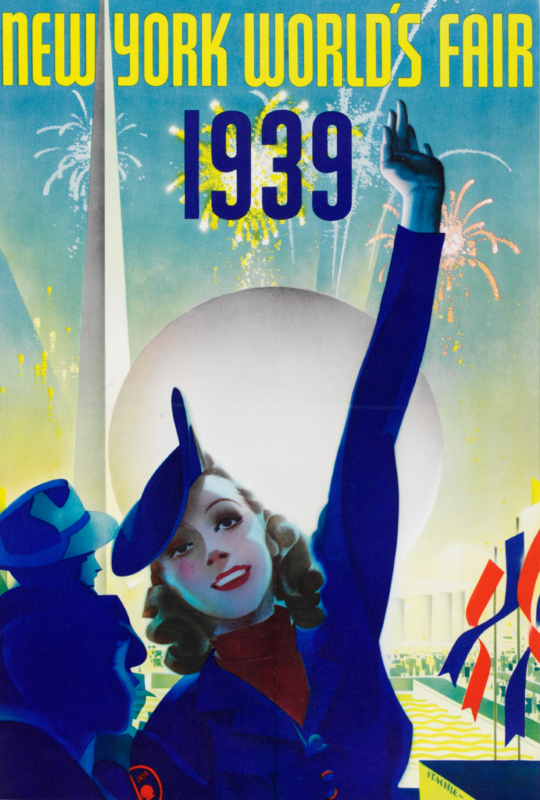
This Anniversary Celebration of the two notable World’s Fairs staged in New York City during the Springs and Summers of 1939-40 and 1964-65, intends to preserve the essential spirit of these events, the varieties of Cultural Expression, the marvels of Cutting-Edge Technology, the Fun, the Food, the Rides and all the rest. Taking place in 2019 and 2020, its focus will be on a bottom-up, modern, and fully interactive interpretation of this classic exposition, while adding the novel notion of simultaneous mini-events, taking place at many diverse locations around the country and the world at the same time, instead of just in one place.
As a prime focus, artists, craftspeople, designers, mechanics, and engineers are being encouraged to begin immediately to fabricate the next generation’s human-scale transportation system, the weather-protected bikes, and wheelchairs that will fill our urban spaces. We will work to motivate individuals and small groups to begin this work, where they are and right away. In the Spring of 2019, we will invite them to bring their creations to the World’s Fairgrounds in Queens New York, to show them off and exchange ideas with other participants. Meanwhile, they will have been working for a year to expose these ideas to their own communities while also exhibiting them on our website. We will also be reaching out to individuals and institutions here to provide hospitality to visiting builders and transportation companies, to help get their vehicles here for the show.
Another theme prominently featured will be Agriculture and Nutrition, with opportunities developed for city-dwellers to experience growing environments directly, by facilitating inexpensive travel to rural environments while also providing ethnically-rich and nutritious foodstuffs to all. The ultimate goal here is to habituate people to eating more consciously and healthfully, while also more greatly appreciating the range of tastes and preferences enjoyed by those with different backgrounds and influences. The third major subject category is the ways in which neighborhoods can become friendlier and more supportive of their own resources, both human and natural. We want to help answer the question: How can members of communities organize and express themselves more fully, in order to take more responsibility for their surroundings and have a greater influence over them?
The last major area of interest here is in Cultural Expression and the diversity which characterizes our planet as expressed through music, dance, poetry, and other distinctive ways of interpreting our lives. As well as seeking out opportunities for these expressions to take place during the event, in keeping with the traditions which have characterized events such as this historically, we intend to invite demonstrations of the role that technology does and can play, in helping us to enjoy these creative performances.
The ordinary definition of a World’s Fair is a collection of exhibits, put together by large corporations, industries, and Governments, to impress the public with their grasp of the future and value to us in the present. Visitors are expected to congregate where huge, expensive but temporary pavilions have been constructed, to house elaborate exhibits. Spectators are expected to be dazzled and impressed with the importance of these enterprises and their products and take home souvenirs that will someday earn them a fortune on eBay. Despite the typical grand scale and the sense of remoteness that it sometimes invokes, the fact is that most attendees enjoy these spectacles enormously and never forget the impression that they made on them. Of course, now that TV (first demonstrated in NYC at the 1939 Fair) has rendered the most exotic the most commonplace, we need a re-working of this experience and a more interactive approach.
Communications and information are two fields that have developed extraordinarily in recent times, much of it through miniaturization and already have changed the way we live dramatically. Transportation, the next field to be revolutionized, and miniaturized, is a subject that has been overly influenced by the self-centered agendas of those in a position to benefit from maintaining the status quo. A car today is, in an urban environment, as absurd as a twenty-pound cellphone. The President of the United States says our “Economy is built on innovation”. Around the world, many of the tasks we perform are done with archaic tools, oversized cars, and trucks prominently among them. Intensive research into available alternatives is crucial. By creating conditions that permit us to more easily learn from one another, we are better able to use the benefits that are generated by this activity, while continuing to fuel our researches and making it easier to adapt our thinking and behavior to best utilize our new knowledge.
The Chinese Politburo many years ago decided to favor funding road-building and car manufacturing over mass transit and more recently had even begun to ban bikes and electric bikes from some roads, until popular discontent forced them to reverse their stands. The wisdom of giving more attention to the needs of the majority of the population is clear but the means to accomplish this is less so. What is obvious to nearly all is the need to begin to conserve resources. The danger of simply following the example of the United States and the Western industrialized world, which defines progress as growth, is manifest, and traffic jams now plague every continent. Substituting quantity for quality in determining the nature of our economic success is causing enormous problems. In a world where hunger is still a serious problem, converting food into fuel for cars is only the most obvious example of our folly, but not the only one.
We must figure out how to provide ourselves with the level of creature comfort that we are now accustomed to in our transportation system, without the enormous economic and environmental costs that this now entails. The most direct path to this end is human-scale and human-powered vehicles, with electric assistance. They can provide the means for this conversion to take place, from industrial-scale vehicles, especially petroleum-powered, which are inherently both dangerous as well as unsuitable for crowded urban environments. If the internal combustion engine had just been invented there is no way that we would have allowed it on our streets. Poison gas in any quantity is forbidden in indoor spaces, but so common that it is virtually invisible in our shared spaces.
This insult to our health and well-being is only tolerable because it has been with us for so long. Those who benefit from its inherent hazards and inefficiencies spend enormous amounts of money to convince us otherwise. The real problem is the lack of suitable alternatives. There is not even wheelchairs (which could be another name for cars) or bikes, an essentially 19th-century design, with umbrellas. Upgrading the least expensive modes of travel sufficiently to replace the outmoded ones we currently use will have an enormous influence on our surroundings. Multi-ton vehicles traveling at common speeds have an immense negative impact on our sense of peace and tranquility. While we now associate all of this hyperactivity with the energy of the urban experience, the noise alone is often so intrusive that you can not even carry on a normal conversation.
It makes good sense to use the 1255 car-free acres of Flushing Meadows Corona Park, the World’s Fairgrounds, to bring together a host of creative, ingenious and caring people, to take on this important challenge and demonstrate how it can be dealt with, to a vast local and global audience.
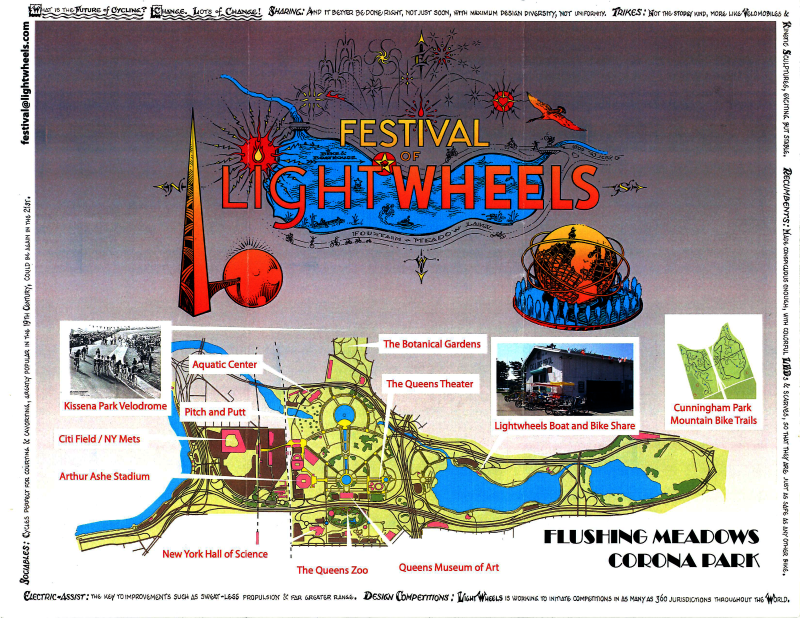
It is taking stock of our ability to create objects and activities, that can improve the quality of our lives, and help us to be fully aware of the times we are in and, most importantly, what is coming.
It helps to put needed attention on important issues, while also using art and creative expressions as key factors.
It highlights the many unique places in the world and the cultures that exist there, which can expand tolerance and appreciation of differences.
This proposal endeavors to retain the innovative and welcoming spirit of these historical events, but it is also structured in some ways that are the very opposite of the classical model:
It is taking place everywhere in the world, in every country at the same time.
A variety of regional gatherings will supplant the usual single location.
It is taking place starting now and continuously, with no arbitrary time limit.
It cost nothing to exhibit or to share in the activity taking place.
In order to initiate this program it will require :
A means to reach out, as widely and quickly as possible, to all potential participants.
A program to solicit money and in-kind contributions, to be given directly to builders.
A non-profit established, to help local groups to gain economic and political support.
A website, www.AMovement.org to provide the means for programs to communicate.
An artist, who can illustrate the shape and goals of this effort with effective images.
A group of supporters, willing to be helpful in gaining visibility for this undertaking.
Funds, are sufficient to reward, appropriately, those providing professional services.
Advanced Design Bikes and Wheelchairs to share and on exhibit, and innovative visions of our human-powered future
Featured, along with more evolved human-scale transportation, will be improved nutritional options, creative uses of public space, healthier recreational activities, and fuller appreciation of the natural world
Flushing Meadows Corona Park, Queens, N.Y. and 1255 acres of car-free public space, N.Y’s World’s Fairgrounds, & in localities around the country & the world.
From 2022 and 2025, to coincide with the 60th anniversaries of the 1964-65 New York’s World’s Fair.
Though Queens is already home to the broadest assemblage of peoples, speaking more different languages than anywhere in the world, it is the intention of the organizers to involve local communities everywhere, from 191 other countries, 49 other States, 61 other counties, and 59 NYC Community Boards, 360 venues, all, in effect, represented by their local residents’ entries. Through the Internet and a focus on sustaining localized activities, we will endeavor participation to be maximized everywhere and thereby enable everyone who desires, whether here or in their own community, to be involved.
We are in the process of gathering another group of individuals who would like to declare their support for this program. The list below was assembled when we were still the operators of the Bike and Boat rental concession in Flushing Meadows Corona Park in New York City, during our first attempt to bring this all together previously. Unfortunately, electric-assisted human-powered vehicles were still in legal limbo at that time, and doing this would not have been possible. The current version of this event does not require that the location of previous World’s Fairs any longer be central to this effort. (In fact, New York City is currently discouraging electric bikes, even though they can not be distinguished from ordinary bikes) and trikes, from using the park. It is expected that this situation will change soon but it doesn’t matter, since work will be going on in small groups, using permitted space, to build their vehicles, everywhere in the world. All public streets and other public spaces are always available to exhibit and share in the enjoyment of these new means of getting around.
Kent Barwick, Former Director of Municipal Art Society and NYS Council on the Arts
David Gurin, Former Commissioner of Transportation, Toronto Canada
Carlos Pujol, CEO Cemusa, NYC Street Furniture Contractor
Garrett Brown, Inventor of the Steadycam and Skycam
James Weisman, Legal Director of United Spinal Association
Sherry Huss, Director of The Maker Faire
Jay Townley, Consultant at American Bicycle Industry
Wendy Brawer, Founder of The Green Map Project
Dr. Alan Moore, Art Historian/Exhibit Organizer
John Dowlin, Publisher Bicycle Network News
Like Fairs of the past, the emphasis here will be on creativity, expression, tolerance, education, technology, and enjoyment. Unlike the usual format, there will be no large and expensive pavilions meant to be dismantled after the event. Instead of limiting participation to large-scale organizations, it is the intent of the organizers to put the focus here on the accomplishments of individuals and small groups of people by demonstrating our ability to have a positive effect on our common existences, to contribute to healthier and more active lives and to reduce the harm we may, even unintentionally, cause each other.
Financing is always an issue and first of all, as befits an anniversary celebration, we will invite all of the former exhibitors to be a part of this event. We will ask them to provide as many small grants as they can, to various deserving local efforts, to commemorate their previous involvement. We are also inviting any other business or government unit to do the same thing, to provide small amounts of money to individuals and small groups within their communities to help them develop a project which can be part of this event. The Organizing Committee, charged with turning this idea into a reality, will be comprised primarily of volunteers and will largely use their own resources and contributed facilities to guarantee the success of this effort. We can further encourage these developments by expediting access to travel, hospitality and other needed support to visit designers and builders, by soliciting help, especially from those who hail from their home towns, to help enable the broadest involvement possible.
While experienced professionals in various areas will be needed to help guide this undertaking, it is our intention that, through the broad participation of students and non-profit organizations we can keep costs to a minimum. A detailed working plan and timeline will be developed soon and distributed to all those aiding in this effort.
As the place where the Flushing Remonstrance occurred, one of America’s earliest attempts to establish universal respect for the differences in belief that exist, and the first home of the United Nations, there is no location more suitable to build upon these efforts to venerate our humanity. As in previous Fairs, appreciation of others from different backgrounds, having a good time, experiencing evolving technologies, and exposure to varied forms of expression are central to the event.
What will be different about this version of a World’s Fair will be a vigorous effort to encourage direct involvement in these issues, to maximize participation by individuals rather than institutions, and an emphasis on heightening appreciation of the potential for people of any age or background to make significant contributions to our common evolution, to engage their own creative energies in the service of others. Applying ourselves to issues like nutrition and the use of natural resources that concern all of us will enable participants from everywhere to relate to these important questions and their resolution.
One subject that concerns us all is the production and provision of healthy and nutritious food. This also involves the growth and gathering of foodstuffs as well as improved guidance in the preparation and consumption of life-preserving and life-enhancing nutrition. Being exposed to comestibles from everywhere in the world gives us the opportunity to improve and change our habits, to appreciate the lessons learned from different cultures over time regarding the best ways of appreciating our natural environment and its products, expanding our tastes, and improving our choices. We will encourage suppliers to focus on healthier, more economical, and therefore preferential foodstuffs. Keeping in mind the effect of these choices on the health of our planet is another important dimension. How we use our land is a factor in how the future looks and must not be ignored.
While a number of subjects will receive significant attention here, we recognize that important technological advances have made real breakthroughs in lightweight transportation possible today and the economic and environmental burdens of the current system are considerable. This high-profile, prestigious showcase can serve to motivate designers, builders, and allied enterprises from everywhere to bring new ideas forward, and into the real world quickly. Developing variations on the common bicycle, to help bridge the gap between minimal and maximal transport, is long overdue. We know that bicycles, wheelchairs, artisanship, and stress on shared resources are common features in the lives of people from every corner of the world.
Using our combined ingenuity, creativity, and experience, we can reshape how we get ourselves, and our goods, around, how we deploy our shared resources, and how we help influence others to understand their best choices. If we do this in the process of enjoying pleasurable experiences, there is hardly a better way to illustrate this potential and its desirability. While the public is accustomed to regarding “educational” activity as possibly boring or tedious, here the opposite is the case.
For instance, these machines, whether previously called wheelchairs or recumbent trikes, can be used by everyone, if made well enough, not just a special population. Making available colorful, easily-usable, creative vehicles, new varieties of electric-assisted and human-powered transportation, regardless of former definition or category, can completely remove the existing onus of using a wheelchair. The best-designed vehicles can enjoyably be used by the young, the old and everybody in-between. These machines might well end up resembling each other more than they look like their current versions. We can vault over ancient and worn-out categories into new and more relevant distinctions. Is it weather–protected? Is it beautiful? Can you carry your friends on it? Is it different than anything you have ever seen? Do you wish you had made it? Can you use it when you want to and leave it conveniently for somebody else to enjoy when you are finished?
Encouraging innovation and accelerating the healing process of the planet is now job number one. There can be an infinite number of worthy projects cataloged, described, shown in action. This resource will begin by culling the best examples from existing databases.
We will encourage new ideas, even if only in the form of a drawing, a model, or something that only the designer/builder rides, which can be practically anything and may be used by other designer/builders only, in a kind of exchange. If the public is going to be allowed to use it within a confined space and protected environment, a more strict set of standards will have to be used. If it can be ridden away, to use in the rest of the park, the most stringent requirements will exist. We will employ a peer-review process, so that selection of participating vehicles is as fair and high quality as possible and so that all parties to this activity can have what amounts to a continuing ongoing forum so they can contribute their ideas and concerns, and participate in the process of addressing them.
Everybody needs green spaces, exercise, and safe, non-destructive, and affordable ways to get around.
Providing some shelter, as little as a large “Umbrella” is essential in making our public spaces fully habitable. This endeavor will also encourage the design and construction of unique, beautiful, and interesting structures, to provide weather protection, especially to public transit users. We will also encourage a process that will enable local artists, craftspeople, and others to formulate these structures for their own neighborhoods and for those communities to have a hand in this process.
We are dedicated to improving everyone’s ability to enjoy their shared spaces, especially parks by preserving and enhancing their natural beauty while expanding access to new, healthful, non-intrusive activities. In the words of urban historian Lewis Mumford, the Godfather of the 1939 New York World’s Fair, “Year by year our cities grow more complex and less fit for living. The Age of Rebuilding is here. We must remold our old cities and build new communities better suited to our needs”.
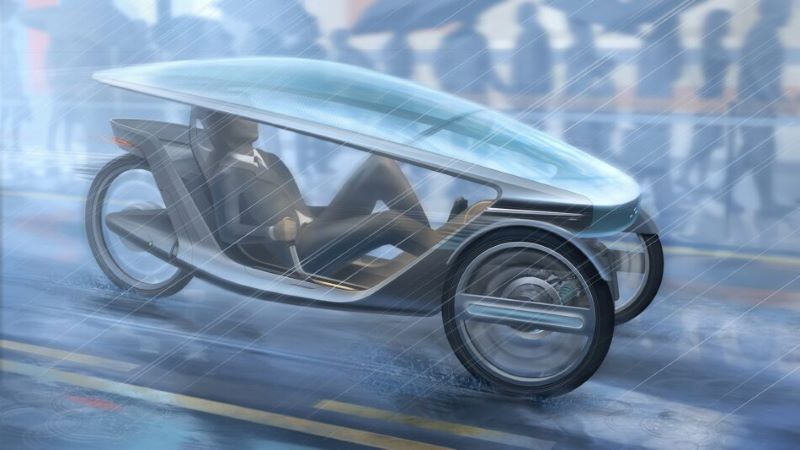
Find a pad of paper and a pencil or pen and look in the library for helpful information.
Begin to imagine what a different kind of vehicle might look like and how it might work.
Call a friend or two so that this can begin to be a cooperative group project
Make a poster with an email describing this project and what you hope to accomplish.
Find some unused space to work or put the request for one on the information poster.
Contact local hardware, and second-hand stores, to ask them to contribute needed materials.
Offer all local businesses the opportunity to sponsor and provide resources for the group.
Collect a basic hand and power tool kit and selection of nuts and bolts, tape, epoxy, etc.
Offer other locals, with an interest in this process, the opportunity to become involved.
See if there are engineers, mechanics, artists, craftspeople, or anyone willing to pitch in.
Let the local media know what you are doing so they can publicize and help you.
Post your progress on AMovement.org so you can invite comments and help.
Follow the advances that other groups are making and continue to learn from them.
Bring local officials into the picture and encourage them to pursue your ideas seriously.
Learn the history of transportation in this country and how it has been manipulated.
Give everybody rides in your vehicle and begin re-evaluating and re-designing it.
Use the experience of the following something from idea to reality to solve other problems.
Establish the value of believing in yourself and learning to be as creative as possible.
Persuade all local educational establishments to consider beginning their own project.
Work to use the results of these efforts to bring forth actual enterprises and products.
Ride around and show off what you have done in order to inspire more similar efforts.
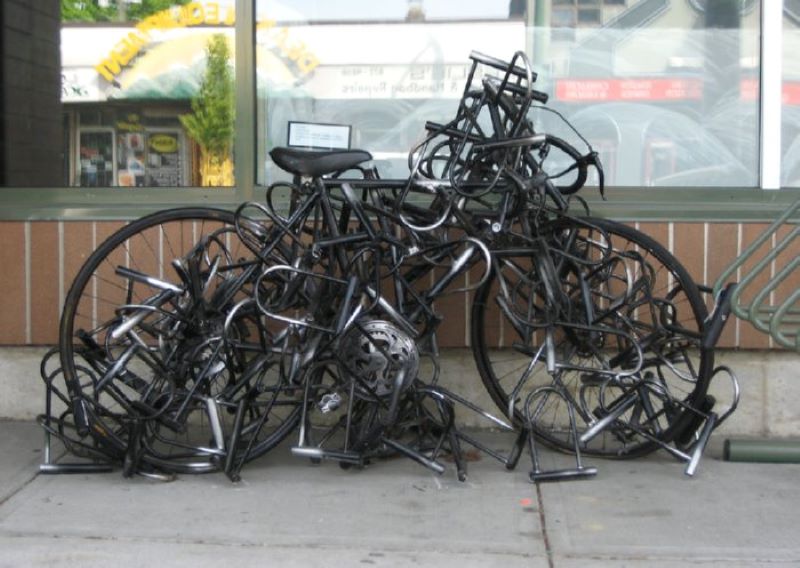
I was the operator of the Boat and Bike rental concession in Flushing Meadows Park, the site of the 1939 and 1964 World’s Fairs. I proposed then that an anniversary celebration of these events be held, but with a different architecture. Instead of large, expensive, and temporary pavilions, sponsored by the biggest corporations, USA States, and foreign governments, the usual top-down affair, it was proposed that this event be a bottom-up, multi-year celebration, centered on creative designs of human-powered and electric-assisted vehicles. Further, it was proposed that these efforts, by individuals or small groups, be supported, in part, by cooperating foundations, companies, cities, and educational institutions, and take place in New York City, as well as in other locations around the world, on an ongoing basis.
Back then, the proposal for these exhibitions and demonstrations was intended to serve to raise the awareness of the potential of these technologies to provide us with their considerable environmental and economic benefits, while developing more interest and involvement in their possibility to contribute to more healthful and needed advances in our ordinary habits. Now, a decade later, after the crucial evolution of battery and motor technology, we are witnessing rapid progress in this realm and every day brings new products and ideas forward. The utility and pleasure provided by these machines have now been established everywhere.
While these developments are certainly welcome, there is still an important opportunity to open this process fully, to engage artists, designers, engineers and mechanics, and others, to contribute to this evolution. Providing a place, like car-free Flushing Meadows Park, to provide one of the central venues for the public to experience these advances, to ride and share these devices and exhibit the results of their creative efforts, will further accelerate their development and wide use.
It is not necessary for any organization to control this activity or directly manage it. Rather, it can be publicized and popularized and become one of the ways for this important technology to become a part of our lives more rapidly and provide for a far wider range of design options. Weather protection, multi-person devices, easier access, and improved safety are some of the areas in which we need to pay more attention. Bicycling is ordinarily a solitary activity and is usually limited to use in fair weather, thus preventing its fullest benefit. The introduction of helper motors has already considerably expanded the number of users, but the most stable, comfortable, and utilitarian models are still rarely available. The ability to use vehicles in all kinds of weather conditions, hot, cold, rainy, etc. limits their ability to replace the multi-ton vehicles that monopolize our open spaces. Multi-passenger “Sociables” that were once popular, is rarely in evidence. All this can change as our ambition to fulfill the potential of these machines is explored and realized.
Recent events, in the form of fires and floods and pandemics, may have been interpreted, by some, as a kind-of Biblical message. For others, this is an urgent call for action, to explore the most dramatic changes in our consumption patterns, of fossil fuels especially, as soon as possible. There are a few changes that will be more effective in countering this challenge to our survival. Creativity is sometimes just a path to pleasure but it can also be a kind of medicine, the most effective response to a dangerous threat. It is time for us to take this remedy to heart, to use the transformation of our public spaces as a conspicuous demonstration of our ability to confront our common challenges and resolve our most serious crises, joyfully and effectively.
A Plan
Goals
Environmental
Accelerating needed changes
Introducing new concepts
Widening public awareness
Economic
New companies forming
Money saved
Lessening waste
Lowering costs
Aesthetic
Beauty, not just utility
Uniqueness vs. manufacturing
Participants
Designer/Builders
Existing
At schools
Artists/Sculptors
Concepts as well as actualities
Work that excites interest
Organizations
NGOs
Health
Environmental
Justice
Transport
International
Professional
Engineers
Designers
Art
Community
Queens Museum
Hall of Science
Improvement groups
International
Foreign Governments
Transportation ministers
Environmental agencies
Health departments
Previous exhibitors
Businesses
Organizations
Comity
Environmental
Politicians
NYC
Jessica Ramos
Eric Adams
NYS
Heads of relevant committees
Agencies
NYSERDA
Sponsors
Foundations
Personal
Sierra Club
NRDC
Foreign Governments
Transportation ministers
Environmental agencies
Health departments
Previous exhibitors
Industry
Corporations
Former participants
Government Agencies
NRDC
Commerce
DOT
Businesses
Local
Industry-based
Bike-related
Individuals
Stollman
???????
Schools
Universities
Community Colleges
High Schools
Trade Schools
Strategy
Local buy-in first
Massive email
Request for lists
Public records
Press
Social media
Print and broadcast
Pre-events and exhibits
Budget
Minimal $5000 seed money
Primarily volunteers
Outreach through Social Media
Legal setup established
Totally transparent
GoFundMe or other
Structure
Democratic, majority-ruled
Members are invited
Temporary initially
Activity aided not managed
Supporters
Financial
Signatories
Co-sponsors
Staff
Organizer
Media person
Graphic artist
Treasurer

legal to operate pedal-activated, electric-assisted cycles in New York City. Fortunately, fully-evolved versions of these machines, multi-passenger, weatherized, beautiful and accessible, will eventually fill our streets. Meanwhile, vehicle designers, from around the country and the planet, are therefore invited to visit here, over the next few years, to bring their creative versions of these devices, including wheelchairs, here, to show-off and use.
The primary venue for this undertaking is Flushing Meadows Park, in Queens New York, now celebrating the Anniversaries of the historic 1939 and 1964 World’s Fairs that took place there. Its wide paths and many open spaces are perfect places to demonstrate the next generation of healthful, safe, appropriate, maybe even beautiful, urban vehicles. Giving the public the opportunity to experience this multitude of options is of great benefit to both the creators of these new, up-to-date conveyances and their eventual users.
This program will also seek to initiate efforts in other places with similar goals. Traveling to NYC will be impossible for many, so helping to generate local support for projects from both public, private and non-profit sources, needs to be done as well.
This “event” is more like the sun rising, a natural occurrence, an inevitability. We have finally, as a species, realized that we must use the resources that we have more consciously and responsibly, especially as regards transportation. As a result, bike-sharing and electric vehicles, for instance, are becoming standard and welcome features of cities everywhere.
At the same time, there is the realization that we must begin to seriously upgrade the quality and utility of these devices, enable them to provide better weather protection and creature comforts, make them beautiful and inspiring instead of merely utilitarian. There are ingenious people everywhere, artists, mechanics, designers, who can contribute to the expansion of the varieties of vehicles available and their improvement, and should.
Showing these devices off, and letting others use them, as part of a grand showcase, in order to generate more colorful and beneficial activity in this realm, is one goal here. Contributing substantially to resolving one of our most vexing environmental catastrophes is another. Appreciating one another’s creativity while having a good time is another.
There is an urgent need within our cities to develop personal transportation that bridges the gap, between the bare minimum, the bicycle, and scooter, and the oversized, multi-ton automobile. These new, safe, light, comfortable, and easily used devices, must retain a muscle-powered option. This is essential, in order to encourage the widest possible enjoyment of the substantial economic, environmental, and health benefits that we can provide for ourselves.
Because these vehicles operate on a human scale, this creative work can be done by a wide range of designers, mechanics, artists, sculptors, and makers. Materials can include fabric and wood along with the usual metal and plastic. Motors and other parts can be recycled from discarded or re-purposed items. Taking part in this process is open to anyone with the desire to participate. As a “World’s Fair”, taking place in a neighborhood with the most diverse population on earth, along with numerous local projects taking place at the same time, the broadest possible involvement is possible.
1939/1964 New York World’s Fair Anniversary Celebration 2022-2025
will perform only two tasks: we will let as many people know about this program as possible and expedite communications in general: we will also endeavor to motivate individuals and businesses, where ever they are, to lend support to their own local efforts, even to begin one. This will help in bringing attention to these projects and generating resources. Scheduling local get-togethers and exhibits and establishing cooperative efforts do not require anybody’s permission. It is not necessary to voyage to NYC to take part here either, although it would be welcome. There are no contest, or prizes, at least yet. Being part of this is winning. Expressing yourself, by making it easier to get around, while enabling more life energy to flow through our limbs and senses, is the goal.
Avanti!
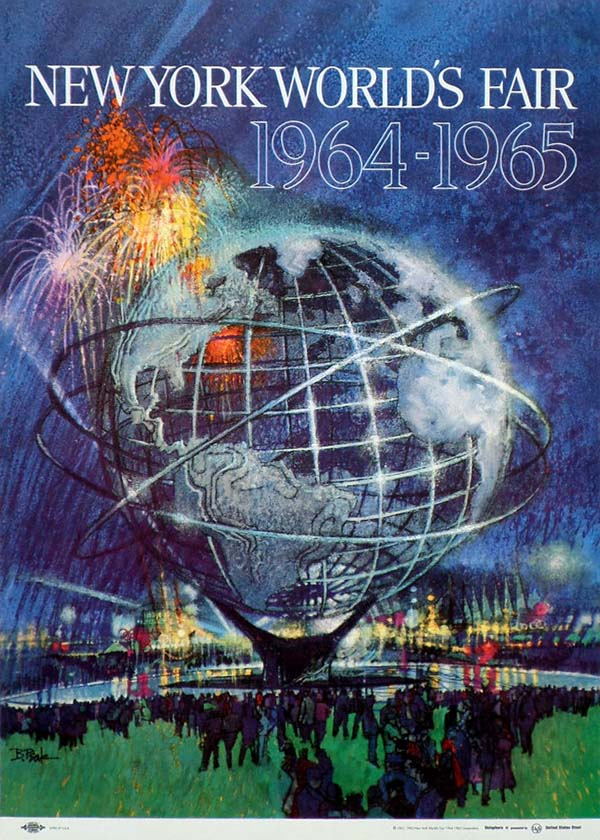
will be the first World’s Fair to take place all over the world at the same time. Participation is gained by scheduling a regular and convenient time and place, for yourself and your neighbors to exhibit and work, on local, muscle-powered-vehicle building projects. We need to accelerate the design and development of human-scale and human-powered and electric-assisted transportation for work, travel, pleasure, and exercise.
We can celebrate these Fairs’ high-tech surprises, International favor, and good fun, with few rules to limit originality, (only pedal-activated vehicles please) while enabling crowd-sourcing and cooperation to help us solve serious problems. We need cycles and wheelchairs that are safer, healthier, more affordable, more beautiful and unique, and easier to access, share and use. We need many creative people to initiate these efforts.
Individuals and small groups are being encouraged to begin projects to re-define these modes of transport and bring them from their current 19th-century configurations into the 21st Century, with weatherization and motorization, etc. Submissions will be sorted by type, cargo, passenger, multimodal, amphibious, etc., and also by geography, and will be freely viewable on nyworldsfair.org. Artists, engineers, mechanics, and designers are all being invited to take part in the creation of much better, and greener, transport options, for everyone and from everywhere.
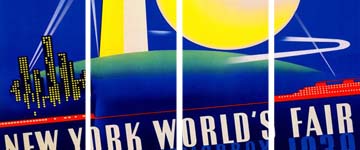
There is an admission Charge. There is a fence around the perimeter. There are large, temporary, expensive pavilions. Participants are large corporations and governments. Visitors are mostly passive observers and consumers. The intention of exhibitors is to dazzle and impress. This takes place for some months over one or two years heavy initial expenses make economic viability rare. The residual benefits of momentary events are few. There will be long waits to enter complex busy exhibits. It will take several years of planning to participate. Surrounding communities barely participate or benefit. There is no control over the healthfulness of food etc. The “World” has to come to you from somewhere else. There is no meaningful interaction among exhibitors. The emphasis is on the proprietary and the profitable. The Industrial Scale World is what matters most here. We are taught that seriousness is the opposite of fun Everybody has to come to this place to participate.
It is in a public park and admission is free. There are pesky highways but no walls. There are mobile traveling exhibits on wheels. They may sponsor individuals and small groups. There are continuous opportunities to interact with. Presenters aim to motivate others to join them. This activity becomes a part of this park and others. This low-cost approach guarantees solvency. This is the start of new transport infrastructure. Numerous small-scale opportunities will proliferate. Exhibitors can decide at any time to be involved. All surrounding neighborhoods are a part of this. Here is proof that good tasting can be good for you. People from everywhere are already in Queens. Open Forums on Human Powered Vehicle design. The public’s interest in its own public space is key. The Human Scale dimension is the one we live in. Yet Human-Powered Transportation is a lot of both. This happens here and there and online and off.

and there is no small army of mostly young, creative, ingenious, and entrepreneurial people, everywhere, who are ready, now, to contribute their best efforts towards re-designing our urban transportation systems, in order to improve our ability to survive the current climate crisis, and have a really good time while they’re doing it.
Maybe it is impossible to use tiny human-powered vehicles, with solar/electric assistance, to replace archaic multi-ton, gas-powered behemoths.
Maybe we can not construct these new conveyances so they offer full protection against bad weather when needed, safely and comfortably, but are otherwise open to the air.
Maybe it is not possible to enable riders to stand, lean, sit or recline, as they wish, instead of always being forced to sit, like children in school or when being served a meal.
Maybe personal vehicles can transform into person/cargo-carrying ones, so we can travel alone, or with others, as we please.
Maybe we can make certain that everybody, regardless of their abilities or economy, has equal access to local mobility.
Maybe bikes are simply too small and cars are way too big, and we need a Goldilocks moment, when we realize, suddenly, that the “Just Right” is, obviously, what is missing.
Maybe what we still need, is far greater than what we already have. Put another way, in spatial terms, the hole may be much bigger than the donut.
at the same time. Participation is gained by scheduling a regular and convenient time and place, for yourself and your neighbors to exhibit and work, on local, muscle-powered-vehicle building projects. We need to accelerate the design and development of human-scale and human-powered and electric-assisted transportation for work, travel, pleasure, and exercise.
We can celebrate these Fairs’ high-tech surprises, International favor, and good fun, with few rules to limit originality, (only pedal-activated vehicles please), while enabling crowd-sourcing and cooperation to help us solve serious problems. We need cycles and wheelchairs that are safer, healthier, more affordable, more beautiful and unique, and easier to access, share and use. We need many creative people to initiate these efforts.
Individuals and small groups are being encouraged to begin projects to redefine these modes of transport and bring them from their current 19th-century configurations into the 21st Century, with weatherization and motorization, etc. Submissions will be sorted by type, cargo, passenger, multimodal, amphibious, etc., and also by geography, and will be freely viewable on SharingUmbrellas.org Artists, engineers, mechanics, and designers are all being invited to take part in the creation of much better, and greener, transport options, for everyone and from everywhere.
The end of the Anniversary Celebrations for the 1939 and 1964 World’s Fairs will be on October 16th and 27th 2019. We will use the 11 days between those dates, to commemorate the legacy of these historic events, through exhibits and demonstrations of the futuristic human-powered vehicles being designed and built over the next two years. We will congregate during those days in Flushing Meadows/Corona Park in New York City, the site of the original Fair, and in all the other places around the world being used for these regular gatherings over this time, to be amazed, learn from one another, take some rides and have some serious fun.
SHARED:
SPACES AND FACILITIES
Communication/Information/Transportation/Shelter Parkland/Sidewalks/Streets/Neighborhoods
VEHICLES AND RIDES
Transport/Utility/Human-scale/”Wheelchairs” Muscle-powered/Electric-assisted/Urban-friendly
A campaign, over two years, from this Summer until late 2019, to encourage individuals and small groups to work on designing and building the next generations of human-scale urban transport vehicles and neighborhood-originated and operated, Transportation/Information/Communications Stations.
Although we are celebrating the 80th and 55th Anniversaries of the 1939 and 1964 World’s Fairs, instead of occurring only in NYC, this effort will take place at the same time in myriad locations. Wherever there is the interest, the tools and skills needed and a place to work, a group may form and identify itself.
Current wheelchairs and bikes do not provide weather protection, places for passengers or gear, the whole array of creature comforts, and other features that would permit them to be used by everyone at all times and ultimately replace, multi-ton, industrial-scale, urban-unfriendly vehicles.
Unique all-purpose shelters can be made by local artists and craftspeople, to provide protection against bad weather at bus stops and elsewhere, to give neighborhoods natural gathering spots and bulletin boards, ways to encourage help availability, organize healthy exercise, and enable resource-sharing and rides.
Local businesses, environmental, arts and education organizations, and former world’s Fair exhibitors will be asked to offer support to local groups working on these projects, to give them seed money, or in-kind contributions of materials and services, to publicize and help transport their final products to NYC.
We will expedite hospitality for participants, to find Queens residents willing to open up their homes to makers from their original home cities. This place, with the most diverse population on earth, is ideal to celebrate the universality of ingenuity and curiosity and our problem-solving abilities.
Celebrating the Anniversaries of the 1939 and 1964 New York World’s Fairs
This Anniversary Celebration of the two notable World’s Fairs staged in New York City during the Springs and Summers of 1939-40 and 1964-65, intends to preserve the essential spirit of these events, the varieties of Cultural Expression, the marvels of Cutting-Edge Technology, the Fun, the Food, the Rides and all the rest. Taking place in 2019 and 2020, its focus will be on a bottom-up, modern, and fully interactive interpretation of this classic exposition, while adding the novel notion of simultaneous mini-events, taking place at many diverse locations around the country and the world at the same time, instead of just in one place.
As a prime focus, artists, craftspeople, designers, mechanics, and engineers are being encouraged to begin immediately to fabricate the next generation’s human-scale transportation system, the weather-protected bikes, and wheelchairs that will fill our urban spaces. We will work to motivate individuals and small groups to begin this work, where they are and right away. In the Spring of 2019, we will invite them to bring their creations to the World’s Fairgrounds in Queens New York, to show them off and exchange ideas with other participants. Meanwhile, they will have been working for a year to expose these ideas to their own communities while also exhibiting them on our website SharingUmbrellas.org. We will also be reaching out to individuals and institutions here to provide hospitality to visiting builders and transportation companies, to help get their vehicles here for the show.
Another theme prominently featured will be Agriculture and Nutrition, with opportunities developed for city-dwellers to experience growing environments directly, by facilitating inexpensive travel to rural environments while also providing ethnically-rich and nutritious foodstuffs to all. The ultimate goal here is to habituate people to eating more consciously and healthfully, while also more greatly appreciating the range of tastes and preferences enjoyed by those with different backgrounds and influences. The third major subject category is the ways in which neighborhoods can become friendlier and more supportive of their own resources, both human and natural. We want to help answer the question: How can members of communities organize and express themselves more fully, in order to take more responsibility for their surroundings and have a greater influence over them?
The last major area of interest here is in Cultural Expression and the diversity which characterizes our planet as expressed through music, dance, poetry, and other distinctive ways of interpreting our lives. As well as seeking out opportunities for these expressions to take place during the event, in keeping with the traditions which have characterized events such as this historically, we intend to invite demonstrations of the role that technology does and can play, in helping us to enjoy these creative performances.
The ordinary definition of a World’s Fair is a collection of exhibits, put together by large corporations, industries, and Governments, to impress the public with their grasp of the future and value to us in the present. Visitors are expected to congregate were huge, expensive but temporary pavilions have been constructed, to house elaborate exhibits. Spectators are expected to be dazzled and impressed with the importance of these enterprises and their products and take home souvenirs that will someday earn them a fortune on eBay. Despite the typical grand scale and the sense of remoteness that it sometimes invokes, the fact is that most attendees enjoy these spectacles enormously and never forget the impression that they made on them. Of course, now that TV (first demonstrated in NYC at the 1939 Fair) has rendered the most exotic the most commonplace, we need a re-working of this experience and a more interactive approach.
Communications and information are two fields that have developed extraordinarily in recent times, much of it through miniaturization, and already has changed the way we live dramatically. Transportation, the next field to be revolutionized, and miniaturized, is a subject that has been overly influenced by the self-centered agendas of those in a position to benefit from maintaining the status quo. A car today is, in an urban environment, as absurd as a twenty-pound cellphone. The President of the United States says our “Economy is built on innovation”. Around the world, many of the tasks we perform are done with archaic tools, oversized cars and trucks prominently among them. Intensive research into available alternatives is crucial. By creating conditions that permit us to more easily learn from one another, we are better able to use the benefits that are generated by this activity, while continuing to fuel our research and making it easier to adapt our thinking and behavior to best utilize our new knowledge.
The Chinese Politburo many years ago decided to favor funding road-building and car manufacturing over mass transit and more recently had even begun to ban bikes and electric bikes from some roads, until popular discontent forced them to reverse their stands. The wisdom of giving more attention to the needs of the majority of the population is clear but the means to accomplish this is less so. What is obvious to nearly all is the need to begin to conserve resources. The danger of simply following the example of the United States and the Western industrialized world, which defines progress as growth, is manifest, and traffic jams now plague every continent. Substituting quantity for quality in determining the nature of our economic success is causing enormous problems. In a world where hunger is still a serious problem, converting food into fuel for cars is only the most obvious example of our folly, but not the only one.
We must figure out how to provide ourselves with the level of creature comfort that we are now accustomed to in our transportation system, without the enormous economic and environmental costs that this now entails. The most direct path to this end is human-scale and human-powered vehicles, with electric assistance. They can provide the means for this conversion to take place, from industrial-scale vehicles, especially petroleum-powered ones, which are inherently both dangerous as well as unsuitable for crowded urban environments. If the internal combustion engine had just been invented there is no way that we would have allowed it on our streets. Poison gas in any quantity is forbidden in indoor spaces, but so common that it is virtually invisible in our shared spaces.
This insult to our health and well-being is only tolerable because it has been with us for so long. Those who benefit from its inherent hazards and inefficiencies spend enormous amounts of money to convince us otherwise. The real problem is the lack of suitable alternatives. There are not even wheelchairs (which could be another name for cars) or bikes, an essentially 19th-century design, with umbrellas. Upgrading the least expensive modes of travel sufficiently to replace the outmoded ones we currently use will have an enormous influence on our surroundings. Multi-ton vehicles traveling at common speeds have an immense negative impact on our sense of peace and tranquility. While we now associate all of this hyper-activity with the energy of the urban experience, the noise alone is often so intrusive that you can not even carry on a normal conversation.
It makes good sense to use the 1255 car-free acres of Flushing Meadows Corona Park, the World’s Fairgrounds, to bring together a host of creative, ingenious, and caring people, to take on this important challenge and demonstrate how it can be dealt with, to a vast local and global audience.
Anniversary Celebration of the 1939-40 and 1964-65 New York World’s Fairs
All Summertime 2019 & 2020
WHAT:
Advanced Design Bikes, Boats, and “Wheelchairs” to share and on exhibit, and innovative visions of our human-powered future
Featured, along with more evolved human-scale transportation, will be improved nutritional options, creative uses of public space, healthier recreational activities, and a fuller appreciation of the natural world
WHERE:
Flushing Meadows Corona Park, Queens, N.Y., and 1255 acres of car-free public space, N.Y’s World’s Fairgrounds, & in localities around the country & the world.
WHEN:
June through September 2019 and 2020, to coincide with the 80th and 55th anniversaries of the 1939-40 and 1964-65 New York’s World’s Fairs.
WHO:
Though Queens is already home to the broadest assemblage of peoples, speaking more different languages than anywhere in the world, it is the intention of the organizers to involve local communities everywhere, from 191 other countries, 49 other States, 61 other counties, and 59 NYC Community Boards, 360 venues, all, in effect, represented by their local residents’ entries. Through the Internet and a focus on sustaining localized activities, we will endeavor participation to be maximized everywhere and thereby enable everyone who desires, whether here or in their own community, to be involved.
2019-20 World’s Fair Anniversary Celebration Exploratory Committee:
Kent Barwick, Former Director of the Municipal Art Society and NYS Council on the Arts
David Gurin, Former Commissioner of Transportation, Toronto Canada
Carlos Pujol, CEO Cemusa, NYC Street Furniture Contractor
Garrett Brown, Inventor of the Steadycam and Skycam
James Weisman, Legal Director of United Spinal Association
Sherry Huss, Director of The Maker Faire
Jay Townley, Consultant at American Bicycle Industry
Wendy Brawer, Founder of The Green Map Project
Dr. Alan Moore, Art Historian/Exhibit Organizer
John Dowlin, Publisher Bicycle Network News
HOW:
Like Fairs of the past, the emphasis here will be on creativity, expression, tolerance, education, technology, and enjoyment. Unlike the usual format, there will be no large and expensive pavilions meant to be dismantled after the event. Instead of limiting participation to large-scale organizations, it is the intent of the organizers to put the focus here on the accomplishments of individuals and small groups of people by demonstrating our ability to have a positive effect on our common existences, to contribute to healthier and more active lives and to reduce the harm we may, even unintentionally, cause each other.
Financing is always an issue and first of all, as befits an anniversary celebration, we will invite all of the former exhibitors to be a part of this event. We will ask them to provide as many small grants as they can, to various deserving local efforts, to commemorate their previous involvement. We are also inviting any other business or government unit to do the same thing, to provide small amounts of money to individuals and small groups within their communities to help them develop a project which can be part of this event. The Organizing Committee, charged with turning this idea into a reality, will be comprised primarily of volunteers and will largely use their own resources and contributed facilities to guarantee the success of this effort. We can further encourage these developments by expediting access to travel, hospitality, and other needed support to visiting designers and builders, and by soliciting help, especially from those who hail from their hometowns, to help enable the broadest involvement possible.
While experienced professionals in various areas will be needed to help guide this undertaking, it is our intention that, through the broad participation of students and non-profit organizations we can keep costs to a minimum. A detailed working plan and timeline will be developed soon and distributed to all those aiding in this effort.
WHY:
As the place where the Flushing Remonstrance occurred, one of America’s earliest attempts to establish universal respect for the differences in belief that exist, and the first home of the United Nations, there is no location more suitable to building upon these efforts to venerate our humanity. As in previous Fairs, appreciation of others from different backgrounds, having a good time, experiencing evolving technologies, and exposure to varied forms of expression are central to the event.
What will be different about this version of a World’s Fair will be a vigorous effort to encourage direct involvement in these issues, to maximize participation by individuals rather than institutions, and an emphasis on heightening appreciation of the potential for people of any age or background to make significant contributions to our common evolution, to engage their own creative energies in the service of others. Applying ourselves to issues like nutrition and the use of natural resources that concern all of us will enable participants from everywhere to relate to these important questions and their resolution.
One subject that concerns us all is the production and provision of healthy and nutritious food. This also involves the growth and gathering of foodstuffs as well as improved guidance in the preparation and consumption of life-preserving and life-enhancing nutrition. Being exposed to comestibles from everywhere in the world gives us the opportunity to improve and change our habits, to appreciate the lessons learned from different cultures over time regarding the best ways of appreciating our natural environment and its products, expanding our tastes and improving our choices. We will encourage suppliers to focus on healthier, more economical, and therefore preferential foodstuffs. Keeping in mind the effect of these choices on the health of our planet is another important dimension. How we use our land is a factor in how the future looks and must not be ignored.
While a number of subjects will receive significant attention here, we recognize that important technological advances have made real breakthroughs in lightweight transportation possible today and the economic and environmental burdens of the current system are considerable. This high-profile, prestigious showcase can serve to motivate designers, builders, and allied enterprises from everywhere to bring new ideas forward, and into the real world quickly. Developing variations on the common bicycle, to help bridge the gap between minimal and maximal transport, is long overdue. We know that bicycles, wheelchairs, artisanship, and stress on shared resources are common features in the lives of people from every corner of the world.
Using our combined ingenuity, creativity, and experience, we can re-shape how we get ourselves, and our goods, around, how we deploy our shared resources, and how we help influence others to understand their best choices. If we do this in the process of enjoying pleasurable experiences, there is hardly a better way to illustrate this potential and its desirability. While the public is accustomed to regarding “educational” activity as possibly boring or tedious, here the opposite is the case.
For instance, these machines, whether previously called “wheelchairs” or “recumbent trikes”, can be used by everyone, if made well enough, not just a special population. Making available colorful, easily-usable, creative vehicles, new varieties of electric-assisted and human-powered transportation, regardless of former definition or category, can completely remove the existing onus of using a “wheelchair”. The best-designed vehicles can enjoyably be used by the young, the old, and everybody are in-between. These machines might well end up resembling each other more than they look like their current versions. We can vault over ancient and worn-out categories into new and more relevant distinctions. Is it weather–protected? Is it beautiful? Can you carry your friends on it? Is it different than anything you have ever seen? Do you wish you had made it? Can you use it when you want to and leave it conveniently for somebody else to enjoy when you are finished?
Encouraging innovation and accelerating the healing process of the planet is now job number one. There can be an infinite number of worthy projects cataloged, described, and shown in action. This resource will begin by culling the best examples from existing databases. To help bring attention to the importance of preserving our aquatic resources, we can include a wide variety of boats, from radio-controlled to wind-propelled, scale models or full-sized, which can look and work beautifully on the quiet waters of what was once known as “Fountain Lake”. Additionally, this lake can be utilized to exhibit artworks, some in the form of boats, others launched for fun or art’s sake.
We will encourage new ideas, even if only in the form of a drawing, a model, or something that only the designer/builder rides, which can be practically anything and may be used by other designers/builders only, in a kind of exchange. If the public is going to be allowed to use it within a confined space and protected environment, another, a more strict set of standards will have to be used. If it can be ridden away, to use in the rest of the park, the most stringent requirements will exist. We will employ a peer-review process, so that selection of participating vehicles is as fair and high quality as possible and so that all parties to this activity can have what amounts to a continuing ongoing forum so they can contribute their ideas and concerns, and participate in the process of addressing them.
Everybody needs green spaces, exercise, and safe, non-destructive, and affordable ways to get around.
Providing some shelter, as little as a large “Umbrella” is essential in making our public spaces fully habitable. This endeavor will also encourage the design and construction of unique, beautiful, and interesting structures, to provide weather protection, especially to public transit users. We will also encourage a process that will enable local artists, craftspeople, and others to formulate these structures for their own neighborhoods and for those communities to have a hand in this process.
We are dedicated to improving everyone’s ability to enjoy their shared spaces, especially parks by preserving and enhancing their natural beauty while expanding access to new, healthful, non-intrusive activities. In the words of urban historian Lewis Mumford, the Godfather of the 1939 New York World’s Fair, “Year by year our cities grow more complex and less fit for living. The Age of Rebuilding is here. We must remold our old cities and build new communities better suited to our needs”.
A World’s Fair Celebration for Everyone
Preserving the Most Important Classic Features of these Historic Occasions:
International, Inclusive, Technology, Education, Fun, Rides, Shows, and Snacks
Differences Between Previous Fairs
There is an admission Charge. There is a fence around the perimeter. There are large, temporary, expensive pavilions. Participants are large corporations and governments. Visitors are mostly passive observers and consumers. The intention of exhibitors is to dazzle and impress. This takes place for some months over one or two years heavy initial expenses make economic viability rare. The residual benefits of momentary events are few. There will be long waits to enter complex busy exhibits. It will take several years of planning to participate. Surrounding communities barely participate or benefit. There is no control over the healthfulness of food etc. The “World” has to come to you from somewhere else. There is no meaningful interaction among exhibitors. The emphasis is on the proprietary and the profitable. The Industrial Scale World is what matters most here. We are taught that seriousness is the opposite of fun Everybody has to come to this place to participate.
This One Planned for 2014
It is in a public park and admission is free. There are pesky highways but no walls. There are mobile traveling exhibits on wheels. They may sponsor individuals and small groups. There are continuous opportunities to interact. Presenters aim to motivate others to join them. This activity becomes a part of this park and others. This low-cost approach guarantees solvency. This is the start of a new transport infrastructure. Numerous small-scale opportunities will proliferate. Exhibitors can decide at any time to be involved. All surrounding neighborhoods are a part of this. Here is proof that good tasting can be good for you. People from everywhere are already in Queens. Open Forums on Human Powered Vehicle design. The public’s interest in its own public space is key. The Human Scale dimension is the one we live in. Yet Human-Powered Transportation is a lot of both. This happens here and there and online and off.

from the Summer of 2022. until late 2025 and beyond, to encourage individuals and small groups to work on designing and building the next generations of human-scale urban transport vehicles and neighborhood originated and operated, Transportation/Information/Communications Stations.
SPACES AND FACILITIES
Communication/Information/Transportation/Shelter Parkland/Sidewalks/Streets/Neighborhoods
VEHICLES AND RIDES
Transport/Utility/Human-scale/Wheelchairs Muscle-powered/Electric-assisted/Urban-friendly
Although we are celebrating the 80th and 55th Anniversaries of the 1939 and 1964 World’s Fairs, instead of occurring only in NYC, this effort will take place at the same time in myriad locations. Wherever there is the interest, the tools and skills needed and a place to work, a group may form and identify itself.
Current wheelchairs and bikes do not provide weather protection, places for passengers or gear, the whole array of creature comforts, and other features that would permit them to be used by everyone at all times and ultimately replace, multi-ton, industrial-scale, urban-unfriendly vehicles.
Unique all-purpose shelters can be made by local artists and craftspeople, to provide protection against bad weather at bus stops and elsewhere, to give neighborhoods natural gathering spots and bulletin boards, ways to encourage help availability, organize healthy exercise, enable resource-sharing and rides.
Local businesses, environmental, arts and education organizations, and former world’s Fair exhibitors will be asked to offer support to local groups working on these projects, to give them seed money, or in-kind contributions of materials and services, to publicize and help transport their final products to NYC.
We will expedite hospitality for participants, to find Queens residents willing to open up their homes to makers from their original home cities. This place, with the most diverse population on earth, is ideal to celebrate the universality of ingenuity and curiosity and our problem-solving abilities.
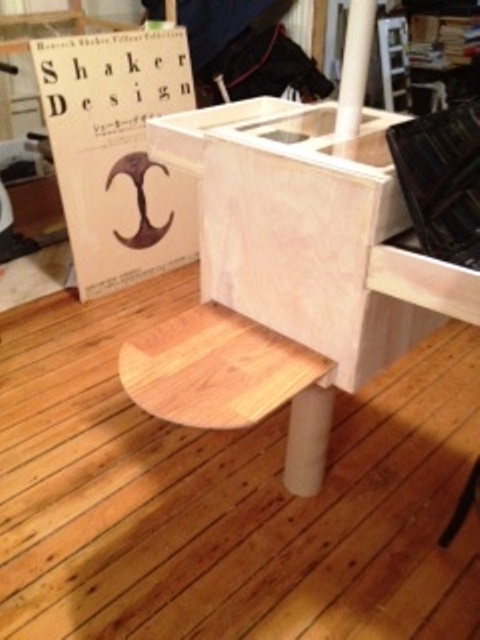
Unique all-purpose shelters can be made by local artists and craftspeople, to provide protection against bad weather at bus stops and elsewhere, to give neighborhoods natural gathering spots and bulletin boards, ways to encourage help availability, organize healthy exercise, enable resource-sharing, rides, etc.
A campaign, over two years, from this Summer until late 2015, to encourage individuals and small groups to work on designing and building the next generations of human-scale urban transport vehicles and neighborhood-originated and operated, Transportation/Information/Communications Stations.
Although we are celebrating the 75th and 50th Anniversaries of the 1939 and 1964 World’s Fairs, instead of occurring only in NYC, this effort will take place at the same time in myriad locations. Wherever there is the interest, the tools and skills needed and a place to work, a group may form and identify itself.
Current wheelchairs and bikes do not provide weather protection, places for passengers or gear, the whole array of creature comforts, and other features that would permit them to be used by everyone at all times and ultimately replace, multi-ton, industrial-scale, urban-unfriendly vehicles.
Unique all-purpose shelters can be made by local artists and craftspeople, to provide protection against bad weather at bus stops and elsewhere, to give neighborhoods natural gathering spots and bulletin boards, ways to encourage help availability, organize healthy exercise, enable resource-sharing, rides, etc.
Local businesses, environmental, arts and education organizations, former world’s Fair exhibitors, etc. will be asked to offer support to local groups working on these projects, to give them seed money, or in-kind contributions of materials and services, to publicize and help transport their final products to NYC
We will expedite hospitality for participants, to find Queens residents willing to open up their homes to makers from their original home cities. This place, with the most diverse population on earth, is ideal to celebrate the universality of ingenuity and curiosity and our problem-solving abilities.
The 11,000 locations of current payphones were chosen primarily due to their potential to market their advertising panels. There are 25,000 more locations no longer active largely due to their relative lack of marketability, though they are already wired and potentially suitable. Meanwhile, since the City’s new criteria focus on their value to our communities, to serve in a variety of important roles, it is clear that they should now be dispersed throughout the city, in every neighborhood, rather than concentrated only at highly commercialized sites. Clearly, there could be many more, placed carefully, to provide a comprehensive system throughout the City.
The variations in terrain, pressure from congestion, and visual character of these diverse places suggests also that the amount of space taken up by these objects, and their relationships to the spaces around them must vary greatly, in order to best serve our neighborhoods. While the core equipment, like current phones, must conform to the existing communications and information technology requirements, the ability to develop these new facilities in such a way as to maximize their benefit to their surroundings and in harmony with them, is not only possible but vitally important as well.
One of the best networks of potential locations for phones is the 9,500 existing bus stops not currently served by shelters. Buses go where the people are and currently these stops are provided with nothing more than a pole and sign and map of the route. While many may be in sparsely-settled, relatively-unsuitable areas, the majority are along streets with substantial populations. There are currently no plans to provide shelters there since the existing franchise is limited to 3,200 fixtures. Since cellphone and solar technology have enabled the construction of a fully-functional facility without the huge expense of trenching for power and connectivity, it is no longer necessary to generate the amount of income from billboards that initially were required to justify this work.
These recent technological advances, along with an infinite number of apps and other internet options, have created the opportunity to offer economical and convenient connectivity everywhere. We are now free to explore the potential to redefine our public spaces in a variety of very meaningful ways. Every plan you are being offered can take advantage of these advances by partnering with the relevant suppliers, who are happy to make their products and services available to anyone who can make use of them. The utilization of this equipment to provide local Wi-Fi, as well as everything currently online is neither expensive nor technically challenging. The ongoing success of City 24/7 here in the form of an easy-to-operate touch-screen is strong evidence that this system is already within easy reach.
While the current payphone design allows for some variations, we are suggesting that, to the degree possible, every one of these installations, aside from their “Equipment Modules” be as unique as possible, rather than highly uniform. This can be accomplished through the design and construction of “Umbrellas” over each location, so calls can be made and work done without having to protect oneself against falling rain or snow. Resting on strong frameworks, which also support the solar cells powering the facility, these creative constructions can be chosen through a myriad of local design contests with strong preference given to those living within the proximity of the object. Colorful, fun, or dignified, made of metal or cloth, these artistic statements can also be a unique reflection of the communities which surround them.
This system can transform our City into the friendliest environment for creative activity in the world by developing the means to use these payphone locations as both sources of art as well as being the art themselves. By enabling the screens to constantly provide examples of local creative output, the emphasis can be directed towards the work product of many of the residents of all of our neighborhoods, visual art, design, musical and written expression, etc.
To accomplish this you must design a program that will attract the positive attention of the immense creative community which makes New York its home and motivate them to relate constructively to this new phenomenon. While some make their livelihood this way, this is also an aspect of everybody’s day-to-day activity. (Improvising ways to contend with the challenges of daily life is one way that we learn to appreciate the value of creative thinking). Who knows that their next-door neighbor is a painter or graphic artist, composer, or performer? These neighborhood bulletin boards can serve to introduce us to one another and to help us appreciate the richness of talent of those living here.
Billboards are intrusive and largely unpopular. Many feel that they cheapen the visual landscape. It is also possible that they lower the real estate values of adjoining properties as well. Since many people’s living spaces, homes or apartments, constitute their most important reservoirs of value, this matters considerably. If these objects were artworks, unique and well made, instead of brash advertisements, how would that affect these values? Might it enhance them rather than diminish them? Since the functional aspect of these devices has been shrunk down to a small, thin panel, why not use the rest of the space in the most aesthetic and wonderful way?
We think that this can be as important a feature of this program as the technology being made available. If screens are pointing upwards instead of outwards, as a rule, their negative impact of them is eliminated entirely.
Survival is the paramount concern of a substantial portion of our population. Finding satisfying and rewarding work is an urgent need. Using these facilities to provide a work exchange element, which can also be replicated online, through the posting of local needed help is not only possible but is already taking place. Running errands, walking dogs, painting apartments, many tasks are always there to be accomplished and there are already a host of websites devoted to this. Presenting their availability through the posting of qualifications and references improves the likelihood of satisfying these needs in the most immediate and dependable way.
Re-charging stations for computers and cellphones are an obvious use, but it is also possible to vend or rent these items as well. This could not be done everywhere due to security concerns, but modern vending machines dispense everything today including such items. It has become commonplace to do this in hotels and airports etc. and “Automats” have been around for more than a century. Up-to-date urban centers must develop the capacity to satisfy these needs today.
Payphones can also be combined with other kinds of needed street facilities, whether they be bus stops or new types of newsstands. At selected locations, it may be worthwhile to fully enclose these information/communication/transportation structures and make them suitable for temporary habitation by local residents. Access at different times can be provided both to those volunteering to manage them on behalf of their communities needs as well as to those making a living. Income from this activity can be used to justify the expense of construction and maintenance. Just as we once had 1500 sidewalk newsstands, this city and its historic density and diversity make even such ambitious plans practical in many places.
This is the essence of this proposal since the implementation of this program could radically upgrade the availability of both helpful information as well as actual physical help. The interaction among neighbors today, almost everywhere within the city is minimal. We usually do not even know our neighbors’ names or what they do. This has its benefits in terms of privacy and freedom from unwanted and un-needed intrusions into our individual lives but it is a condition that many would choose to change. Instead of waiting for a catastrophe to remind us how much we have in common and can benefit from each other, it is time to establish mechanisms to expedite these realizations. How many people would join walking, Tai Chi, or other exercise groups, to help to improve their own or others’ health while meeting and getting to know one another?
There are already numerous blogs designed to help neighbors relate to one another much more closely. Many of these have been put together by relatively young people and a program to encourage their formation will expand this network considerably. Should these communicators be given a physical location close to where they live to “broadcast” this information locally and include the capacity to enter information as well as obtain it, this will make the formation of this mini-blogs even more attractive. Since all of these efforts are voluntary, they will cost nothing to construct and operate and may even help to generate income for the program through advertising and other commercial elements. The display of locally-produced artwork and other products could lead to some commerce as well as greater awareness.
The object here is to aim high, to not dismiss any idea or approach that could benefit this society so greatly. It should take years to roll out ideas and test them properly. Giving the public a chance to craft a stake in its own public spaces is the key. “Re-owning the phone”, as Mayor Bloomberg referred to this program, can well be the first step in “Re-owning the neighborhood”.
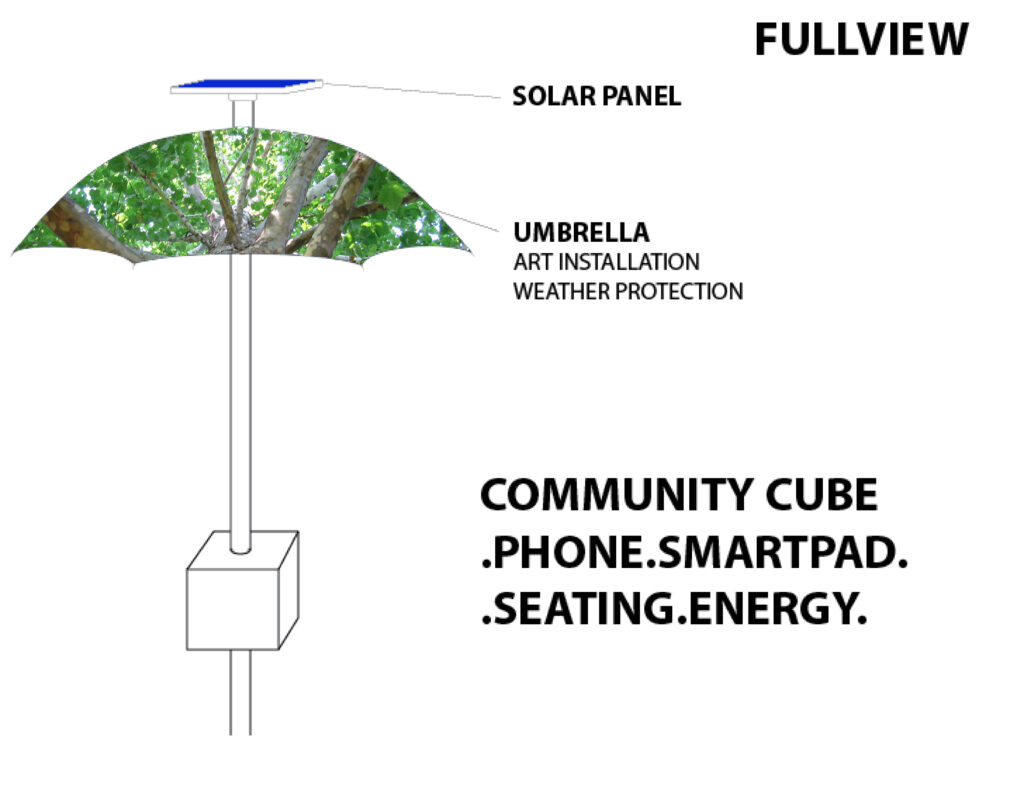
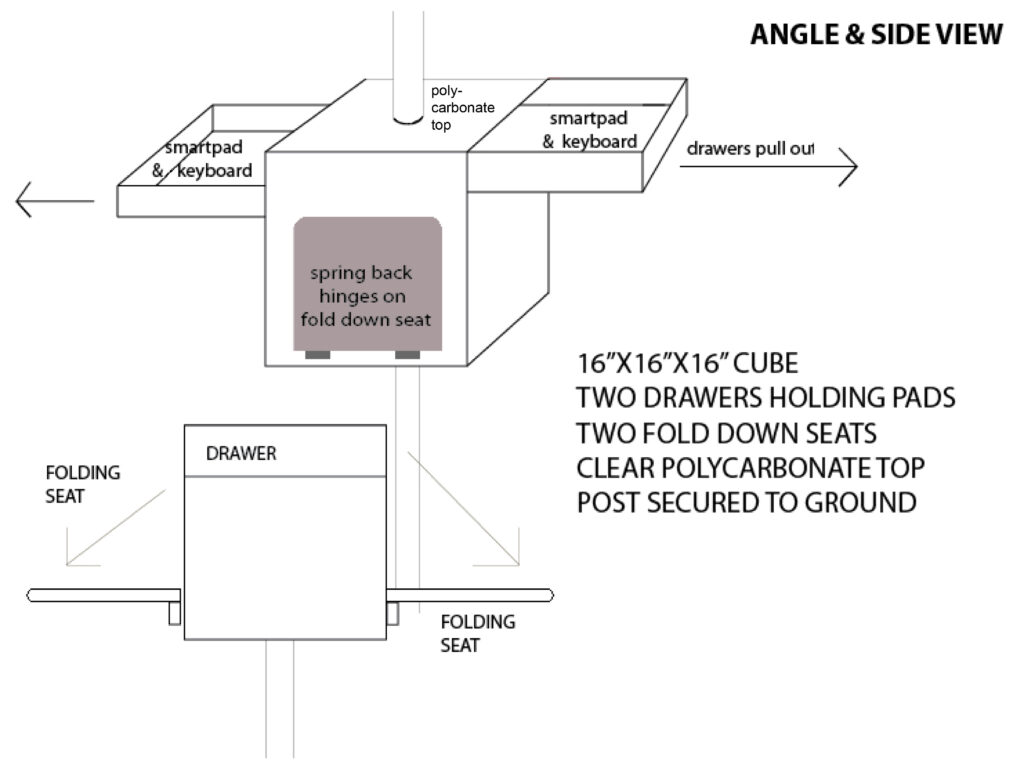

To the Prototype:
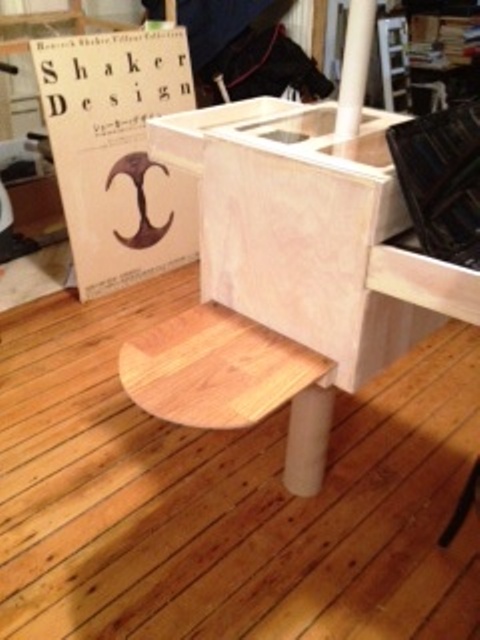
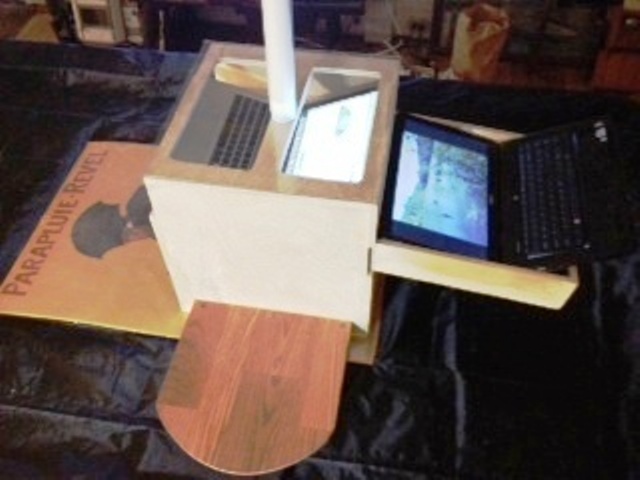
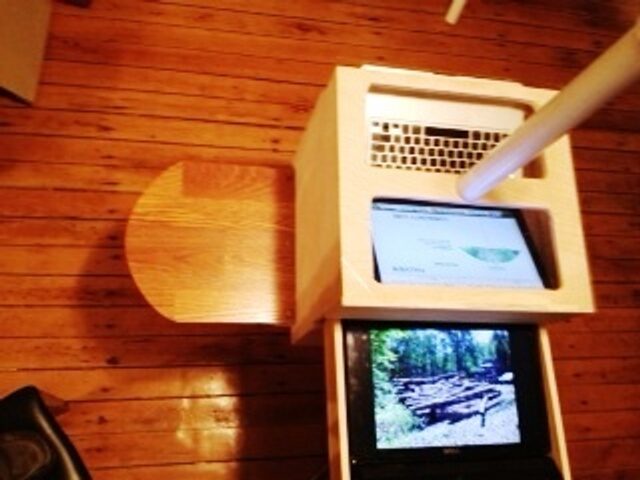
We are inviting designs to be submitted of new human-powered and electric-assisted human-scale vehicles including so-called “wheelchairs”. We are most interested in concepts that incorporate weather protection and passenger capacity but there are no limits on type or style, speed, or cost. Cargo bikes, recumbents, folders, wheelchairs, public transit i.e. shared, or convertible from commuter to commercial, Kinetic Sculpture, and Velomobiles, all are welcome. Pictures of existing machines will be featured and drawings and models and descriptions are fine too.
The second element of this endeavor has to do with the current conversations taking place relative to the definition of public space, the role of neighborhoods and their residents in that process, and advertising in this equation. At least minimal cover, an Umbrella-like object should be available to the public at practically every bus stop instead of only 25% of them. The proliferation of unique, attractive, and community-welcomed designs for these facilities, especially if produced and fabricated by local residents, could, most importantly, do much to help encourage a new level of healthy interactions among those living and working here, even just those passing through.
Images and text from individuals and groups are already being posted on SharingUmbrellas.org and will be updated regularly. Each person will be included in the slideshow which plays on the home page and provides a link to their own page. Some will also be printed, in a full-color tabloid, issued monthly to begin, in New York City and distributed to bike shops, bookstores, newsstands and cafes, and at gatherings of those most interested in these developments. Other local groups working on these issues who want to print their own local editions will be encouraged to do this.
One venue for showing off these devices will be New York City’s largest car-free space, Flushing Meadows/Corona Park in Queens. To help celebrate the 50th and 75th Anniversaries of the 1939 and 1964 World’s Fairs, in 2014 and 2015, this great public park will serve as a natural backdrop for the public unveiling of our human-scale transportation future. Craft, technology, and the creative imagination; sharing its most intriguing fruits; learning and being inspired; all the wonders of an event that consciously endeavors to be as inclusive geographically, culturally, and socially as possible, can help expedite the rapid evolution of this key feature in our environment, how we get around.
Health
Exercise
Walking
Around the block, as a starting point and to keep track
To nearby destinations for pleasure or utility
Historical/ Architectural/ Natural etc. tours given by local residents
Can include different speeds from relaxed to brisk up to running
Mild competition increases motivation but no racing
Also benefits safety
In case of an incident can seek or provide help
In numbers, there is little chance of trouble
More eyes on streets in general benefits all
Stretching
In the proximity of the location, without interfering with pedestrians
Somewhat protected in bad weather as long as there is an “Umbrella”
Can include guidance from a knowledgeable neighbor or online instructor
Tai Chi
Informal or guided includes other dance or movement methodologies
Biking
Shared vehicles and modest costs
Different style vehicles
Different age kids
Cargo and commercial
Cruisers
Electric-Assisted
Trikes
Special Need varieties
Multi-person
Measured distance trips to events, attractions, tours of every kind, etc.
For shopping, picking up kids, giving rides to friends, etc.
Commuting (can include machines used by others during the day)
Re-charge and lock-up aids and folders to expedite the availabilityScheduled discussions
Anyone can create a subject category and schedule a one-hour local conversation
Information is also available later online if archived
Can be “broadcast” to non-attendees via Skype if preferred by participants
Can be a private conversation among a small number of people
Cube doubles as a “Soapbox”
Charges for some services, others are freeMonitors and moderators-Blogs for Blocks
No age limit, 10 to 100, and cannot be small-minded or autocratic
Those already operating can be invited to be part of this network
Generating consensus is the goal, getting as close as possible is often enough
Local residents choose individual or multi-person units to “operate” Cube
Ground rules should be permissive but not abusiveAssociation with adjacent businesses, (at locations where they exist) provides:
Access to services
Power
Sanitation facilities
Help if needed
Storage
Reciprocal Aspect
Advertising
Goodwill
Backup personnel
Possible Investment
Professionals
Insurance
Finance
Accounting
Law
HealthSurvival Issues
Job Exchange
Help needed and available
Tutoring, educating, upgrading skills
Physical, moving of something
Coping issues
Painting
Repairs
Horticulture
Cleaning
Childcare
Transport
Health care
Research/writing
Shopping
Delivery
Tasks needing to be done
For Pay
Without monetary compensation
In exchange for…………system’s own currencyCelebrations
Birthdays
Pictures shown
Births
Presents Offered
Graduations
Listings
Anniversaries
Of local events as well as relationships
Achievements
Share the warmth, share the glory
Passing
Sad, but worth notingLife Histories
Includes contact information
Virtual resumes
Willingness to volunteers
Needs
Work
Personal
Help
Done by you, not about youNeighborhood History
Previous generations
Notorious
Early
Continuous
Grab it before it is done
CommercialPlantings
Existing
Possible
Cooperatively maintained
Native
Micro
EdiblesSoil conditions analysis performed
The spot itself can provide a location
The sidewalk around block=10 gardens
Artwork
Locally produced only
Constantly displayed
Rotating exhibits
Locked showcases and Virtual displays
Music and poetry-quietly and on demand
“Umbrella” itself is artEnclosing the space
Historical
Newsstands
Phone Booths etc.
Mixed Use by both volunteers and private interests
An adequate room must be provided for public uses
Permits expanded vending opportunitiesThe mechanism for registering sentiment on various issues
Questions posed
Creative suggestions invited
Results posted publicly
Setting up feedback loops





